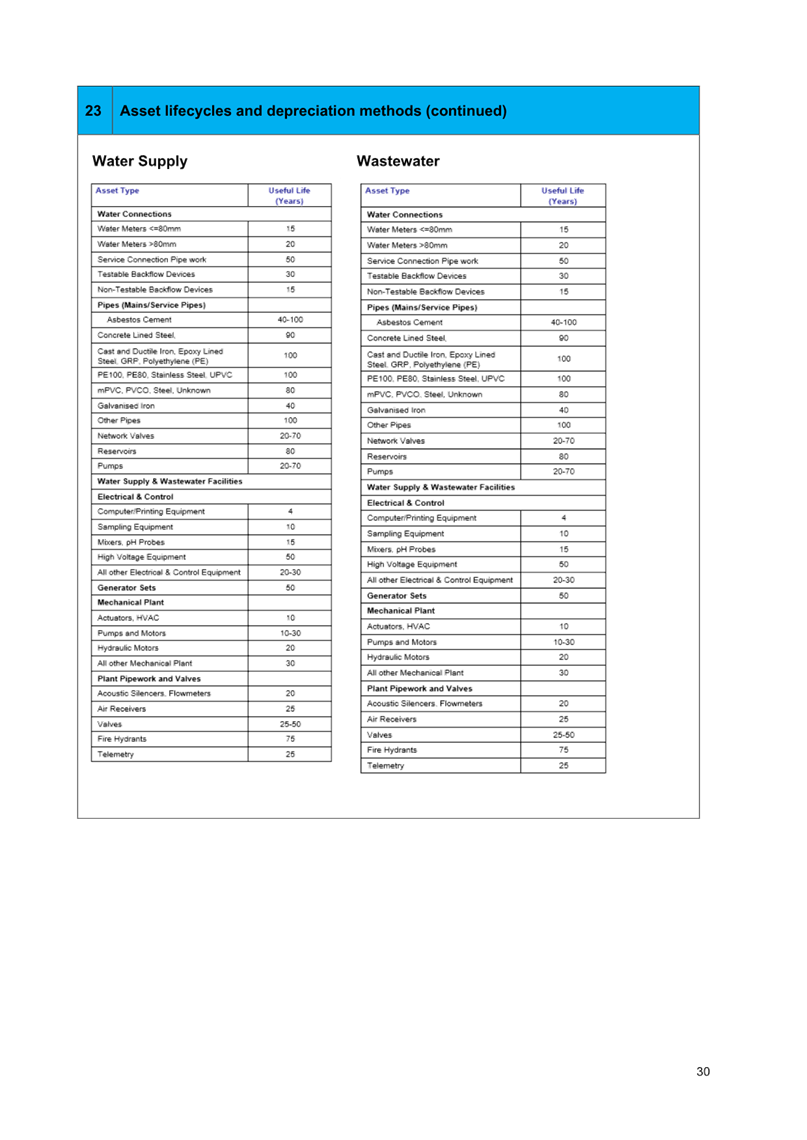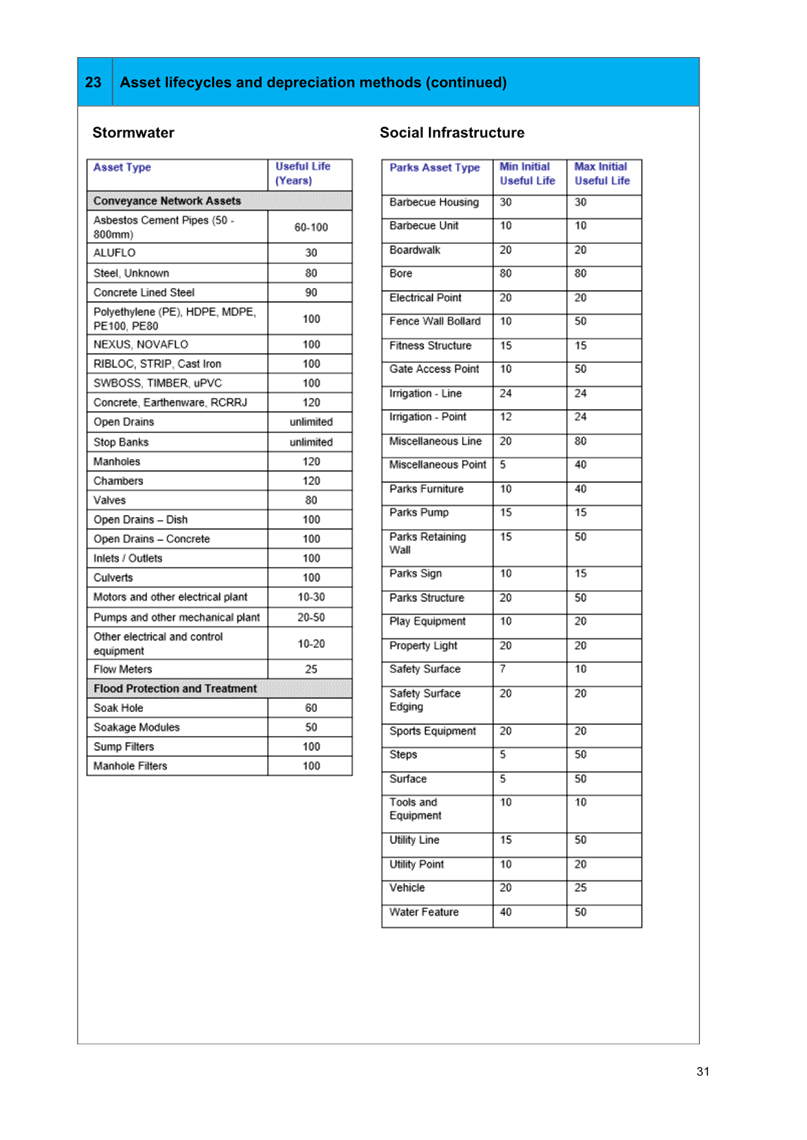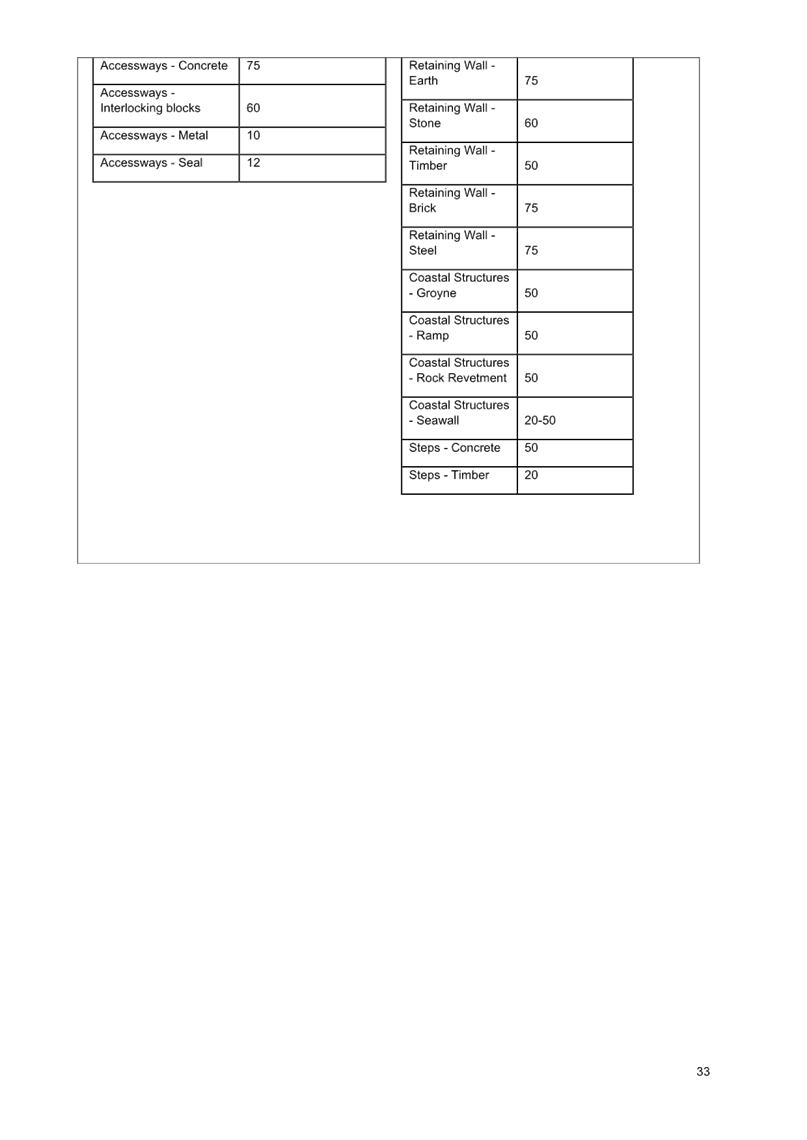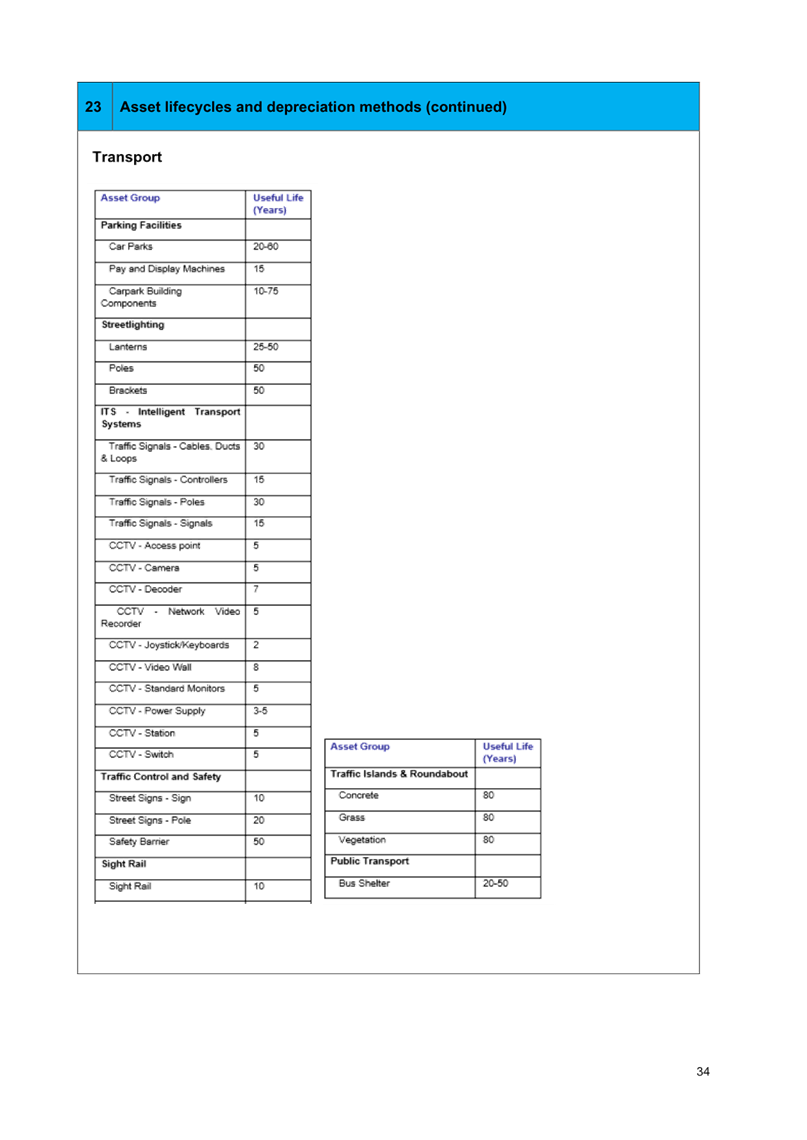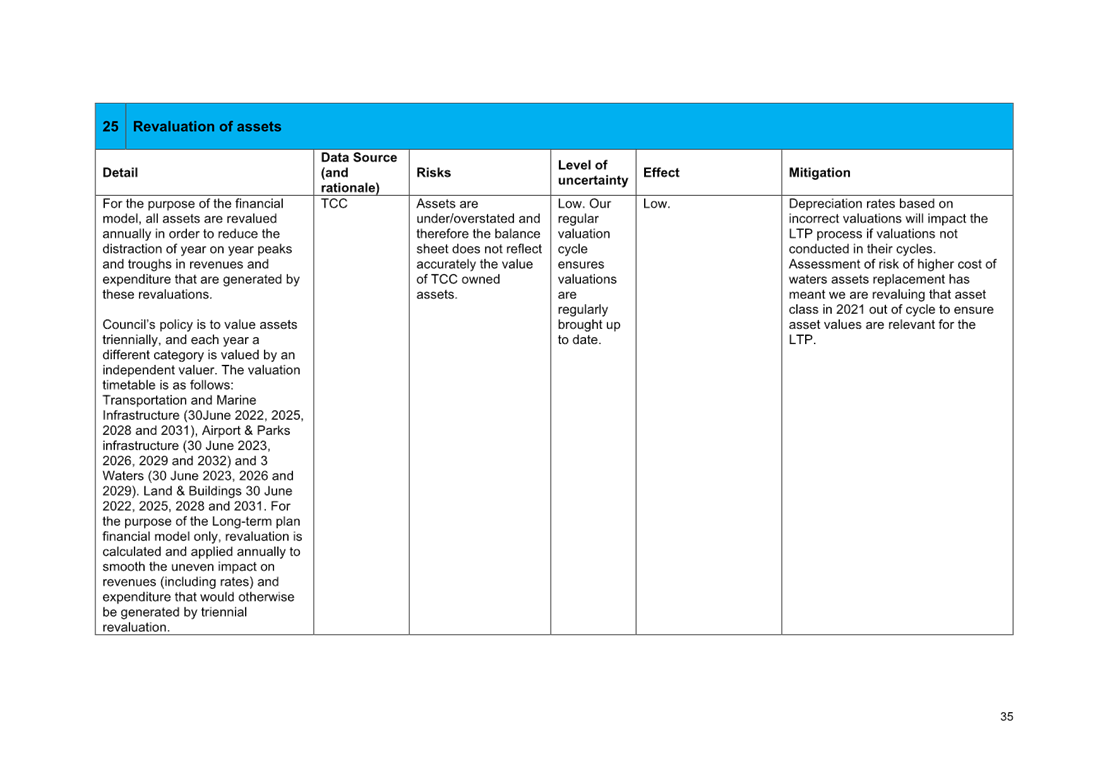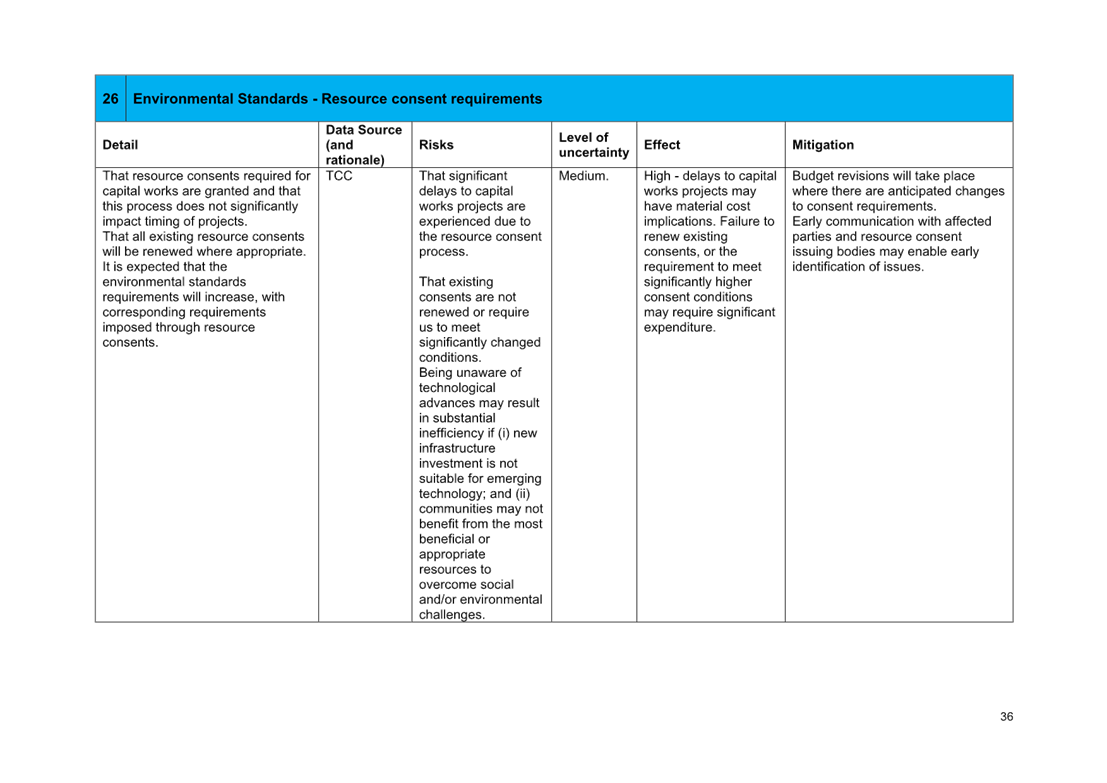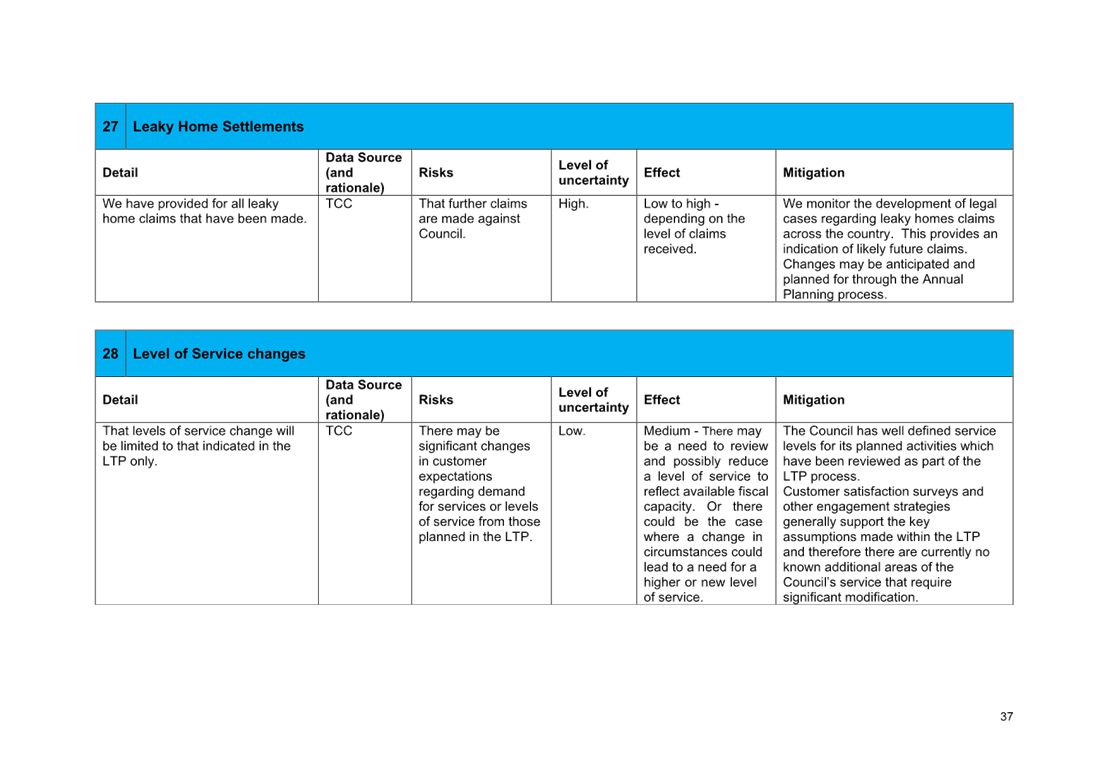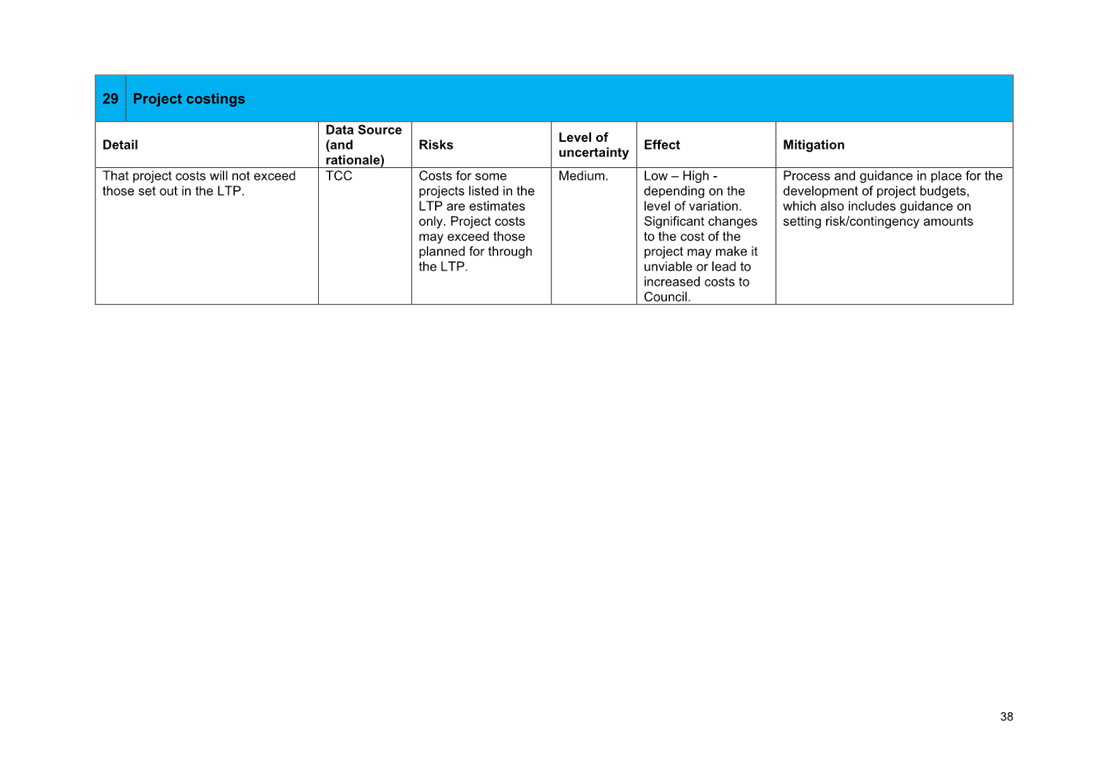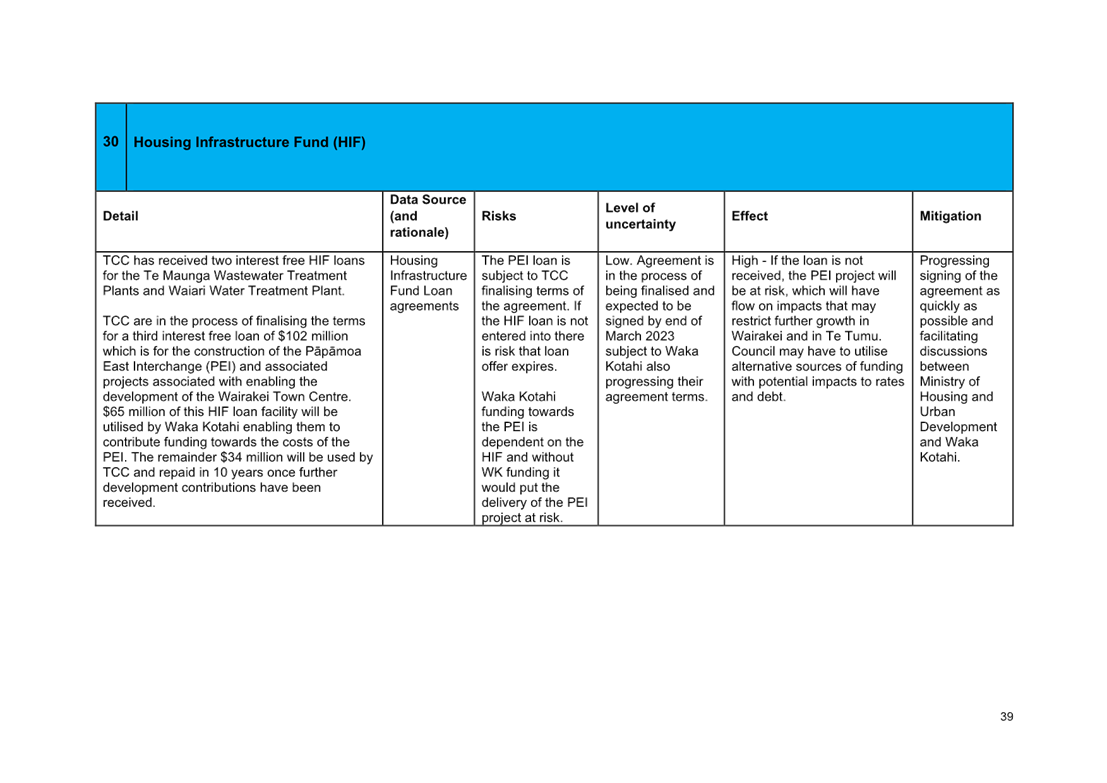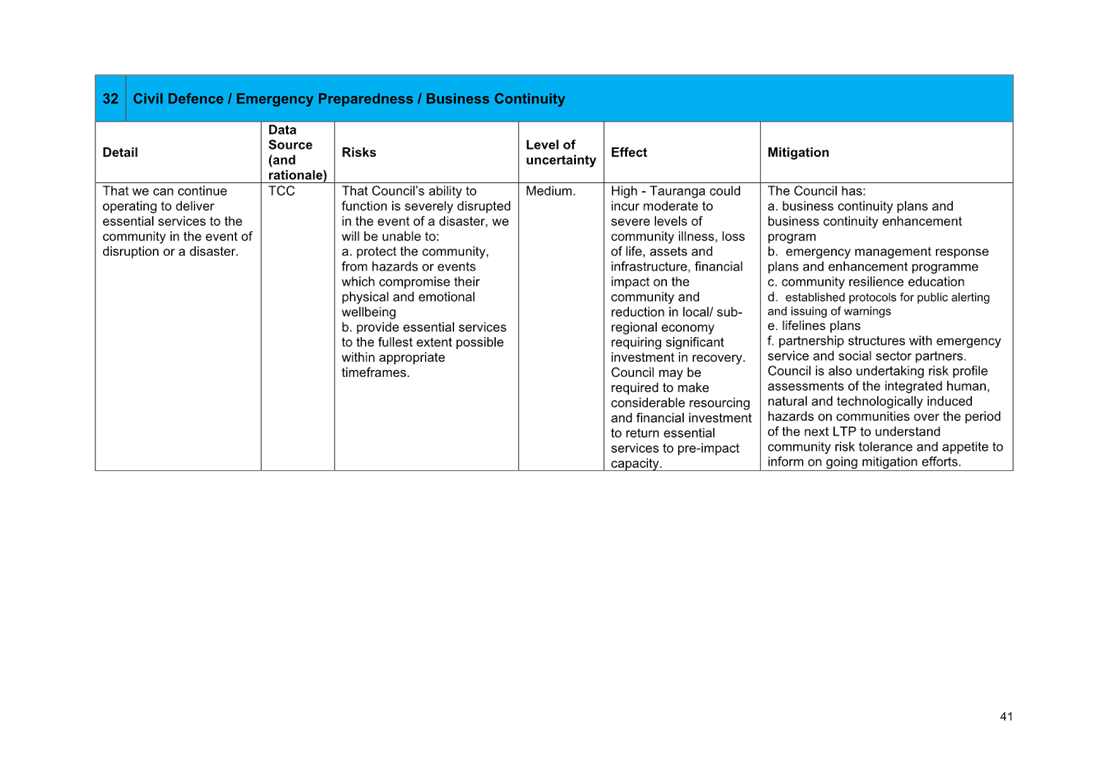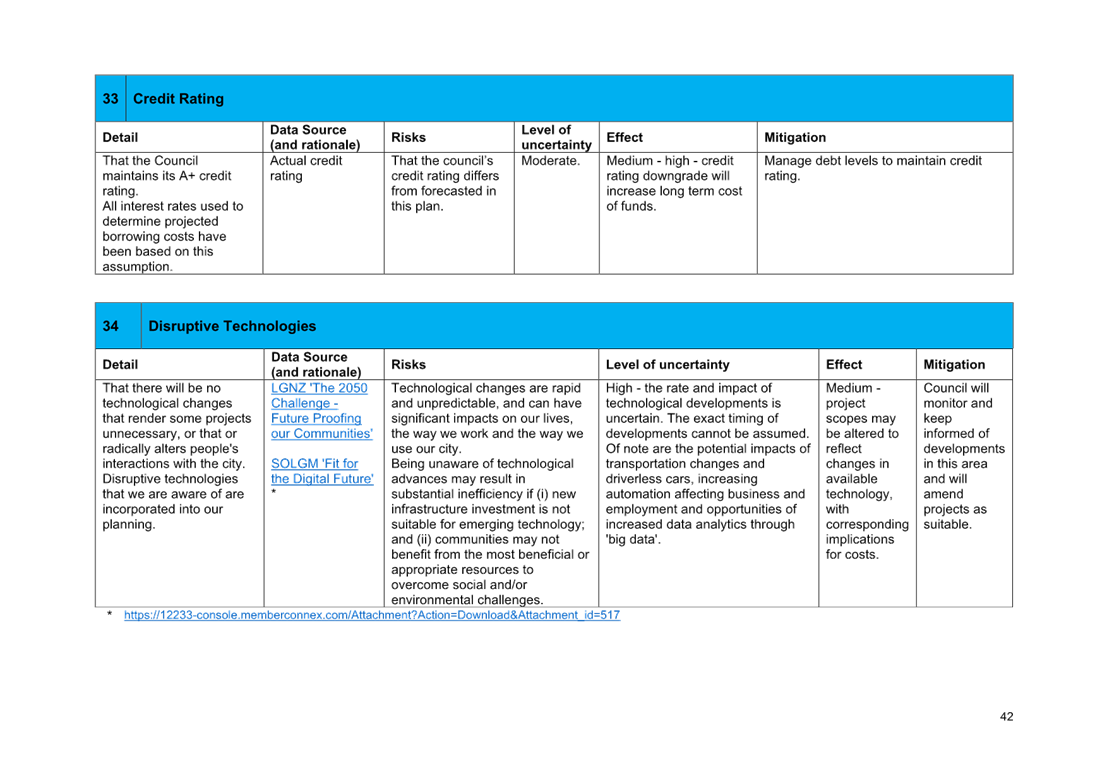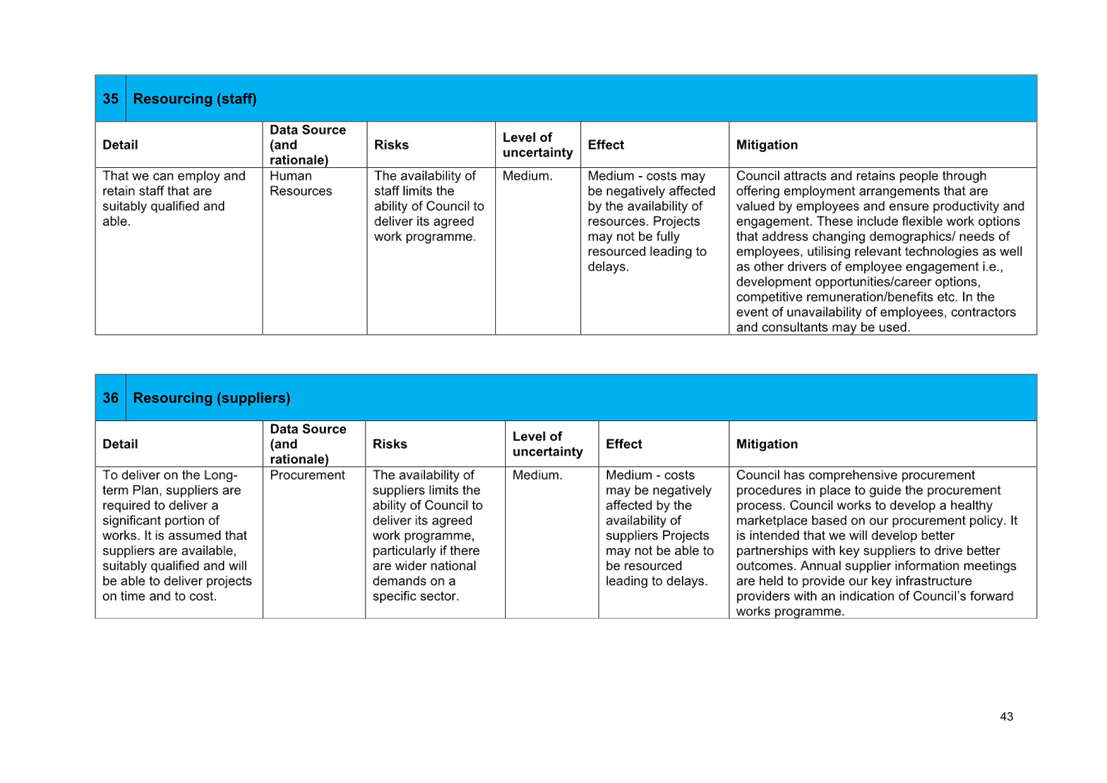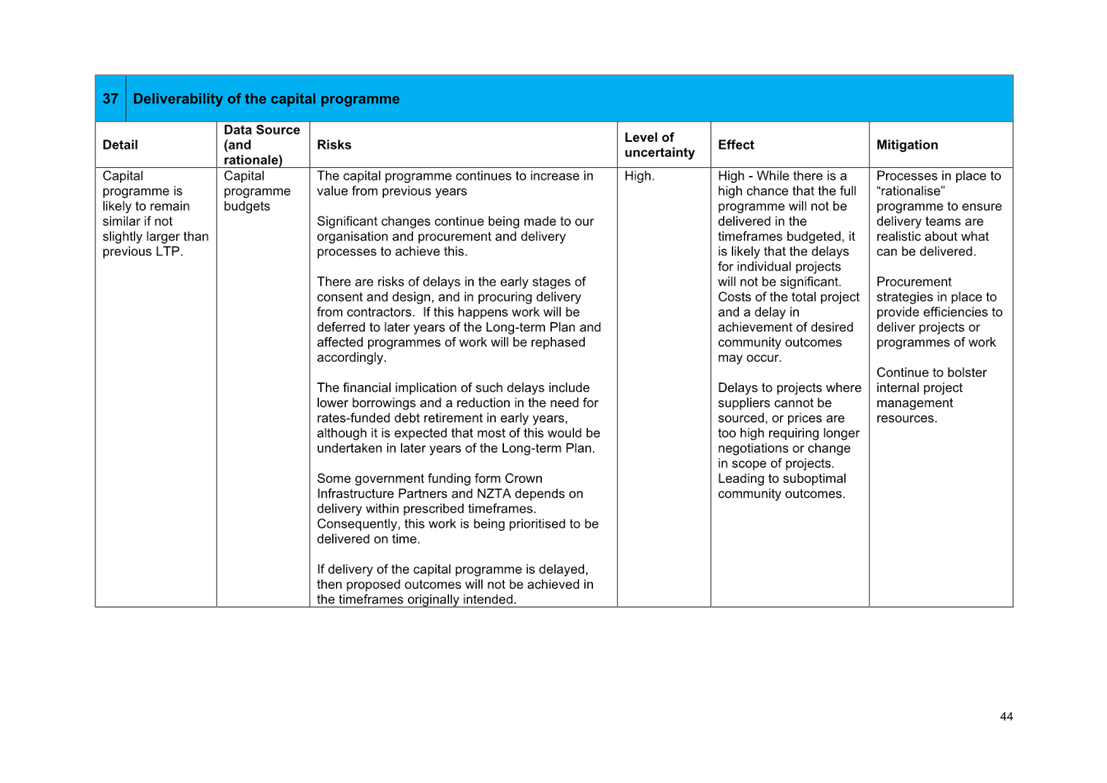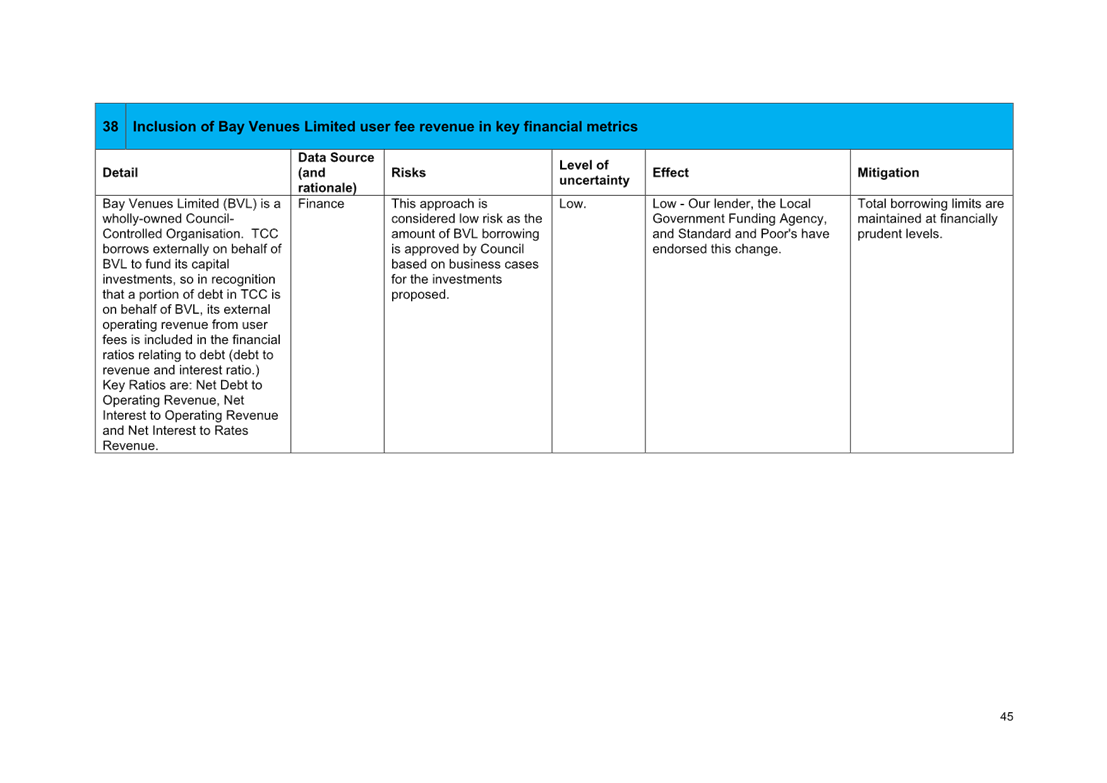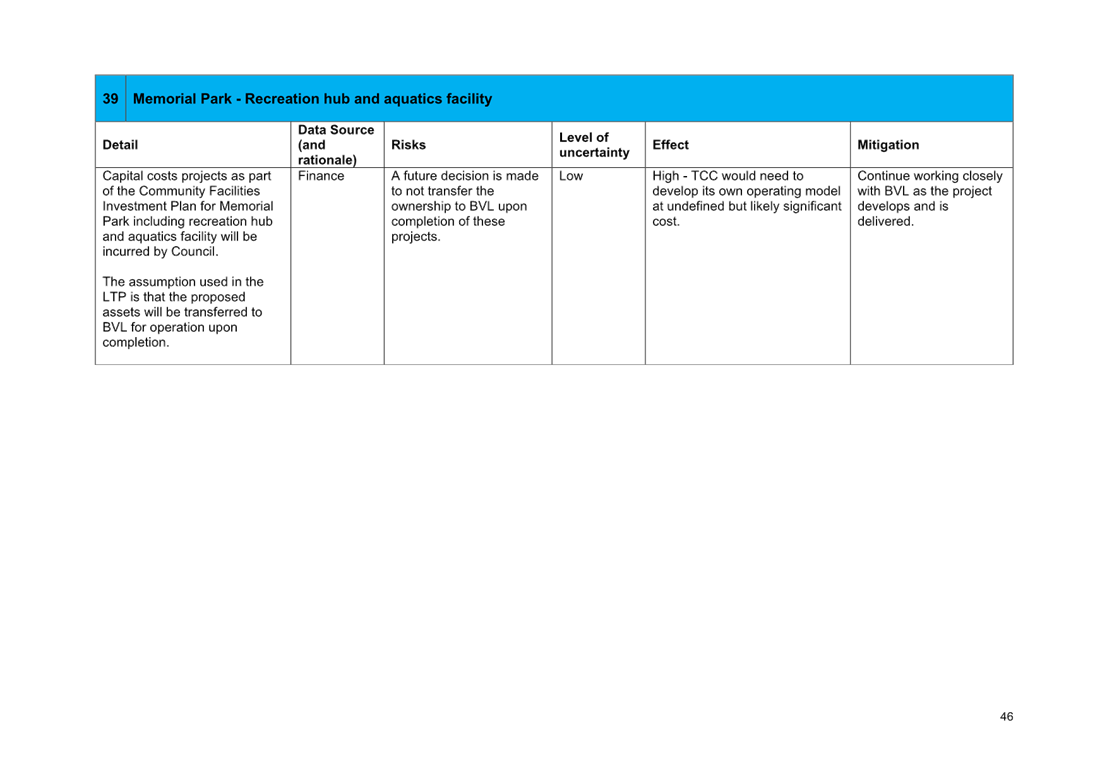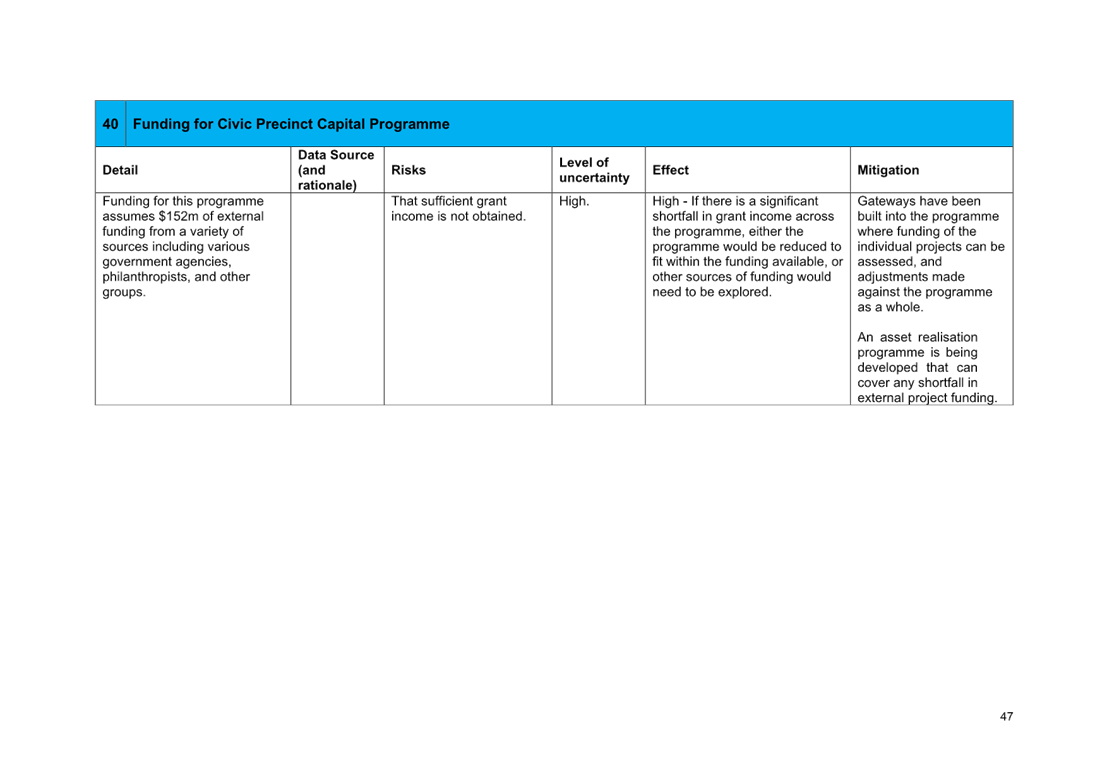|

|
|
AGENDA
Ordinary Council meeting
Monday, 27 February 2023
|
|
I hereby give notice that an Ordinary meeting of
Council will be held on:
|
|
Date:
|
Monday, 27 February 2023
|
|
Time:
|
9.30am
|
|
Location:
|
Bay of Plenty Regional Council Chambers
Regional House
1 Elizabeth Street
Tauranga
|
|
Please note that this
meeting will be livestreamed and the recording will be publicly available on
Tauranga City Council's website: www.tauranga.govt.nz.
|
|
Marty Grenfell
Chief Executive
|
Membership
|
Chairperson
|
Commission Chair Anne Tolley
|
|
Members
|
|
|
Quorum
|
Half
of the members physically present, where the number of members (including
vacancies) is even; and a majority of the members physically
present, where the number of members (including vacancies) is odd.
|
|
Meeting frequency
|
As
required
|
Role
·
To ensure the effective and
efficient governance of the City
·
To enable leadership of the City
including advocacy and facilitation on behalf of the community.
Scope
·
Oversee the work of all
committees and subcommittees.
·
Exercise all non-delegable and
non-delegated functions and powers of the Council.
·
The powers Council is legally prohibited from delegating include:
o
Power to make a rate.
o
Power to make a bylaw.
o
Power to borrow money, or purchase or dispose of assets, other
than in accordance with the long-term plan.
o
Power to adopt a long-term plan, annual plan, or annual report
o
Power to appoint a chief executive.
o
Power to adopt policies required to be adopted and consulted on
under the Local Government Act 2002 in association with the long-term plan or
developed for the purpose of the local governance statement.
o
All final decisions required to be made by resolution of the
territorial authority/Council pursuant to relevant legislation (for example:
the approval of the City Plan or City Plan changes as per section 34A Resource Management
Act 1991).
·
Council has chosen not to delegate the following:
o
Power to compulsorily acquire land under the Public Works Act
1981.
·
Make those decisions which are required by legislation to be made
by resolution of the local authority.
·
Authorise all expenditure not delegated to officers, Committees
or other subordinate decision-making bodies of Council.
·
Make appointments of members to the CCO Boards of
Directors/Trustees and representatives of Council to external organisations.
·
Consider any matters referred from any of the Standing or Special
Committees, Joint Committees, Chief Executive or General Managers.
Procedural matters
·
Delegation of Council powers to Council’s committees and
other subordinate decision-making bodies.
·
Adoption of Standing Orders.
·
Receipt of Joint Committee minutes.
·
Approval of Special Orders.
·
Employment of Chief Executive.
·
Other Delegations of Council’s powers, duties and
responsibilities.
Regulatory matters
Administration, monitoring and
enforcement of all regulatory matters that have not otherwise been delegated or
that are referred to Council for determination (by a committee, subordinate
decision-making body, Chief Executive or relevant General Manager).
|
Ordinary
Council meeting Agenda
|
27
February 2023
|
7 Confirmation
of minutes
7.1 Minutes
of the Council meeting held on 7 February 2023
File
Number: A14416833
Author: Robyn
Garrett, Team Leader: Governance Services
Authoriser: Robyn
Garrett, Team Leader: Governance Services
|
Recommendations
That the Minutes of the
Council meeting held on 7 February 2023 be confirmed as a true and correct
record.
|
Attachments
1. Minutes
of the Council meeting held on 7 February 2023
|
 Ordinary Council meeting Minutes Ordinary Council meeting Minutes
|
7 February 2023
|
|

|
|
MINUTES
Ordinary Council meeting
Tuesday, 7 February 2023
|
Order of
Business
1 Opening karakia. 3
2 Apologies. 3
3 Public forum.. 3
4 Acceptance of late items. 3
5 Confidential business to be transferred into the open. 3
6 Change to the order of business. 3
7 Confirmation of minutes. 4
7.1 Minutes of the Council meeting held on 12 December 2022. 4
8 Declaration of conflicts of interest 4
9 Deputations, presentations, petitions. 4
Nil
10 Recommendations from other committees. 4
10.1 Recommendation from other Committee - Strategy, Finance and Risk
Committee - 5 December 2022. 4
11 Business. 4
11.1 Proposed Dual Naming for Rotary Park and Ila Park. 4
11.2 Destination Skatepark - Update to Project Scope and Budget 6
11.3 Submission to Sale and Supply of Alcohol (Community Participation)
Amendment Bill 7
11.4 Bay of Plenty Mayoral Forum - Triennial Agreement 2022 - 2025. 8
11.5 Updated Meetings Schedule 2023. 8
11.6 Submission to Inquiry into 2022 Local Elections. 9
11.7 Emergency Management Response - January Weather Event 9
12 Discussion of late items. 10
13 Public excluded session. 10
13.1 Public Excluded Minutes of the Council meeting held on 12 December
2022. 11
13.2 Update on Maungatapu matters. 11
14 Closing karakia. 11
Resolutions transferred into the open section
of the meeting after discussion. 11
MINUTES OF Tauranga City Council
Ordinary Council meeting
HELD AT THE BoP Regional
Council Chambers, Regional House, 1 Elizabeth Street, Tauranga
ON Tuesday, 7 February 2023 AT
9.30am
PRESENT: Commission Chair Anne Tolley, Commissioner Shadrach Rolleston, Commissioner
Stephen Selwood, Commissioner Bill Wasley
IN ATTENDANCE: Marty
Grenfell (Chief Executive), Paul Davidson (Chief Financial Officer), Barbara
Dempsey (General Manager: Community Services), Nic Johansson (General Manager:
Infrastructure), Christine Jones (General Manager: Strategy, Growth &
Governance), Alastair McNeill (General Manager: Corporate Services), Sarah
Omundsen (General Manager: Regulatory and Compliance), Gareth Wallis (General
Manager: City Development & Partnerships), Nick Lynch-Watson (Open Space
& Community Facilities Planner); Ross Hudson (Team Leader: Planning), Emily
McLean (Programme Lead: City Development), Amanda Davies (Manager: Community
Amenity Programme Delivery); Jane Barnett (Policy Analyst), Nigel McGlone
(Manager: Environmental Regulation), Rob Lahey (Principal Strategic Advisor);
Coral Hair (Manager: Democracy & Governance Services), Robyn Garrett (Team
Leader: Governance Services), Sarah Drummond (Governance Advisor), Anahera
Dinsdale (Governance Advisor), Janie Storey (Governance Advisor)
1 Opening
Karakia
Commissioner
Shad Rolleston opened the meeting with a karakia.
2 Apologies
Nil
3 Public
forum
Nil
4 Acceptance
of late items
Nil
5 Confidential
business to be transferred into the open
Nil
6 Change
to the order of business
Nil
7 Confirmation
of minutes
8 Declaration
of conflicts of interest
Nil
9 Deputations,
presentations, petitions
Nil
10 Recommendations
from other committees
|
10.1 Recommendation from
other Committee - Strategy, Finance and Risk Committee –
5 December 2022
|
|
Staff Christine
Jones, General Manager: Strategy, Growth and Governance
|
|
Resolution CO1/23/2
Moved: Commissioner Stephen
Selwood
Seconded: Commissioner
Bill Wasley
That
the Council:
(a) Receives
the report Recommendation from other Committee - Strategy, Finance and Risk
Committee - 5 December 2022.
(b) Amends
the Strategy Finance and Risk Committee Terms of Reference (B2 Risk
Management) to reflect the decisions made in the revised Risk Management
Policy and remove ‘Framework and Strategy’ so they read ‘Review,
approve and monitor the implementation of the Risk Management Policy,
including the Corporate Risk Register’ with immediate effect.
Carried
|
11 Business
|
11.1 Proposed
Dual Naming for Rotary Park and Ila Park
|
|
Staff Barbara
Dempsey, General Manager: Community Services
Nick
Lynch-Watson, Open Space & Community Facilities Planner
Ross
Hudson, Team Leader: Planning
Emily
McLean, Programme Lead: City Development
External Tane
Bennett - Principal Maungatapu School
Kaida
Miharo - Senior student
Frankie
Te Kani - Senior student
Marlo
Ririnui - Senior student
Irene
Walker - Teacher
Key points
·
The students thanked the Council for the
opportunity to speak to the name change and noted that Rotary Park was
special to the school. Rotary Park was the local name, but to iwi it
was known as Ōpūpū as there was an abundance of pūpū - periwinkle shells at Rotary Park and mud snails in the
estuary.
·
A relative of one of the students, Marama
Rewiti Martin, was involved in opening of Rotary Park and was depicted in a
black and white photo at the time.
·
The kura and students used the park as a place
of studying and learning and presented a journal to the meeting which showed
the kura’s involvement in the area. Students had designed the mural
depicting a sea whale and different sea creatures. It was an area where
warriors and their tupuna would go to battle and rest up afterwards.
·
The group requested that the park be known as
Ōpūpū so that everyone could understand the cultural
significance and history of the site.
·
The students started their request in 2021
and, as some of the original students had left, the current group was
continuing their work towards the name change to complete the mahi.
·
Ms Walker noted that a big part of the naming
was the education around the names. The parks were well known for
younger people and families and could also be a place where they could be
educated. Part of the curriculum of schools would be to tell the
history, it was creating a space and helping the community to take care of
the environment. Both places had wetland restoration projects and were
places of knowledge about how to look after an area that was once a
swamp. These areas were a breeding ground and kai cupboard for iwi, but
were now depleted, with one of the reasons for depletion being city growth
and development. Iwi were at the Council table to constantly remind them
about the environment and were bringing the young people forward to do this.
In response to questions to the group and staff
·
There were not many pūpū left in
the area, they had been depleted over time.
·
There was a significant redevelopment occurring
at Ila Park and interpretation panels with the history of the area were
included in the design elements. Ila Park was expected to be reopened
by the end of March. There was also the same intention for signage and
information to be provided at Rotary Park.
·
Conversations had been held with remaining Ila
family members and they were in support of the redevelopment and dual
naming. They had indicated that they would attend the reopening in
March 2023.
Discussion points raised
·
The Rotary Club had signalled they were keen
to continue with the development of the park and this would be a good
programme for them to become involved in.
·
The students were thanked for coming to
present to the meeting. Council appreciated their input and Commissioners
noted the importance of the Council and the community being able to
understand the history of each of these areas.
|
|
Resolution CO1/23/3
Moved: Commissioner Shadrach
Rolleston
Seconded: Commissioner
Stephen Selwood
That
the Council:
(a) Receives
the report "Proposed Dual Naming for Rotary Park and Ila Park".
(b) Approves
the name “Ōpūpū” to be added to Rotary Park as a
dual name. The full reserve name will be Ōpūpū – Rotary
Park.
(c) Approves
the name “Te Papa Tākaro o Tongaparaoa” to be added to Ila Park
as a dual name. The full reserve name will be Te Papa Tākaro o
Tongaparaoa – Ila Park.
Carried
|
|
11.2 Destination
Skatepark - Update to Project Scope and Budget
|
|
Staff Barbara
Dempsey, General Manager: Community Services
Amanda
Davies, Manager: Community Amenity Programme Delivery
Key points
·
The scope of the original budget required 50%
external funding to progress, 62% external funding had been secured so Option
B was able to proceed.
·
The updated budget for Option B required an
additional $375,000 to be funded over 2 financial years.
In response to questions
·
Regarding being able to work within the budget
available rather than seeking additional funding, it was noted that the
funding was to provide a contingency for the project and to allow the park to
offer a wider variety of skate experiences.
·
Access across Maunganui and Hull Roads and
carparking on site would be provided through the redevelopment of Blake Park
and a signalised crossing would be installed.
·
Staff were currently working extensively on
the consenting options which would include having consents in place for
future development. Some work would be able to commence to provide
power, water and fencing on the site.
·
Shade would be provided through the
installation of shade sails and the retention of the large trees.
Skaters had indicated that they would rather have the flow bowl than a
covered skating area, so further shade would be considered within the future
development plans.
Discussion points raised
·
A good outcome had been achieved in terms of
the level of investment from external funders, and the good active
participation from users was noted and commended.
·
Commissioners had been signalling the
challenging LTP constraints, and it was queried whether there was enough
communication and understanding within the community on the cost implications
of projects and the onus of additional funding being put back onto
them.
|
|
Resolution
CO1/23/4
Moved: Commissioner Shadrach
Rolleston
Seconded: Commissioner
Bill Wasley
That
the Council:
(a) Receives
the report “Destination Skatepark – Update to Project Scope and
Budget”.
(b) Approves
the updated project scope to proceed with construction of Option B.
(c) Approves
an updated project budget for the construction of Option B of $3,610,081, which includes 62% external
funding to a value of $2,211,217.
(d) Approves
a council contribution of $1,398,863.76. This includes an additional
Council contribution of $375,863 for project contingency to deliver Option B.
(e) Approves
the allocation of the updated total project budget to the following financial
years - $1,083,024.36 for FY 23 and $2,527,056.83 for FY 24
Carried
|
|
11.3 Submission
to Sale and Supply of Alcohol (Community Participation) Amendment Bill
|
|
Staff Sarah
Omundsen, General Manager: Regulatory and Compliance
Jane
Barnett, Policy Analyst
Nigel
McGlone, Manager: Environmental Regulation
Key points
·
Public submissions were due on the Bill by 12
February 2023. The bill was aimed at giving local communities more of a
say with regards to the issuing of liquor licences.
In response to questions
·
The proposed legislation removed all
opportunities for appeal and provided a greater opportunity for community
participation.
·
Objections would be considered in light of
where objectors were from e.g. from local communities and individuals or
wider national interest groups.
·
Current legislation had been interpreted
narrowly to require that someone must have a greater interest in an
application than the public to participate e.g. live within 1-2 km. If
they did not live in the area they did not have a voice, the proposal made it
possible for anyone that felt they were impacted by the licence to become
part of the process.
·
There was no change to the application
notification or engagement at the beginning of the application process.
This had been raised in consultation on the draft TCC Local Alcohol Policy
and staff were to go above the legislative requirement to ensure early
notification occurred.
·
The removal of the right to a cross
examination where no party could ask questions of other parties needed to be
made clearer. There was still a need for some questioning and provision
to do so should be included in the legislation in some format without making
the parties feel uncomfortable.
Discussion points raised
·
Commissioners amended the proposed resolution
to allow further points to be added to the submission and to approve it
retrospectively at the next meeting.
·
The draft bill presented a lot of conflicting
information which District Licensing Committees would need to make decisions
on, and added a level which did not address the actual problem of excess
alcohol usage. Any person wanting access to alcohol would find it.
·
It seemed to be a large process where no one
would end up satisfied - the proposal tended to make it worse and could
result in an increased cost to Council.
·
It was requested that these reservations be
provided at the start of the submission and to ask the Select Committee
whether the new measures proposed would make a difference to the problem of
alcohol abuse.
|
|
Resolution CO1/23/5
Moved: Commissioner Bill
Wasley
Seconded: Commissioner
Shadrach Rolleston
That
the Council:
(a)
Receives the report "Submission to Sale
and Supply of Alcohol (Community Participation) Amendment Bill".
(b)
Updates the submission to include further
comments from the Commissioners prior to being submitted to the Justice
Select Committee, and brings the submission back to Council at the next
meeting for retrospective ratification.
(c) Notes
that a report to the Strategy, Finance and Risk Committee will recommend that
decisions on the revised draft Local Alcohol Policy be delayed until after
the Amendment Act comes into force.
Carried
|
|
11.4 Bay
of Plenty Mayoral Forum - Triennial Agreement 2022 - 2025
|
|
Staff Christine
Jones, General Manager: Strategy, Growth and Governance
Rob
Lahey, Principal Strategic Advisor
|
|
Resolution CO1/23/6
Moved: Commissioner Bill
Wasley
Seconded: Commissioner
Stephen Selwood
That
the Council:
(a) Receives
the report "Bay of Plenty Mayoral Forum - Triennial Agreement 2022 -
2025".
(b) Endorses
the proposed Triennial Agreement, provided in Attachment 1.
(c) Authorises
the Commission Chair to sign the Triennial Agreement on behalf of Tauranga
City Council.
Carried
|
|
11.5 Updated
Meetings Schedule 2023
|
|
Staff Christine
Jones, General Manager: Strategy, Growth and Governance
Coral
Hair, Manager: Democracy & Governance Services
Key points
·
The Tauranga Public Transport Joint Committee
meetings had been included and the annual plan hearings and deliberations had
been removed.
In response to questions
·
Discussions would be held within the next week
to discuss the Long-term Plan process and would be reported with a timeline
to the next meeting.
·
Meetings held on a Friday were generally joint
committee meetings organised by BOPRC.
·
BOPRC Public Transport, SmartGrowth, Metro and
Upper North Island meetings were to be added.
|
|
Resolution CO1/23/7
Moved: Commissioner Bill
Wasley
Seconded: Commissioner
Stephen Selwood
That
the Council:
(a) Receives
the report "Updated Meetings Schedule 2023".
(b) Adopts
Attachment 1 as the meetings schedule for the period January to December
2023.
Carried
|
|
11.6 Submission
to Inquiry into 2022 Local Elections
|
|
Staff Christine
Jones, General Manager: Strategy & Growth
Coral
Hair, Manager: Democracy & Governance Services
Discussion points raised
·
Commissioners amended the proposed resolution
to allow further points to be added to the submission and to approve it
retrospectively at the next meeting.
|
|
Resolution CO1/23/8
Moved: Commission Chair Anne
Tolley
Seconded: Commissioner
Bill Wasley
That
the Council:
(a)
Receives the report "Submission to
Inquiry into 2022 Local Elections".
(b)
Updates the submission to include further
comments from the Commissioners prior to being submitted to the Justice
Select Committee and brings the submission back to Council at the next
meeting for retrospective ratification.
Carried
|
|
11.7 Emergency
Management Response - January Weather Event
|
|
Staff Barbara
Dempsey, General Manager: Community Services
Key points
·
A navigator had been appointed and was
wrapping around the families that had been affected by slips and flooding.
·
A project team was investigating what needed
to be done to clear the site and were awaiting a Geotech report.
·
The ground needed to dry out prior to the work
being carried out. Staff were keeping a watch on the weather which may delay
the clean-up.
·
The team was working closely with the
insurance parties involved.
·
Noted that many of the team members turned up
following the event and got on with the job working long hours. Some
staff on annual leave came into work to assist.
In response to questions
·
The $150m invested by the previous Council in
stormwater projects and infrastructure changes had assisted with coping with
the heavy rainfalls. An investigation would be undertaken to determine
how they had coped, to understand the volumes and flows involved, and see if
the infrastructure had functioned as expected and whether there were any
gaps. A report would be provided to Council when this had been
completed.
·
Staff were still to determine how many of the
slips were on public and private land. The insurance implications would
need to be considered on private land and, once known, the situation would be
assessed.
·
Council had a detailed and robust contract
with the concert group which used the Tauranga Domain, which included
penalties for damage to the park. While this may cover the financial
cost, the regular sporting codes would not be able to use the fields for a
while. The hirer had set up the stage and sound but could not cancel
the concert until their insurance clause was activated. They then
needed to remove the gear for their next gig and did so while the ground was
still sodden.
Discussion points raised
·
The Commissioners congratulated staff on doing
an amazing job to make sure damage from the storm was minimised and all systems
were working. They asked that their appreciation be passed on to all
staff concerned.
·
Credit was given to past councils for making
good decisions in stormwater, drinking water and wastewater investment.
|
|
Resolution CO1/23/9
Moved: Commissioner Bill
Wasley
Seconded: Commissioner
Stephen Selwood
That
the Council:
(a) Receives
the report "Emergency Management Response - January Weather Event".
Carried
|
12 Discussion
of late items
Nil
13 Public excluded session
RESOLUTION
TO EXCLUDE THE PUBLIC
|
Resolution
CO1/23/10
Moved: Commissioner Shadrach
Rolleston
Seconded: Commissioner
Bill Wasley
That
the public be excluded from the following parts of the proceedings of this
meeting.
The
general subject matter of each matter to be considered while the public is
excluded, the reason for passing this resolution in relation to each matter,
and the specific grounds under section 48 of the Local Government Official
Information and Meetings Act 1987 for the passing of this resolution are as
follows:
|
General subject of each
matter to be considered
|
Reason for passing this
resolution in relation to each matter
|
Ground(s) under section 48
for the passing of this resolution
|
|
13.1 - Public Excluded
Minutes of the Council meeting held on 12 December 2022
|
s7(2)(b)(ii) - The withholding of the
information is necessary to protect information where the making available
of the information would be likely unreasonably to prejudice the commercial
position of the person who supplied or who is the subject of the
information
s7(2)(i) - The withholding of the
information is necessary to enable Council to carry on, without prejudice
or disadvantage, negotiations (including commercial and industrial
negotiations)
|
s48(1)(a) - the public conduct of the
relevant part of the proceedings of the meeting would be likely to result
in the disclosure of information for which good reason for withholding
would exist under section 6 or section 7
|
|
13.2 - Update on Maungatapu
matters
|
s7(2)(a) - The withholding of the
information is necessary to protect the privacy of natural persons,
including that of deceased natural persons
|
s48(1)(a) - the public conduct of the
relevant part of the proceedings of the meeting would be likely to result
in the disclosure of information for which good reason for withholding
would exist under section 6 or section 7
|
Carried
|
14 Closing
Karakia
Commissioner
Shad Rolleston closed the meeting with a karakia.
The
meeting closed at 11.02 am.
The
minutes of this meeting were confirmed as a true and correct record at the
Ordinary Council meeting held on 27 February 2023.
........................................................
CHAIRPERSON
|
Ordinary
Council meeting Agenda
|
27
February 2023
|
11 Business
11.1 Bay
Venues User Fees Review and Office Refurbishment
File
Number: A14412950
Author: Sanjana
France, CCO Specialist
Anne Blakeway,
Manager: City Partnerships
Authoriser: Paul
Davidson, Chief Financial Officer
Purpose of the Report
1. The purpose of this report
is to present Bay Venues proposed draft user fees and charges schedule for
Council to adopt as a draft for public consultation. This report also presents
Bay Venues proposal to reallocate existing budgets for an office refurbishment
at Baypark Stadium.
|
Recommendations
That the Council:
(a) Receives
the Bay Venues User Fees Review and Office Refurbishment report.
(b) Adopts
Bay Venues’ draft user fees and charges proposal as set out in Option 1
of Attachment 1, as a draft for public consultation, incorporating any
amendments as directed by Council at this meeting.
(c) In
addition, approves an increase of $600,000 to the Bay Venues annual operating
subsidy (above the normal CPI increase).
(d) Approves
the reallocation of Bay Venues capital budget to fund the support office
refurbishment, noting that this project has been approved by the Bay Venues
Board and is in alignment with the Baypark Masterplan.
(e) Approves
additional rates funding of $186,000 per annum to cover depreciation and
interest costs associated with the Baypark office refurbishment.
|
Executive Summary
User Fees Review
2. Bay
Venues has undertaken a review of user fees across the funded network,
including all facilities that are subsided by the council operating grant.
3. Bay
Venues is seeking approval to increase user fees to broadly align with the
national benchmark, as outlined in the pricing review provided at Attachment 1.
This report provides recommendations and context on Bay Venues’ proposal.
Office Refurbishment
4. Bay
Venues support staff are currently spread across multiple areas within Baypark
and other external sites, including Baywave. Bay Venues are seeking approval to
proceed with an office refurbishment, using their existing budget for other Baypark
Stadium projects, including repairs to the stadium roof lining, that are not
required in the short to medium term.
5. It
should be noted that this is the first stage of resolving the issues
highlighted in the recent Strategic Review of Bay Venues. There is further work
to be done through the Long-term Plan 2024-2034 process in relation to capital
investment, depreciation and renewals to ensure a sustainable funding and
financing model. A report will come to Council before June 2023.
Background
User
Fees Review
6. Bay
Venues commissioned RSL (Recreation Sport Leisure Consultancy) to review user
fees in the funded network against a national benchmark (comprising seven other
New Zealand cities). The RSL Pricing Comparisons report is provided at Attachment
2.
7. The
review has concluded that current user fees are between 27% - 90% of the
national benchmark (excluding Baywave, which is slightly ahead of benchmark).
Typical comparisons to the national benchmark are provided
in the table below (all prices include GST):
|
|
Aquatics
|
Indoor Courts
|
Community Halls
|
Community Centres
|
|
|
Adult Greerton
|
Youth/Senior
Community Trustpower Arena
|
Adult Community
Bethlehem Hall
|
Yth/Sen Community XL
Room
|
|
Bay Venues current user
fee
|
$2.60
|
$24.90
|
$19.40
|
$21.50
|
|
Current % of national
benchmark
|
63%
|
49%
|
66%
|
61%
|
|
Comparisons with
other cities:
|
|
Wellington
|
$3.40
|
$64.00
|
$19.00
|
$30.00
|
|
Hamilton
|
$4.00
|
$44.00
|
$35.00
|
$40.00
|
|
Christchurch
|
$4.50
|
|
$15.30
|
$25.00
|
|
Pukekohe
|
$2.70
|
|
|
|
|
Auckland
|
$5.00
$4.30
|
$50.00
|
$26.00
$53.00
|
$28.80
$40.80
|
|
Dunedin
|
|
$22.50
|
$20.00
|
|
|
Lower Hutt
|
|
$75.00
|
$24.00
|
|
8. In
some areas of the user fees review, Bay Venues identified that the national
benchmark did not reflect the standard of the facilities or felt it would
significantly impact affordability. Where this is the case, the recommended
user fee has been reduced to reflect the standard of the facility and perceived
affordability.
Office Refurbishment
9. Bay Venues currently have over 350 staff. Staff numbers are
roughly evenly split between full time, part time and casual staff with around
90 full time staff based at Baypark. Of the staff based at Baypark,
approximately 50 are office-based and not directly customer-facing.
10. Bay
Venues believes there is a pressing need to co-locate
teams that are currently dispersed across multiple sites (Baypark and
Baywave) in multiple office locations (more than 10 small and disconnected
office areas). This is a barrier to teams connecting and communicating easily,
a matter raised in staff engagement survey results.
11. A
detailed business case, along with photos showing the current state of offices,
are provided at Attachment 3.
Strategic / Statutory Context
12. As
a council-controlled organisation, Bay Venues is required to operate in a
financially prudent manner and is intended to produce an operating surplus. Bay
Venues’ purpose is to provide a service to the community on behalf of
Council, rather than to operate a business for profit. The predominant
strategic driver for Bay Venues is “maintaining and enhancing
accessibility for all”.
13. Bay Venues operates under an Enduring
Statement of Expectations (ESE) with Council. The ESE identifies the purpose of
Bay Venues as:
“Bay
Venues exists to care for and optimise community facilities to create value for
Tauranga City and enhance the quality of life of its people, now and into the
future”.
14. It
is expected that the operating surplus generated by the more commercially
focussed activities in the network will go some way towards offsetting the
potential deficit generated by the commercial activities.
15. To
aid the desired outcomes of the Baypark Master Plan, the proposed office
upgrade will future proof the building and, should it be decided in future that
appropriate Bay Venues staff are moved elsewhere (e.g. co-located with Council
staff at 90 Devonport Road), part or all of the offices could be made available
to community organisations or leased out commercially to generate an income.
Options Analysis - Pricing
review and office refurbishment
16. Bay
Venues’ options analysis provided in Attachment 1 considers the two scenarios
to increase their user fees, along with the relative advantages and
disadvantages of each option.
17. Bay Venues’
options analysis provided in Attachment 3 considers the scenarios for their
office refurbishment, along with the relative advantages and disadvantages of
each option.
Financial Considerations
18. Bay Venues’
operating costs have increased significantly over the last three years, while
the ability to increase operating revenue has been limited by:
(a) An inability
to increase volume due to capacity restrictions, particularly at major sites
such as Baywave, Trustpower Arena, and the Mount Hot Pools, which are close to
full capacity; and
(b) The impact of
COVID and the direction of previous Councils has resulted in an inability to
increase user fees by anything other than the usual CPI increases (maximum 5%.)
19. Bay Venues has a
current operating deficit of $1.6 million per year. To remain financially
sustainable Bay Venues needs to return to at least breakeven position, which
they can do through a mix of price increases and an increase to the annual
operating subsidy from Council.
20. It should be noted
that the proposed increase of $600,000 to Bay Venues’ annual operating
subsidy is in addition to the remuneration alignment increase of $336,000
already approved by Council in 2022. TCC will manage the increased rates
requirement within the parameters of the Long-term Plan 2024-2034.
21. The 2023 FY budget was for stadium main
lights, stadium roof ceiling and stadium paint finishes with some additional
ancillary budget.
· Stadium lights budget is still required, with $1
million needing to be carried forward into FY2023/24.
· Some paint work will be undertaken, stadium roof
not currently a priority, the main areas of concern from a health and safety
perspective have been remediated.
· Reallocate $1.35 million of the remaining $1.495
million to the office refurbishment.
|
New Capital
|
FY2023 Budget
|
FY2023 Forecast
|
FY2024 Carry forward
|
Comments
|
|
New Capital projects under
$200k
|
$1,000,000
|
$1,000,000
|
|
$700,000 spent to date
|
|
Baypark Inc Pavilions and
Stadium
|
$2,495,778
|
$1,495,778
|
$1,000,000
|
See para 19 above
|
|
New Capital Total
|
$3,495,778
|
$2,495,778
|
|
|
|
Design and fees 3%
|
$104,873
|
$104,873
|
|
|
|
NEW CAPITAL TOTAL
|
$3,600,652
|
$2,600,652
|
$1,000,000
|
|
22. Assuming a 10-year
useful life of the Baypark office refurbishment, additional rates funding of
$186,000 will required from FY2024 onwards to cover $135,000 per annum
depreciation and $51,000 per annum additional interest grant funding.
23. Bay Venues’ comparative analysis of the financial return on investment
of the project is provided in the below table on the basis that the office
spaces were leased at a fair market commercial rate at some stage in the
future. Any non-commercial arrangements would impact the return on investment
(ROI).
|
Description
|
|
|
Office Upgrade Cost
|
$1,350,000
|
|
Potential Revenue -
Existing office space freed up by relocating staff (annual lease at $200/m2)
|
$40,000
|
|
Potential Revenue - If
Bay Venues vacate redeveloped offices in future (annual lease @ $400/m2)
|
$200,000
|
|
Total Potential Revenue
|
$240,000
|
|
Assumed ROI (based on
total potential revenue)
|
18%
|
|
Assumed Payback Period
(excluding debt servicing and depreciation)
|
5.6 years
|
Legal Implications / Risks
24. Section 8.2 (iii) of TCC’s Enduring
Statement of Expectations with Bay Venues notes that:
“Funding
of new projects over $200,000, not included in an approved Asset Management
Plan, Long-term Plan or Annual Plan, must be approved by Council following the
submission of a detailed business case.”
25. In addition, the Enduring Statement
of Expectations requires that the business case will be subject to prior peer
review by Council staff. Unfortunately, the tight frames of this business case
coming to Council has not enabled a peer review to be undertaken in this
instance.
26. Further, the Enduring Statement of
Expectations clarifies that:
“The
general expectation for new capital projects is that they will need to generate
sufficient additional revenue to cover interest costs and depreciation, as well
as all other project costs.”
And
that: “Council may elect to provide debt funding for community
projects if it is in the ratepayer interest to do so.”
27. It should be noted that, following a
decision by Council a number of years ago, depreciation on the Baypark Stadium
building is not funded. However, funding of the fitout depreciation is being
sought for this project, as it is assumed that the building will still be
operational in 10 years’ time. We may need to revisit the deprecation
funding when the next fitout is due, to understand if it is still viable as an
office space in the future.
Consultation / Engagement
28. Bay Venues’ pricing review will
be included, along with Tauranga City Council’s annual review of user
fees and charges, in the community consultation undertaken as part of the
Annual Plan 2023/24 and Long-term Plan 2024-2034 processes.
29. The office refurbishment project does
not require community consultation or engagement.
Significance
30. The Local Government Act 2002
requires an assessment of the significance of matters, issues, proposals and
decisions in this report against Council’s Significance and Engagement
Policy. Council acknowledges that in some instances a matter, issue,
proposal or decision may have a high degree of importance to individuals,
groups, or agencies affected by the report.
31. In making this assessment,
consideration has been given to the likely impact, and likely consequences for:
(a) the current
and future social, economic, environmental, or cultural well-being of the
district or region
(b) any persons who are likely to be
particularly affected by, or interested in, the decision.
(c) the capacity of the local authority to
perform its role, and the financial and other costs of doing so.
32. In
accordance with the considerations above, criteria and thresholds in the
policy, it is considered that the pricing review decision is of medium
significance and the office refurbishment decision is of low significance.
ENGAGEMENT
33. Taking into consideration the above
assessment, that the pricing review decision is of medium significance,
officers are of the opinion that consultation is required under the Local
Government Act (2002). This will take place along with TCC’s annual user
fees and charges review as part of the Annual Plan 2023/24 community
consultation process.
34. No further engagement is required for
the office refurbishment decision
Next Steps
35. If
the pricing review proposal is approved by Council, this will be included in
TCC’s annual user fees and charges review as part of the Annual Plan
2023/24 community consultation process.
36. Subject
to the outcome of community consultation, Bay Venues will increase user fees in
the financial year 2023/24 to broadly align with the national benchmark.
37. If
the office refurbishment is approved, Bay Venues staff will continue with
detailed design, procurement and building consent (concurrent) in March to May
2023. Construction will commence in June 2023, subject to contractor
availability.
Attachments
1. Bay
Venues Community Facility User Fees Review - A14412247 ⇩ 
2. RSL
- Bay Venues Pricing Comparisons Report, December 2022 - A14412251 ⇩ 
3. Bay Venues Office
Refurbishment Report - A14412290 ⇩ 
|
Ordinary
Council meeting Agenda
|
27
February 2023
|







|
Ordinary
Council meeting Agenda
|
27
February 2023
|












































|
Ordinary
Council meeting Agenda
|
27
February 2023
|








|
Ordinary
Council meeting Agenda
|
27
February 2023
|
11.2 Traffic
& Parking Bylaw Amendment 42
File
Number: A14401843
Author: Will
Hyde, Senior Transportation Engineer
Authoriser: Nic
Johansson, General Manager: Infrastructure
Purpose of the Report
1. To obtain approval from
the Commission to introduce amendments to the appropriate Attachments within
the Traffic and Parking Bylaw (2012)
|
Recommendations
That the Council:
(a) Receives the report
"Traffic & Parking Bylaw Amendment 42".
(b) Adopts the proposed
amendments to the Traffic and Parking Bylaw (2012) Attachments as per
Appendix B, relating to minor changes for general safety, operational or
amenity purposes, to become effective on or after 28 February 2023 subject to
appropriate signs and road markings being implemented.
|
Executive Summary
2. The
Traffic and Parking Bylaw 2012 includes Attachments each of which lists various
traffic and parking restrictions.
3. Council
can amend the Attachments by Council Resolution.
4. This
report sets out amendments to the following:
(a) Attachment
7.1: No Parking Behind Kerb
(b) Attachment
7.2: Prohibited Stopping and Standing of Vehicles
(c) Attachment
7.8: Motorcycle Parking
(d) Attachment
7.9: Parking Time Restrictions
(e) Attachment
7.16: Loading Zones with Time Restriction
5. These
amendments are proposed for general operational reasons, principally requests
from the public or other stakeholders for numerous small changes to parking
controls.
6. These
amendments are summarised in Appendix A, with details listed in Appendix B.
Background
7. The amendments set out in
Appendix B are changes proposed to reflect and support operational and safety
needs on the road network.
8. A number of
“house-keeping” amendments have also been proposed, to reflect
parking areas or restrictions which are no longer relevant, for example car
parks which no longer exist but are still listed in the Attachments.
9. The remainder of the
proposed amendments are minor changes to parking restrictions across the city
which have arisen through requests from the public and other stakeholders,
changes resulting from approved developments, plus other minor changes deemed
necessary by the Network Safety and Sustainability team.
Strategic / Statutory Context
10. The
amendments achieve the vision and
strategic transport priorities to help make our network safer and easier for
people to get around the city.
Financial Considerations
11. Negligible – the associate
signs and markings costs can be accommodated within existing project or
operational budgets.
Legal Implications / Risks
12. The bylaw amendment is needed to
allow enforcement of changes deemed necessary for safety and amenity purposes.
Consultation / Engagement
13. The changes identified in Appendix B
have been assessed as being of a minor nature.
14. Consultation is not required for minor
stopping and parking amendments, or other minor amendments required to support
operational improvements
Significance
15. The Local Government Act 2002
requires an assessment of the significance of matters, issues, proposals and
decisions in this report against Council’s Significance and Engagement
Policy. Council acknowledges that in some instances a matter, issue,
proposal or decision may have a high degree of importance to individuals,
groups, or agencies affected by the report.
16. In making this assessment,
consideration has been given to the likely impact, and likely consequences for:
(a) the current
and future social, economic, environmental, or cultural well-being of the
district or region
(b) any persons who are likely to be
particularly affected by, or interested in, the decision.
(c) the capacity of the local authority to
perform its role, and the financial and other costs of doing so.
In
accordance with the considerations above, criteria and thresholds in the
policy, it is considered that the decision is of low significance.
ENGAGEMENT
17. Taking into consideration the above
assessment, that the decision is of low significance, officers are of the
opinion that no further engagement is required prior to Council making a
decision.
Attachments
1. Appendix
A - T&P Bylaw Amendment 42 - A14403893 ⇩ 
2. Appendix B - T&P
Bylaw Amendment 42 - A14403894 ⇩ 
|
Ordinary
Council meeting Agenda
|
27
February 2023
|

|
Ordinary
Council meeting Agenda
|
27
February 2023
|





|
Ordinary
Council meeting Agenda
|
27
February 2023
|
11.3 Executive
Report
File
Number: A14309402
Author: Nic
Johansson, General Manager: Infrastructure
Barbara Dempsey,
General Manager: Community Services
Paul Davidson, Chief
Financial Officer
Christine Jones,
General Manager: Strategy, Growth & Governance
Alastair McNeil,
General Manager: Corporate Services
Sarah Omundsen,
General Manager: Regulatory and Compliance
Gareth Wallis,
General Manager: City Development & Partnerships
Authoriser: Marty
Grenfell, Chief Executive
Purpose of the Report
1. To provide updates on key
projects and activities.
|
Recommendations
That the Council:
(a) Receives the "Executive
Report".
(b) Retrospectively endorses the
submissions to the:
(i) Natural and Built
Environment Bill and Spatial Planning Bill;
(ii) Inquiry into the 2022
Election; and
(iii) Sale and Supply of Alcohol
(Community Participation) Amendment Bill.
|
Infrastructure
Corporate Sustainability Plan
Progress
2. Development of the
Corporate Sustainability Plan has begun, with workshops and interviews set up
with key internal stakeholders.
3. This work will inform how
Tauranga City Council becomes a more sustainable organisation, by creating a
framework that ensures sustainability, in the form of the four wellbeings
(social, cultural, economic and environmental), is incorporated into
TCC’s decision-making.
4. While work is underway on
the Climate Action & Investment Plan (AIP), the Corporate Sustainability
Plan differs as it seeks to create actions, goals and measures that are
operational and tactical for TCC as an organisation. The Climate AIP is focused
on Tauranga as a city and on strategic goals (e.g. broader transport-related
goals). These two bodies of work are however inherently linked as one
workstream within the Corporate Sustainability Plan, which seeks to outline
TCC’s response to dealing with the challenges associated with climate
change as an organisation. In order to avoid any duplication of work, the project
teams are working closely together to ensure there are no action
double-ups.
5. Priority has been given to
those areas of work that will be included in the preparation of the 2024-34
Long-term Plan.
6. Managing and publicly
disclosing climate-related risk is a priority area of the Corporate
Sustainability Plan and will provide the information which will be required in
the future for LGFA reporting.
Summer Holiday Waste Collection
7. The summer holiday period
between December and mid-January presents numerous challenges for kerbside
collections. Tauranga City is a holiday destination, which means more people,
more waste and higher traffic volumes, which in turn contribute to more
obstacles on the kerbside.
8. TCC pre-empted some of
these issues by preparing a Summer Waste Campaign summer guide for holiday
hotspots, such as Mt Maunganui and Papamoa. This provided messaging around bin
placement at kerbside, what to do with excess waste, what goes in the recycling
bins, etc.
9. January 2023 was our biggest month to date for glass
and recycling kerbside collections, generating 490 tonnes of glass and 630
tonnes of recycling. This equated to a 56% total diversion (from landfill) rate
for the month.
10. The collections took longer each day
over the holiday period, but most were completed on their scheduled day, the
exception being five streets that were missed on 26 December. Collections on
these streets were completed the following morning. Regular ‘missed
collection’ communications are sent out to remind residents to leave
their bins out if they are missed, to reduce the risk of non-collection the
following day.
11. The litter collection group geared-up
accordingly for this period as well, to ensure overflowing bins, litter and
illegal dumping issues could be dealt with effectively. The team started the
litter bin run earlier than normal in the Mount and undertook a second run to
deal with the increase in people in this area. Messaging encouraged the public
to report overflowing bins and to use another bin or take waste home if a bin
was full.
12. We are currently compiling a
post-campaign analysis to find out how successful the campaign was in
maintaining our service levels over the busy summer period and to take any
learnings into next summer's campaign.
13. There was no increase in feedback
from the community over this period.
Te Maunga transfer station redevelopment design
update
14. The Te Maunga redevelopment project
has moved to the detailed design stage.
15. Procurement for a main contractor is
due to close at the end of February, with contract award to follow shortly
after. At this stage, construction is planned to commence later this year. We
will be looking for companies that have a track record of delivering similar projects.
Extreme weather events
16. The storm event over Anniversary
Weekend required water plants to be shut down for several hours, due to high
turbidity in our source water streams.
17. Wastewater plants experienced very
high flows, but there were no overflows at the plants. Several manholes
‘popped’ in the network, releasing wastewater/stormwater.
18. Water and wastewater plant operations
staff worked all night to keep the plants operational.
19. Please note that we had to cease
water treatment for several hours as the streams were carrying too much silt
and sediment to treat. This lowered storage in the city the reservoirs and the
plants had to be restarted very carefully and slowly to maintain a flow of
treated water to the reservoirs. In future, we are very likely to issue a
“Conserve Water” notice at the outset of significant rain events to
minimise the risk of reservoirs getting too low – we need to maintain
firefighting capacity in addition to domestic supply.
20. Extremely high rainfall for January
has impacted our ability to maintain stormwater reserves and these are
therefore looking unkempt. It will take a couple of months to catch-up and have
our reserves looking acceptable again.

21. Staff were involved in monitoring the
transport network over the Anniversary Weekend weather event and ensuring slips
were cleared, etc. The two main sites that caused concern were a slip on
Welcome Bay Road and the Oropi Bridge, where a hole formed near the southern
abutment.
22. Ongoing recruitment is taking place,
with approximately seven staff employed over the December/January period. Some
of these staff have started and others are due to start in the next two
weeks.
23. The three-yearly Waka Kotahi
procedural audit took place between the Anniversary and Waitangi Weekends. This
audit reviews our financial systems, Waka Kotahi claims and procurement
processes, as well as specific projects completed over the 2019/20 to 2021/22
financial year period. The audit covered the period before the restructure of
Transport in late-2019 and before the implementation of new systems and
processes. Waka Kotahi has indicated that the next audit will be in two years,
so they can more accurately assess the impact of the changes in the way
Transport is now operating. The audit report is expected in April/May.
24. Construction is continuing along
Totara Street and Maunganui and Cameron Roads. The traffic signals on Totara
Street will be switched on once the final power connection is completed, as the
previously-indicated connection point had insufficient capacity to operate the
signals. A new cable is required to be thrust under Totara Street to access an
alternative power supply on the port side of the street. Two of the sets of
signals (Trident and Kiwaka) will be turned on in the first week of March and
the third (Hull Road) is still awaiting confirmation of the power supply and
timing for the cable install. Ideally, this will be completed to allow
the traffic signals to be turned on in early March.
25. Six-monthly results were reported to
the Strategy, Finance and Risk Committee on 13 February. Currently, the
TCC-delivered capital programme forecast is tracking at 84% compared to
budget.
26. Interim benchmarking will take place
in February/March to measure the progress of project delivery improvements
since changes were made to organisation in 2020.
27. An internal reporting and monitoring
performance project is underway, with the aim of improving reporting and
information availability to Council.
CommuNity
Services
Community Development
28. The Kāinga Tupu Taskforce has
undertaken a recent review, providing a focus on revitalising the connection
with the Homelessness Provider Network and adopting a revised Memorandum of
Understanding that sets out strategic roles, responsibilities and Taskforce
membership. As a result of the review, Kāinga Tupu Action Groups will be
re-established, in consultation with the Homelessness Provider Network, to
support the delivery of key Kāinga Tupu projects at an operational level.
29. Planning for the Western Bay
Homelessness Point in Time Count, to be held in Census week, is well underway
in a partnership with Statistics NZ. The Point in Time Count survey results
will further populate the Homelessness and Housing Data Dashboards, to continue
developing an integrated platform which enables all parties to share the same
data, track and understand the effectiveness of actions taken, and report on
the State of Homelessness in the Western Bay of Plenty. Other benefits include
more clearly identifying the characteristics of people experiencing
homelessness, enhancing system planning and programme development, and
increasing public awareness about homelessness.
30. As part of the current youth hub
feasibility study, the team has been hosting a survey on multiple platforms. A
total of 423 responses were received and 204 respondents indicated they would
like to be involved in further discussions. On 19 February, staff will be
partnering with youth sector organisation ‘Stand Tall’ to run a
co-design workshop which will further inform the feasibility study.
31. Our Rangatahi Advisor has been
supporting the delivery of Te Toka Whakaea – Youth Climate Forum, a
gathering for 13–24-year-olds to discuss the climate issues of most
importance in Tauranga. The forum was held on Saturday, 11 February at Huria
Marae in Brookfield, where a range of climate topics were discussed and
workshopped. Feedback from this hui will feed directly into the Climate Action
Plan, which currently in development.
32. A pilot programme for diverse young
people wanting to make positive changes locally and globally will continue in
2023, after a successful first year. Launched in October 2021, the Global
Ambassadors programme consists of 21 young people from Tauranga and the Western
Bay who have contributed more than 1440 volunteering hours across 30 different
projects, focus groups and events. All their activities were underpinned by at
least one of the United Nations’ Sustainable Development Goals. Work
included partnering with Tauranga City Council to support development of the
multi-ethnic forum and hosting a group of youth leaders of Somali heritage, in
co-operation with E Tū Whānau. The Global Ambassadors programme is a
collaboration between Education Tauranga, Enigmatic Global, Tauranga City
Council and Council’s Welcoming Communities programme.
33. Our Kaitohutohu Hapori Māori has
been supporting a new initiative which aims to address the equity divide within
the water safety and aquatics space. ‘Tai Timu, Tai Ora’ delivers
training of water safety and swim programmes to kaiako in Kura Māori, who
in turn will deliver these services to tamariki in local schools. In
partnership with BaySwim and Aquatic Survival Skills, Council is funding a
‘Train the Trainer’ programme whereby BaySwim facilitators teach
kaiako the Water Safety and Learn to Swim programmes for years 1-8 children.
The kaiako are then able to deliver these programmes in te reo Māori. The
pilot of this programme has been a huge success, so phase 2 is exploring roll-out
of this kaupapa to all Kura Māori and Māori health and social service
providers over the next 12 months.
Emergency Management
34. The entire Emergency Management (EM)
team worked alongside our Council colleagues to respond to the severe weather
that impacted the country in late-January. In Tauranga, the first response
started in the early hours of Sunday 29 January, when multiple incidents of
flooding and landslides were reported to emergency services. The most severe
incidents included two slips at Egret Ave in Maungatapu, where up to 20
properties were evacuated, as were two houses along Redwood Lane by the Wairoa
River. There were multiple slips around the city that required emergency
response from many of our teams. As a result, five properties were issued with
Dangerous Building Notices in Egret Ave and two properties in Redwood Lane were
also deemed uninhabitable. Many slips still exist in the area and will be
monitored over the coming weeks.
35. Council has established a recovery
office, including a Navigator who is supporting the affected families. A
range of council staff, along with specialist consultants, have also been
monitoring the slips, with the aim of advising when remedial works can safely
begin. The remedial works need to be co-ordinated with private landowners
and insurance companies. While it is important to the residents to clear
the site as soon as possible, we also need to ensure that the work is only
undertaken when we have formal advice that it is safe to do so.
36. Liz Oliver (Senior Advisor –
Emergency Management) has been selected as the Bay of Plenty CDEM Group
Representative to visit Japan in February, at the invitation of Professor
Nomoto, Tokyo Metropolitan University. This will be an opportunity to learn
about the impacts of the 2011 Tōhoku Earthquake and Tsunami and subsequent
recovery. This will also provide opportunities to exchange disaster risk
reduction experiences with Japanese researchers and educators.
Libraries
37. The libraries’ summer reading
challenge has just ended and was our biggest ever in terms of numbers
participating. We introduced a pre-schooler tier for the first time and also
added online registrations, activities and prize draws, making it accessible to
more families than ever. A key feature of the challenge is the check-ins, where
a young reader tells a library staff member about the books they have read. We
recorded 3,000 of these meetings. Consistent reading is the best way to ensure
children don’t return to school after the holidays with a lower reading
level than when they left, and it also helps provide a great start to the new
school year. At its heart, Kia Kaha te Pānui: Summer Reads is about
encouraging children to discover a love of reading and stories – a win
for parents, teachers and kids! More than 1,000 children participated in
Kia Kaha te Pānui over summer, visiting our libraries multiple times with
their families. Large crowds came to the two finale parties, held at He Puna
Manawa and Memorial Park. With the help of Friends of the Library, we were able
to give a prize book to every child who completed three check-in conversations
with a librarian. This is a large expense and the fundraising by Friends of the
Library is hugely-appreciated. Participants were particularly impressed with
the quality of the books and many have noted how treasured the book prizes
were.
The
feedback from evaluations was very positive, including:
Great
job! My two boys have been so motivated by this challenge (got one who is
usually struggle to get to read). The other one is certain he's going to win
the skateboard.
Hearing
my mokopuna 3&6 read back what their books were about, very confident,
priceless.
Such a
wonderful initiative for the kids to learn, grow & prosper - while building
relationships with books, libraries and other readers. Tino pai.


38. Census 2023 - Libraries are working
with our Tauranga Moana Census team to provide a computer network and in-person
help during the period around Census Day, so that all community members can be
counted. Public Libraries New Zealand, the national body for public libraries,
has partnered with Statistics New Zealand to provide the public library network
as Assisted Completion Locations for Census 2023.
Space and Places
39. Marine Parade Coastal Path - The play
area opposite Te Ngaio Reserve was completed and opened for use just before the
Christmas holidays. One distinctive feature of the new play area is a driftwood
log transported from further along the beach, which is now installed as a
unique climbing feature. Planting along the edge of the play area will occur
when the main path is installed later in the year and will further enhance its
natural integration into the dunes. The new pedestrian crossing to provide a
safer road crossing is expected to be completed shortly.

New Natural
Play Area at Te Ngaio Reserve
40. Ila Park Upgrade – Work
is progressing well at Ila Park, despite the challenging summer weather
conditions. Wet pour under-surfacing is well underway, and completion is
anticipated by the end of February.

Wet Pour under Flying Fox at Ila Park
41. The Men’s Shed, Historic
Village – Work has commenced on stripping and replacing the existing
building’s asbestos cladding. Sabre Construction is undertaking this work
and will also be undertaking renewal works on Building 6 (Big Red Shed), 22
(The School House), and 35A & 35B (Nissan Huts) in the coming months.
42. Kopurererua Valley Stream
Realignment – This project is tracking well, with the rain and
flooding in the valley having a minimal impact. Two significant milestones
expected to be delivered in February:
(a) The bridges will be lifted into
position within the southern alignment (see picture below)
(b) The “Livening of the
stream”, a major milestone for iwi and Tauranga City Council, will be
taking place on 21 February, marking 70% completion of the project.

New Pedestrian Bridges arriving at site and ready for
installation
43. Welcome Bay Amenity Improvements
– the following work has been completed as part of the Welcome Bay
Amenity Improvement Project:
(a) Waipuna Park –
Installation of a new Basketball court, new shared pathway and boardwalk,
upgrade to existing playground, accessibility upgrades to the existing
playground, new picnic facilities, new bench seats and bike racks
(b) Johnson Reserve – new
natural play area installed
(c) Oteki Reserve – new swing
set installed.


44. Walkways – Recent
weather events have put pressure on all services, including walkways. The team
has worked hard in an attempt to keep tracks open and clear. Customer feedback
is higher than normal, and as would be expected, the issues are
directly-related to high wind and rainfall. We have bolstered the team to help
get to repairs as quickly as possible.
45. McLaren Falls has experienced large
weather bombs, with extensive damage to existing facilities and new damage
resulting in the wider park being closed until safety assessments can be
undertaken.
46. Cemeteries – the team
has taken back maintenance of the city cemeteries and is providing a higher
level of service with the additional resources they now have.
Venues and Events
47. Tauranga hosted the inaugural New
Zealand Festival of Squash at Trustpower Baypark Arena in November and
Council’s post-event evaluation has recently been completed. The
event resulted in 4,273 visitor nights for Tauranga, with these visitors
spending $621,450 in the city. In addition to the economic contribution, the
event received an incredibly high satisfaction level from attendees, with 98%
satisfied or very satisfied with their event experience.
48. In December, FIFA announced that
Tauranga had been successful in securing the Netherlands Team Base Camp for the
FIFA Women’s World Cup in July. The Netherlands is ranked 6th
in the world and were finalists at the last FIFA Women’s World Cup in
2019. We look forward to welcoming this prestigious team, nicknamed the
‘Oranje leeuwinnen’ (Orange Lionesses).
49. Tauranga’s New Year’s Eve
Community Celebrations returned this year, with over 12,000 people enjoying the
five community celebrations across the city. Onsite surveys indicated that
89.95% of the public were either satisfied or very satisfied after their New
Year’s Eve experience. The inflatable incident at Fergusson Park is still
to be investigated by Worksafe.
50. Delivery of the City Centre Events
and Activation Plan is tracking well. Several unique events took place in
December and January on the waterfront: Including the Tauranga Moana Bomb Comp,
which attracted approximately 500 spectators, and the Rockquest Waterfront
Takeover. Live music on Wharf Street, free outdoor movie nights and sunrise yoga
will continue until March. The ‘Summer in our City Centre’
marketing campaign will also continue until March.
51. The partnership between Te Pou
Takawaenga, the Venues and Events team and mana whenua to enhance manaakitanga
at events continues, with a pōhiri planned to welcome the England and
BLACKCAPS teams before their test at Bay Oval in February. The pōhiri will
be performed by kapahaka roopu, Tūtara Kauika and supports Goal 5 in the
Tauranga Events Action and Investment Plan, to become the best host city in
Aotearoa.
52. Anzac Day planning is underway for
this year's services. Council’s Event Delivery Lead will be working
closely with the local RSAs and Pāpāmoa Dawn Service Organising
Committee to deliver this year's services across the city.
Customer Services
53. A project is underway to develop
standalone payment touch screen kiosks in a trial for customers in He Puna
Manawa and the new office at Mount Maunganui. It is intended that these
will be ready to install in March/April. The kiosks will provide another
channel for customers to better access our online payments at these walk-in
sites, as well as being a prototype for any expanded kiosk offering of online
services. If the trial is successful, future kiosks need not necessarily be
limited to traditional council locations.
Arts & Culture
54. The first round of the 2022/23
Creative Communities funding programme was successfully delivered in December,
with grants totalling $18,000 made to a diverse range of projects.
Creative
Communities is a Creative New Zealand funding programme which distributes funds
through local authorities to support community arts projects. Community
projects supported in this round included a Bengali dance performance, a South
Asian fusion music performance, social painting, and an opera showcase
profiling local opera singers. Other successful projects of note included:
(a) A grant to Te Tuhi Mareikura
Trust to deliver a series of wananga for local artists, to develop their online
presence and digital skills and connect their work to audiences around the
world
(b) Support for the Mount Art
Group’s annual art exhibition at the Mount Surf Club
(c) Funding towards “Mount
Originals”, a studio album featuring original contemporary music made by
students at Mount College.
Further
rounds of the Creative Communities funding programme will be held in February
and May.
55. New Heritage collection displays have
been installed in He Puna Manawa, focusing on a ‘back to school’
theme looking at education in Tauranga through the ages. The summer has also
seen pop-up displays in Mount Maunganui showcasing vintage tourism brochures
and postcards from people holidaying at the Mount. The education and outreach
team has spent the summer break developing new teaching resources, alongside
Heritage Partner the Elms Trust, with a teacher training day co-facilitated
with The Elms exploring and promoting how the Heritage Collection can support
teachers to deliver the new ‘Aotearoa Histories” curriculum.
56. The summer lighting activation on The
Strand (“The Shapes of Summer”) wrapped-up two weeks earlier than
scheduled at the beginning of February, due to damage sustained during the
extreme weather, and some vandalism and theft of electrical equipment. While
this was a disappointing end to the season, the installations were
well-received, with many positive comments made on social media, and lots of
families sharing ‘selfies’ featuring the backdrop of lights and the
central city waterfront.
Chief
Financial Officer
Tauranga Airport
57. Over December and
January, 80,688 passengers travelled through the Airport, which is 108% of the
volume for the same months pre-COVID. Bookings going forward are strong. Travel
agents are reporting they are busier than they have been for a couple of
decades.
58. The Terminal
Precinct development has commenced, with most of the taxiway relocation
completed. Work is now focused on relocating the Z energy fuel pumps and
earthworks associated with the construction of the new Fire Station.
59. A condition
assessment of the existing runway lighting and associated equipment has been
completed, which shows that most of the equipment is either obsolete or in poor
condition. Negotiations with Airways NZ are expected to be completed by 22
February.
60. Weather conditions have
caused a large number of flight cancellations and while the weekend of severe
weather at the end of January tested both the local Air NZ and the
Airport’s business continuity capabilities, the plans proved suitable.
Strategy,
Growth & Governance
Resource Management Act Reform: Council Submission
to the Natural and Built Environment Bill and Spatial Planning Bill
61. On 3 February, the Council submission
to the Environment Select Committee on the Natural and Built Environment Bill
(NBE Bill) and Spatial Planning Bill (SP Bill) was lodged. This latest
submission to this ongoing reform process follows a previous submission to the
Environment Select Committee’s inquiry into the exposure draft of the NBE
Act and responses to various consultation documents from the Ministry for the
Environment.
62. The Council’s previous feedback
acknowledged the need for reform and provided general support for the
Government reform objectives. However, the feedback expressed concern that the
proposed system would not achieve its objectives or address challenges with the
current system. The Council’s most recent submission to the Environment
Select Committee has again highlighted these concerns.
63. Key areas of focus of the most recent
submission noted that:
· There
is a large disconnect between governance, policy and ultimate implementation
responsibilities, accountabilities and funding. This needs to be integrated for
the future Resource Management System to be able to deliver on its intended
outcomes;
· The
proposed system is unlikely to improve efficiency and reduce complexity. For
example, the NBE Bill contains a long list of (sometimes conflicting) system
outcomes, with no prioritisation or hierarchy to guide decision-makers. The NBE
Bill is unclear at what point (if any) decisions around trade-offs between
conflicting outcomes or locations will be made, or if they will be left to
consenting. This approach leads to a situation where key issues that should
have been addressed in the plan-making process are left for consenting
processes, where given the use of independent commissioners, there will be
little if any governance or political oversight on how these matters are
addressed;
· The
regionalisation of plan-making, and the introduction of Regional Planning
Committees (RPCs) will require significant time and resource. RPCs need
appropriate funding to be effective;
· The
proposed representative structure for RPCs may make it difficult for
high-growth Councils to resolve and achieve the required level of focus on
priority urban growth challenges;
· The
likely one-member Council representative on an RPC cannot bind a council or a
Long-term Plan process. Therefore, wider structural issues need to be addressed
if the proposed spatial planning approach is to be effective;
· The
RPC’s accountability back to parent councils, who represent the
communities that are subject to the plans, is diffused but leaves them paying
the costs and providing the resources with a much-reduced influence on the
outcomes being sought;
· The
ability for a region to form a subcommittee to address specific issues is
welcomed, as this would allow more influence for metropolitan councils in
managing the growth of their cities and recognising that sub-regions within a
region often have quite distinct and different development growth issues and
opportunities and communities. A sub-regional spatial plan approach would
reflect these opportunities and differences.
· Spatial
planning will be supported by infrastructure implementation agreements, but with
limited integration with LTP processes and central government funding (e.g.
Waka Kotahi) not locked-in, they won’t be effective. Integrated and
committed funding and implementation plans are critical to the success of the
new approach and this is a significant gap in the proposed legislation;
· The
introduction of a National Planning Framework (NPF) has potential, but time
needs to be allowed for at the outset to get it right and enable coproduction,
including with local government. This will help to remove existing conflicts in
national direction and avoid the new system suffering the same flaws as the
existing legislation;
· The
approach to providing Māori needs requires careful thought. A more
strategic role for Māori in the RM system, as proposed, would require
significant resourcing (both funding and time) to build engagement, capacity
and capability for iwi and hapū.
64. While the submission focuses on how
the two Bills could be improved, it does note that an overall
‘pause’ and ‘reset’ of the resource management
proposals, within the context of the wider institutional, planning and funding
environment, may lead to a better long-term solution being identified.
65. Council’s full submission to
the two Bills is attached to this report.
66. The next steps for this process are
anticipated to be the opportunity to present the Council submission to the
Environment Select Committee in the near future.
67. In addition to the TCC submission,
BOPRC has been facilitating a high-level joint submission to be collectively
submitted by all BOP councils. Staff have reviewed the draft submission,
which picks up a number of the same issues and, overall, is aligned with our
submission.
Democracy and Governance Services
New Minister of Local Government
68. Hon. Kieran McAnulty has been
appointed as the Minister of Local Government in new Prime Minister Chris
Hipkins’ recent Cabinet reshuffle. Previously, he was Associate
Minister of Local Government. Minister McAnulty also has portfolios as Minister
of Emergency Management, Racing and Rural Communities and is Deputy Leader of
the House.
Local Government Electoral Legislation Bill
69. The Council
submitted on the Local Government Electoral Legislation Bill (submissions closed on 14 September 2022). These were
considered by the Governance and Administration Committee, which has reported back to the House and
recommends that the Bill be passed with the following main amendments:
· Wording to be consistent with the Electoral (Māori Electoral Option) Legislation Act
2022;
· Community engagement requirements - an amendment requested by
TCC and Taituarā to change the wording in section 19GA(5)(a) from
“in accordance with Part 6 of the Local Government Act 2002” has
been accepted and it is now recommended to read: “as part of its
consultation under subpart 1 of Part 6”. This would make it clear that
section 19GA was not dictating which particular consultation method should be
used under Part 6. The new provision refers to subpart 1 of Part 6 instead of
to Part 6 as a whole. This is because there are other subparts of Part 6 that
are not relevant to decisions about specific Māori representation
(including reporting obligations and financial management);
· Clarifying
“communities” - further amendments to make it clear
which communities a territorial authority or regional council needs to engage
with when making decisions about Māori representation. The term
“other communities of interest” is not defined in the Local
Electoral Act and is often interpreted to have a place-based meaning. The
amendment would remove the words “of interest” from Section
19GA(5)(a) and clarify that the term “communities” should be
interpreted as it is used in Part 6 of the Local Government Act 2002.
· Reviewing
Māori
representation when a Māori
ward or constituency is already in place - recommended amendments to new
sections 19GA(6) and 19GB, to clarify that territorial authorities and regional
councils that have had Māori
wards and constituencies instated during only one of their previous two
elections cannot review Māori
representation. This is designed to allow the wards and constituencies to
“bed in”. The current wording could be read to require a
determination about Māori
representation to be made before each triennial election and this was not the
intent.
· Changing
the timing of representation reviews - Changes are recommended to
section 19N(1) to extend the timeframe for councils to respond to submissions
on the initial proposal from six to eight weeks, to allow more time for
councils to resolve their final representation proposals. Changes are
recommended to section 19O, which deals with the appeal process, to reduce the
amount of time during which people can appeal from 20 December to 30 November
in the year before the triennial election, to ensure sustained engagement and a
quicker final resolution. Changes are recommended to section 19Q
to bring forward appeals and objections being passed-on to the Local Government
Commission from 15 January to 20 December, to ensure an efficient and focused
process.
· Order
of decisions about electoral system and representation – Changes
are recommended to correct the current mismatch between the timing of
electors demanding a poll on the type of electoral system and the first date
councils may resolve their initial proposal. The changes would bring the
date of a poll demand forward from 21 February to 11 December of the preceding
year. This would minimise the risk of representation decisions being made
before the type of electoral system was determined.
· Recounts
and tied votes – Changes are recommended to section 92B to enable
candidates involved in a tied vote to be given three working days after the
recount to withdraw, to stop unnecessary delays in the result of the election
being announced.
70. The Select Committee
did not accept the TCC recommendations in regard to sections 19GA and 19H
(2)(b), to clarify the timing of representation reviews for councils which are
not in a triennial general election cycle. TCC submitted that where the
Minister of Local Government had exercised the power under sections 258I-J of
the LGA 2002, the determination will be made after two general elections.
71. The Bill is now at
the second reading phase.
Submission to Inquiry into the 2022 Election
72. The Council considered a draft
submission at its meeting on 7 February 2023 and subsequently made further
changes to the submission. The submission is attached to the report as
Appendix 1 and there is a recommendation to retrospectively approve the
submission, which was lodged before the closing date for submissions on 14
February 2023.
Takawaenga
73. Rangapū feedback to Central
Government Reforms – 2023 has had a hectic start, with a series of
deadlines on crucial legislation, including the Three Waters Reforms, Resource
Management Act Reforms and the Local Government Review. The focus has been on
TCC acting in close partnership with Rangapū, to ensure our tangata whenua
views are heard. Generally speaking, we have helped by facilitating workshops,
sharing TCC responses and enabling Rangapū to submit an autonomous
response, side-by-side with TCC. While this enables TCC and tangata
whenua to express different views, more often than not they have been in
support of one another.
74. Strategic Framework and Te Ao
Māori Approach – Rangapū members have been actively involved in
the development of the Action & Investment Plans (AIPs), with each AIP
having assigned representatives who contribute a Māori lens to its
development. At a high level, the Strategic Framework and the Te Ao Māori
approach have been developing in consultation with the Rangapū and
Kaumatua Forum and the concepts have been tested and checked regularly, with
ongoing support. In addition, specialised mātauranga Māori
support has been facilitated into the Sustainability Approach and will be
available as more detail is developed. This is essential to bringing life to
the high-level support from tangata whenua.
Corporate
Services
Community Relations
75. The Media Impact Score has remained
consistent over recent months, on average 2.0. Reporting on the Civic Precinct
and Centre City Transformation continues to remain positive with Media Impact
Scores sitting around 4.7.
76. Reporting has been dominated mainly
by recreation & environment themes, especially highlighting current and
upcoming attractions in the city and wider region through summer.
77. The recent weather event was a major
focus, ensuring updates were shared over social media as regularly as possible
with the community, to help keep people safe and informed.
Digital Services
Community
Channel Preferences
78. In October 2022, we conducted some
research to better understand how our Tauranga communities would like to
receive communications from Council. The information received has provided a
rich understanding of how the community wants Council to communicate with them,
with an overwhelming desire to see a move to a more digital/online
communication method. We are now working within the organisation to better
support more digital/online communication methods, where appropriate.
Recruitment
79. We are continuing to work on
recruitment and retention of Digital staff and have reduced our vacancy rate
from 33% four months ago to 23% in January. With multiple new staff starting in
the coming weeks, we expect to see the vacancy rate drop to 15%.
Digital
Capital Programme - Enterprise Resource Planning (ERP) Programme
80. In late-2022, the digital team
validated a programme plan for the next six months (January-June 2023), to
continue building on the delivery achieved between October and December 2022.
The key focus is to deliver the foundational building blocks required to
transition processes from legacy to modern environments.
Customer,
Property, Human Resources and Environmental Planning information is currently
being migrated from the legacy environment into our central data management
platform SAP, with all workstreams on-track to better support the needs of our
growing organisation and community.
Supply
Chain
81. After a few years of supply chain constraints,
we are seeing things ease and lead times returning to normal, particularly in
the area of monitors, mouses etc. The market is still somewhat unpredictable
however, so the landscape can change quite quickly. One of the biggest
challenges currently is the unfavourable exchange rate, particularly when
dealing with the US.
Building
Fitouts
82. The team is working on multiple
building fitouts in various stages of delivery, to bring some of our insourced
contracts and remote communities together. Many of these are high priority and
the team is focusing on what connectivity can be achieved to meet operating
deadlines.
A key
issue for the two sites for the City Beautification Project (Tauriko & Mt
Maunganui) is confirming the location so that connectivity can be provided
before the 1 July deadline.
The
Mount Collaborative Space is in the early planning stages and the team is
working with Community Relations team to ensure technology provided is
fit-for-purpose. This site has a very short turnaround to be operational, so
the team is focusing on providing the basics to provide connectivity and
building the foundation for the future digital enhancements.
Human Resources
Employee
Benefits
83. To aid attraction and retention of
staff, we are re-evaluating the staff benefits council currently offers to
staff. We expect to complete the initial evaluation phase by mid-2023, with the
intent of introducing any new benefits required shortly after. Attractive
benefits demonstrate that people and their wellbeing matter. This in turn helps
improve performance, employee retention and corporate culture. We will
also make the Council a more attractive employer of choice.
Staff
Turnover
84. Staff turnover is calculated on a
12-month rolling basis. The employment market continues to be
challenging, so it is positive our turnover is remaining steady. Our
aspirational staff turnover is 10-12%.

Employee
engagement
85. MyTeamPulse is a new employee
engagement survey which will be rolled-out to the full organisation from 27
February. This survey is an important part of listening to our employees and
ensuring that the Council is a great place to work.
Legal, Risk & Procurement
Legal
Services Panel
86. On 1 December, we transitioned to our
new legal services panel. Panel members are drawn from two local, three
national and one specialist law firm. The panel ensures that we can get
consistent legal advice at competitive rates, while also enabling reviews of
the quality of the advice we receive.
Business
Continuity
87. We have started conducting business
continuity validation testing, which in simple terms is a ‘fire
drill’ for our business continuity. Teams across the organisation will go
through an exercise that simulates a business disruption, such as power outage,
cyber-attack etc., to test the readiness of their plans and the
organisation’s ability to continue delivering services to the community.
Procurement
88. Through a partnership with Amotai
(supplier diversity organisation), we are sponsoring an event to connect
suppliers and buyers of services, to diversify the organisations we use to
deliver community outcomes. The aim is to enable our supply chain to be more
resilient and provide opportunities for a variety of people and organisations
to be involved in the work we are doing.
Regulatory
and Compliance
Building Services
Building Consents
89. We
received 187 Building Consent and Amendment applications in November, 141 in
December and 88 in January. This is significantly lower than previous years
(between 34 and 54% down, compared with the respective monthly averages). We
are expecting volumes to remain lower for the remainder of the financial year,
based on information shared with us by our industry partners.

90. We granted 234 consents
and amendments in November, 148 in December and 94 in January. The tapering-off
of volumes mirrors the reduced number of applications received and is reflected
in our decreased use of external contractors now that we are through our
backlog of consents. Applications continued to be allocated to a BCO for
processing within a week of lodgment.

91. The total value
overall of consents issued over the last 12 months has declined as the number
of consents issued has fallen. However, the average value of consents has been
relatively high over the last six months, as a result of the number of large
consents received, such as new technology and teaching blocks at Papamoa
College, commercial blocks in Papamoa/Mount, the new Uzabus depot in Tauriko
and the first stage of a new aged care facility at Bethlehem Shores. Other
peaks in average value over the last four years are also associated with large
consents such as the Winstone Gib factory (stage 2) in March 2021.

92. Compliance with
statutory timeframes has plateaued, with 71% of consents and amendments being
issued within 20 working days in November, 75% in December and 73% in January.
There are a number of reasons for this lower-than-ideal compliance, including
reduced staffing over December and January. However, it has significantly
improved from 46% last year.
93. Inspection wait times for standard (45-minute) inspections have
remained low, generally around 1-2 days. The wait time for our most complex
inspection types (for instance R3 Finals) increased to 18 days in the lead-up
to Christmas, but dropped back to an average of nine days throughout January.
94. As at the end of January, we had 12 trainee Building Control
Officers (processors and inspectors) who had yet to attain formal competency.
We expect roughly half of these to achieve their competency in February or
March, and the remainder later in the year. As these trainees complete their
competency assessments, we expect to see improved productivity as they will be
able to complete more work and their supervisors will spend less time with the
trainees. We are continuing recruitment for the next intake into our trainee
BCO programme, albeit at a slightly reduced volume.
Compliance
95. The volume of
complaints received about potentially illegal building work dropped over the
holiday period, from 50 in November to 17 in December and 23 in January.
96. We have put extra effort into our pool inspection programme over the
summer, with 69 pools inspected in November, 88 in December and 117 in January.
We put a greater emphasis on these inspections during the summer, as this is
when pools are most frequently filled and in use. Compliance rates are high,
with 80% typically passing. The most common cause of a failed inspection is a
non-compliant gate or latch and, in most cases, this is easily remedied.
97. Our Building
Warrant of Fitness (BWOF) audit programme is identifying a number of buildings
that haven’t complied with the required inspection and maintenance
regimes. Recent guidance from MBIE has confirmed that we can’t issue a
BWOF where the past 12 months’ records are incomplete, which is causing
issues with some of the city’s commercial buildings. This has been raised
with MBIE, and their staff are considering what, if anything, needs to be done
differently.
Matters of Interest
98. Five of our Building
Control Officers assisted Auckland Council with the response to the flood event
in late-January. This was a great opportunity for the team to help-out our
colleagues and the Auckland community, but also enabled them to see the
practical application of our natural hazard mapping and controls. It was clear
that the flooded areas in Auckland were almost exclusively in areas identified
as flood prone and showed the importance of Building Consent process
controls.
Environmental Planning
Resource
Consenting
99. Resource consent
applications remain high, following relatively low numbers received in July and
August last year. Between
October and December, the Resource Consents team processed 284 consenting
matters, including 61 land use consents, 41 subdivision approvals, 42
variations to existing consents and 50 easements.

100. Activities consented included public walkways,
new classrooms, town house developments and state highway roading interchanges.
Particularly complex land consents have included those with contaminated land,
aviation fuel storage tanks, and activities in flood-prone areas, flood plains
and overland flow-paths.
101. Compliance with statutory timeframes for this
period was 60%. The second quarter saw the departure of five planners, leaving
11 out of 20 positions filled. This coincided with a high application volume
and complexity across the function, which has contributed to not meeting
statutory timeframes.
102. Successful recruitment through the end of the
second quarter has resulted in a number of new graduates and planners starting
in January. We have also successfully engaged a number of consultant planners,
and the External Peer Review Panel (Stormwater, Wastewater, Transport) is now
delivering an improved level of service in terms of timeframes. With
these factors, as well as the volume of Building Consent applications
continuing to trend down, it is expected that we will see an improvement in
timeframe compliance through the next six months.
103. The Development Engineers have
received 118 referrals for technical advice during the reporting period. The
External Peer Review Panel commenced during this time and the process is now
well-embedded, with the panel providing good feedback on application referrals.
104. For wastewater and stormwater, we are mostly
seeing low risk applications, which don’t require peer review by our
Asset Managers. Panel capacity is good for this work with a range of
consultants providing support. We have completed 31 transport referrals since
October 2022. Panel capacity for transport reviews has at times been
stretched and we are reviewing onboarding another consultancy to increase
capacity in this area.
105. Our Urban Designer starts at the end of February
and work is well-underway in setting up our urban design panel and processes.
The panel came together in December for training, which included learning about
the process, roles and responsibilities of the panel, along with a City Centre
walk-and-talk.
Development Contributions
106. The
Development Contributions team has assessed approximately 1000 building
consents with a DC assessment value of approximately $18 million in the first
two quarters. In addition, the team has assessed 350 resource
consents. The team is seeing more requests for deferral of
development contributions, and these are being reviewed with the Policy team to
find an equitable way of managing this within the constraints of the Building
Act and Local Government Act.
Environmental Monitoring
107. 183 incidents have been
responded to so far this year, following complaints received from the
community. These incidents generally require onsite assessment and are broken
down by type below, with the most significant issues around sediment control
and business activities in residential zones.

108. We continue to receive a large volume of noise
complaints, 925 so far this year, which tend to be residential noise complaints
about neighbour noise. The team undertakes proactive consent monitoring of
noise and vibration, particularly for events planned over summer, and is
involved in stakeholder meetings and reviewing noise management plans to ensure
neighbour expectations are managed through the process. This includes site
visits when concert stages are being set up, to ensure they are orientated
optimally for noise management.
Matters of interest
109. There were no appeals of decisions during the
reporting period, but several successful hearings were held (including a
Hospital Designation). A number of significant consents were granted, including
a 38 Unit, four-Level apartment building on Selwyn St, the Northern Quarter
Stages 1 and 2, the outline plan of works for the Civic Precinct Stage 1, and
the Papamoa East Interchange.
Environmental Regulation
Alcohol Licensing
110. During this last period, the Alcohol Licensing
Team forwarded 77 various alcohol licensing related applications to the
District Licensing Committee (DLC) for consideration and determination.
Of those applications, six (1 – New ON Licence, 5 – Renewal OFF
Licences) have either been opposed by the agencies or have received public
objections. Hearings for these applications will be or have been scheduled for
the near future, depending on the availability of all parties. The balance of
applications have been granted by the DLC ‘on the papers’. Approximately 30% of applications are for special licenses
(one-offs).
111. Inspections of 28 alcohol licensing premises
were conducted by Alcohol Licensing Inspectors over the same period, and of the
eight major events scheduled to be held in Tauranga, four were monitored by
staff (without any issues being identified). The remaining four were cancelled
due to adverse weather conditions.


Environmental Health
112. So far this year, the team has
undertaken 205 inspections of food businesses, as well as 642 registrations of
food and health premises. Only 86 of these were for new premises. The team has
investigated 14 complaints received and, in most cases, education and advice
are enough to resolve the issue. One Abatement Notice was issued in relation to
possible cross-contamination and food preparation procedures.
113. We do aim to undertake
inspections each year of all food premises, however the first six months of the
year have been impacted by reduced staff numbers. To assist with the backlog of
inspections, a contractor has been engaged and will start work in
late-February.
114. Two Environmental Health Officers will be
attending the New Zealand Institute of Environmental Health Conference in early
March. Topics covered include situational awareness and safety, elements
and ingredients of offences, topical prosecutions, verification training, MPI
food training, drinking water safety and legislation, contaminated land,
wellbeing in the workforce, amongst others.
Animal Services
115. Many Councils are experiencing a significant
upsurge in reported dog attacks on people. Fortunately, we have not experienced
this in Tauranga, but we have noted an increase in reported dogs rushing at people
and their pets. See the figure below, which outlines aggression incidents
reported over the last five years in Tauranga.
116. A “rushing at” is where a dog has
shown aggression toward a person or domestic animal and the person feels either
they or their pet have been endangered, but no physical contact has been made.
It is a subjective call made by the complainant, and the incident must happen
in a public place.

Note:
The 22/23 values are projections based on YTD complaints.
117. Projections for the 22/23 year indicate that we
are experiencing a 16% increase in roaming dog complaints, with 149 more
complaints received for the first seven months compared to the same period last
year. This may be related to more owners returning to the workplace and many
dogs are being left home unattended, something the dogs are not used to. If the
dog is registered and has no previous history, it will be returned home free of
charge; if it happens again, the dog will be impounded until claimed by the
owner. The increase in roaming dogs has led to a 15% increase in the number of
dogs impounded so far this year.
118. We have commenced a campaign to contact all dog
owners who have not provided microchip information about their dog to Council.
This is required by the Dog Control Act and if the owner continues to fail to
microchip their dog, they will receive an infringement. To assist dog owners,
the pound provides a microchip service during normal pound hours. So far this
year, 68 owners have brought their dog to the pound to be
‘chipped’, compared to 66 for all of last year. In addition, 53
impounded dogs have also been microchipped. We often find the dog owner has had
their dog microchipped, but they haven’t informed Council. This is often
because of a misunderstanding when a veterinarian has microchipped the dog and
recorded it on the Companion Animal register, but not the Council register.
Parking and Bylaws
119. On 1 December, paid parking was
reintroduced in the Tauranga CBD area. On-street parking had been free for a
maximum of 2 hours per day since July 2020. We have taken an educational
approach to our enforcement, issuing warning notices in the first instance. If
the same vehicle is observed again, an infringement is issued. From 1 December
to 31 January, 997 warning notices were issued to vehicle owners for not paying
for parking, and 182 infringements have been issued to vehicle owners who have
previously received a warning. In this same period, we have issued 72
infringements for vehicles parking longer than paid for.
120. On 1 December, a blanket
restriction on berm parking was introduced from Marsh Street to Eleventh
Avenue. We have taken the same approach as with paid parking offences, with
1556 warnings and 36 infringements issued to vehicles parked behind the kerb.
121. Despite the weather, numerous
complaints have been received regarding illegal parking in the vehicle and
trailer combination boat ramp on Pilot Bay. This is heavily monitored, and 149
infringements were issued in December and January.
122. Only one special vehicle lane
infringement notice for Links Avenue has been challenged in court, the
defendant claiming that they did not see the signage. The Courts found in
Council’s favor. There are three defended hearings pending for both Links
Ave and Hairini St bus lane infringements. It is expected that these matters
will be heard during February and March.
123. Freedom camping enforcement has
increased to nightly patrols, 7 days a week, from 1 November, in response to an
influx of summer freedom campers. 225 infringements for breaches of the Freedom
Camping Bylaw were issued in December and January. Locations of concern have
been Stella Place (59 infringements), Marine Parade (43 infringements) and
Marine Park (26 infringements). Of the 225 infringements, 81 were for freedom
camping in a non-self-contained vehicle, 78 for freedom camping outside the
designated area and 45 for freedom camping in a prohibited area.
124. Homelessness continues to be an
issue in a number of our reserves, with 53 complaints received in December and
January. Our Bylaws Officers continue to engage and connect these individuals
to support agencies. Some locations, such as Memorial Park and Cambridge Park,
are generating complaints of antisocial behavior linked to the homeless. These
complaints are referred to the Police. A homeless male rough sleeping in his
vehicle in Greerton Marist Reserve has relocated after two years.
Key Account
Management
125. Our Key Account Manager
continues to support the delivery of good regulatory outcomes, primarily
operating across the Environmental Planning and Building Services teams, while
working closely with Infrastructure, providing a single point of contact for
engagement and communication with applicants and their teams.
126. Projects include the Civic Centre redevelopment, 2 Devonport Road,
Haumoana private hospital, Bethlehem Shores, MetlifeCare, Northern Quarter,
Kainga Ora, Ministry of Education, Bluehaven developments, and Group Home
Builders.
Submission to the Sale
and Supply of Alcohol (Community Participation) Amendment Bill
127. The Sale and Supply of Alcohol (Community
Participation) Amendment Bill aims to improve communities’ ability to
influence alcohol regulation in their area by making targeted changes to the
alcohol licensing process provided for in the Sale and Supply of Alcohol Act
2012 (the Act). Proposed changes include:
· amending
the Act so that parties can no longer appeal provisional local alcohol policies
· allowing
district licensing committees (DLCs) to decline to renew a licence if they
consider that the licence would be inconsistent with conditions on location or
licence density in the relevant LAP
· changing
who can object to licensing applications.
· changing
the way that licensing hearings are conducted.
128. The Council considered a draft submission at its
meeting on 7 February 2023 and subsequently made further changes to the
submission. The submission is attached to the report as Attachment 3 and
there is a recommendation to retrospectively approve the submission, which was
lodged before the closing date for submissions on 12 February 2023.
City
Development & Partnerships
City Partnerships
129. Our application for $12.1
million in Three Waters Better-Off funding from central Government was approved
in late-December. This will go directly towards Te Manawataki o Te Papa.
130. We have also been successful in
securing an additional $528,847 in funding from the Lottery Community
Facilities Fund to go towards the construction of the Destination Skatepark.
This was the full amount requested, which means we have now been granted a
total of $2,011,217 from external sources (including $1,023,000 from TECT and
$459,370 from New Zealand Community Trust). The feedback that we received from
Lotteries was that the request aligned well with Lottery Grants Board outcomes
and the Committee’s priorities and funding criteria.
131. We are currently recruiting for
new trustees for the Tauranga Art Gallery Trust and Tourism Bay of Plenty
boards, with listings being advertised via various media and on the TCC
website. In the meantime, we have undertaken the three-yearly CCO Board
remuneration review, which will come to Council on 20 March.
132. A Managing Risk, Improving
Trust & Confidence training session for CCO board members has been
organised for later this month, facilitated by the Office of the Auditor
General.
133. A City Partners’ event
was held on 12 December where Willis Bond shared the latest Civic Precinct
designs with key stakeholders, after they were presented at the Council meeting
on the same day. Over 70 stakeholders attended, with the response being
very positive.
134. On 15 February, along with
architects Warren and Mahoney, we presented at an event on sustainable building
practices hosted by Priority One and the Green Building Council, highlighting
our 90 Devonport Road and Te Manawataki o Te Papa projects. Over 80
registrations were received for this function, with high levels of interest
from local builders and architects.
135. A project team has been formed
to consider options for short- and medium-term city centre parking
interventions, to assist during the period of construction disruption
and while we are transitioning in our modal shift journey. An Issues and
Options paper will be put forward to Council in April for consideration. Bay of
Plenty Regional Council is keen to support us where possible.
136. The draft Mainstreet Policy
will be circulated to departments within Council for comments from interested
teams. The policy is intended to support greater accountability and higher
levels of performance for Mainstreets. Alongside the policy, the City
Partnerships Specialist is developing a framework to support the expansion of
Mainstreet targeted rating areas, with Papamoa and Mount Maunganui Mainstreets
currently investigating this option.
137. Six-monthly written reports for
the period July – December 2022 have been received from the four
Mainstreets, with presentations to the Strategy, Finance and Risk Committee
planned for March. Mainstreets have been provided with foot traffic and spend
data for their areas.
138. Papamoa Unlimited approved a
motion at their Annual General Meeting in December requesting an increase to
the Mainstreet targeted rate, from the $50,000 included in the LTP to $60,000
for the 2023/24 financial year. Section 78 of the Local Government Act 2002
states that “a local authority must, in the course of its decision-making
process in relation to a matter, give consideration to the views and
preferences of persons likely to be affected by, or to have an interest in, the
matter.” A letter of support has been received from Papamoa Plaza, one of
the major ratepayers in the targeted rating area, with further letters of
support anticipated from those affected.
Te Manawataki o Te Papa – Civic Precinct
139. At the Council Meeting on 12
December, the Council approved the preliminary designs and cost estimates for
Te Manawataki o Te Papa Site A and authorised staff to proceed to developed and
detailed design.
140. An Advanced Works Agreement has
been signed between PowerCo and TCC, which enables the procurement of required
equipment such as temporary transformers and cabling. PowerCo is currently
completing the detail design work and BECA has been engaged to validate the
information originally provided to Powerco to confirm transformer sizing
requirements.
141. A work programme for the next
six-months is being developed by project managers RCP. The work programme will
include the potholing schedule around the site, to provide surety about the
location of third-party utility services.
Tauranga Moana Waterfront
The Strand Reserve
142. The landscape architect is
currently preparing the developed design and cost estimates for the north,
central and south areas of The Strand Reserve. The developed designs and cost
estimates will be presented to Council in April.
143. The project team has
shortlisted and invited four playground design specialists to present proposals
as part of Stage 2 of the procurement process.
144. Concept designs for the new
Wharewaka and public conveniences, and the renewal of the seawall with living
seawalls, are currently being developed. Discussions with the Otamataha Trust
on the location of the Wharewaka are underway and will be finalised by March.
The Strand South – Te Hononga ki Te Awanui
145. The project team and
contractors decided to defer installation of the KiwiRail Underpass due to
severe weather-related safety concerns. Staff and KiwiRail are discussing a new
date for a BOL (Block of Line) to complete the installation.
146. The boardwalk 50% developed
design has been delivered, with a preferred option for timber supporting piles.
The decking timber for the boardwalk has been ordered to ensure material
availability for construction in mid-2023, with completion scheduled for
October. The project team has issued a Registration of Interest for Early
Contractor Involvement. The submissions will be evaluated in early-March to
enable the preferred contractor to be involved in the final design
process.
147. In-person landowner engagement
has commenced in relation to the Memorial Link between Tunks Reserve and
Memorial Park, prior to the development of a concept design, which is expected
to be delivered in the first quarter of 2023.
Tunk’s Reserve/Elizabeth Street East
148. The 100% construction design
has undergone internal review, which has resulted in some modification to the
roading pavement specification and design.
149. Building Consent Exemption has
been approved for the works.
150. RFP Documents have been
uploaded to Tenderlink, with tenders closing on 16 March.
Masonic Park
151. The landscape architect is
currently preparing the developed design, with construction scheduled to
commence by mid-2023. The project will be delivered in accordance with the
TCC/Willis Bond partnering agreement.
152. The project team is also
working with the Tauranga Art Gallery Executive and Board to coordinate the
construction of the new Art Gallery entrance onto Masonic Park.
153. Engagement with adjoining food
and beverage operators is underway.
Dive Crescent carpark
154. Crossroads Construction Ltd was
appointed prior to Christmas to undertake the carpark upgrade.
155. Construction works are due to
be completed by 31 March. Long lead-time items, including the carpark lighting
and some plant species, will be installed after the construction completion
date.

Beacon Services Wharf
156. The preferred design prepared
by Tonkin + Taylor includes a new pedestrian ramp from Dive Crescent leading to
an existing concrete platform. Fixed to this structure will be a new viewing
platform that has an aluminium gangway attached to it, connecting to a large
concrete pontoon. A new paved/decked viewing area will be created at the top of
the existing wharf. The preferred design also sees the entire area being
landscaped and the existing seawall treated to mirror the balance of the
development along the waterfront.
157. Engagement with stakeholders on
this option is scheduled for late-February, where feedback on the concept
designs will be gathered through a series of drop-in sessions.
158. Contractors have completed Cone
Penetration Tests (CPT) along Dive Crescent in the vicinity of the wharf, to
provide confidence about the nature of the harbour floor substrates. A CPT
programme encompassing the marine zone running along the waterfront is also
planned in March. The programme will focus on those areas where the proposed
wharf developments are located.

159. The team is working with the
University of Waikato Coastal Science Group on how best to protect the rare
blue sponges located in the vicinity of the wharf, as the development takes
shape.
Cargo Shed
160. All seismic and internal
fit-out works have been completed and the Code of Compliance Inspection has
been completed.
161. The Cargo Shed has been handed
over to the Property Team to manage the asset, and the Baycourt team to manage
the ongoing use of the space. Project close-out is well underway.
Elizabeth Street carpark seismic
strengthening
162. A handover, which includes
additional elements required to be added to the maintenance schedule for the
property, is planned for late-February.
163. Close-out of the project is
progressing.
Spring Street carpark seismic
strengthening
164. The project team is managing
the complexity of the strengthening design and revising the drilling schedule
and bracket design at various strengthening locations.
165. Due to the complexities of this
work, the contractor has issued a new construction programme including a
three-month extension to the original completion date.
166. Strengthening work to the
public toilets in the building has begun, which includes an upgrading of the
women’s WC. The toilets will be closed for the next 4-6 weeks, and we are
looking into the option of providing a temporary portacom toilet while the
upgrade is in progress.
90 Devonport Road (Civic Administration Building fit
out)
167. Willis Bond has received the
Stage 1 Foundation Building Consent, and site accommodation and hoardings have
been installed.
168. A Security Strategy is being
developed through a series of workshops with TCC specialist groups. The
information from the security workshops will inform the Security Design for 90
Devonport Road.
169. ICT/AV and Radio Comms Design
is progressing.
170. Main Contract Hard Fit-out
(MCHF) fees for the fit-out works are being negotiated.
171. The 100% developed design is
expected by 1 May.
172. LT McGuinness has presented a
construction programme showing a completion date of February 2025. The project
team is working through scenarios for a staged occupation.
Memorial Park
173. The project scope, as defined
within the completed feasibility study, includes development of new aquatic
facilities and an upgrade to the existing indoor court facilities. A delivery
plan for the design and construction phases of work is well-progressed.
174. A procurement approach for the
designers and construction partner has been established. This acknowledges the
scale and complexity of the project, along with the challenges currently faced
by the construction industry. Early market-testing indicates a reasonable
level of interest in the project.
175. We plan to commence the
procurement of the design team in early-March, closely followed by procurement
of a construction partner for the project.
Communications and engagement
176. An overarching communications
strategy and plan for the coming year has been developed, which identifies key
dates and milestones for when and how we will be communicating and engaging
with our community about all projects related to the city centre.
177. Individual communications and
engagement plans (internal and external) for each project continue to be
implemented to keep people updated and informed about progress and help
understanding of how each project fits in with the wider transformation of the
city centre.
178. We continue to support project
managers in their engagement with the community and stakeholders, to promote understanding
of the impacts projects may have.
179. We have developed a specific
section on the TCC website with the latest information on the city centre projects, as well as
the relevant supporting documents (www.tauranga.govt.nz/ourfuturecitycentre). This is proving to be a valuable resource for internal and external
purposes.
180. Timelapse cameras have been set
up at key sites, so we can capture the historical transformation of the city
centre taking place and share that progress with our community.
Attachments
1. 2023
02 03 NBEA and SPA Bills - TCC Submission - Final_PDF - A14384557 ⇩ 
2. Submission
on Inquiry into 2022 local elections - Tauranga City Council - A14350245 ⇩ 
3. Tauranga City Council
Submission to the the Sale and Supply of Alcohol (Community Participation)
Amendment Bill - A14393503 ⇩ 
|
Ordinary
Council meeting Agenda
|
27
February 2023
|







|
Ordinary
Council meeting Agenda
|
27
February 2023
|






|
Ordinary
Council meeting Agenda
|
27
February 2023
|




|
Ordinary
Council meeting Agenda
|
27
February 2023
|
11.4 Submission
to Local Government Official Information and Meetings Act Amendment Bill
File
Number: A14406396
Author: Margaret
Batchelar, Manager: Customer Services
Authoriser: Barbara
Dempsey, General Manager: Community Services
Purpose of the Report
1. To seek retrospective
approval of a submission to the Governance and Administration Select Committee
on the Local Government Official Information and Meetings Act Amendment Bill.
|
Recommendations
That the Council:
(a) Approves Attachment 1 –
Tauranga City Council’s "Submission to Local Government Official
Information and Meetings Act Amendment Bill 2022".
|
Executive Summary
2. Submissions on the Local
Government Official Information and Meetings Amendment Bill 2022 (the Bill)
opened on 26 November 2022 and closed on 3 February 2023.
3. The organisations standard
practice is to present draft submissions to Council prior to finalisation
however, as this submission was due to the Governance and Administration Select
Committee on 3 February 2023, this was not possible.
4. Instead this submission is
being presented to Council for retrospective approval (see Attachment 1).
5. The Bill proposes changes
in two parts to the Local Government Official Information and Meetings Act 1987
(the Act). The intent of part 1 is to improve natural hazard information
(including the impacts of climate change) provided in land information
memoranda (LIMs). The intent of part 2 is to align the withholding provisions
for information if it would likely prejudice the national security or defence
of New Zealand with the Official Information Act 1982.
Background
Part 1 – Key LIM Changes
6. LIMs are often the main
source of information for property buyers and a key tool to understand natural
hazard risk and enable more informed decision making when purchasing a
property.
7. Improving natural hazard
information in LIMs is a key action under New Zealand’s (NZ) National
Adaptation Plan.
8. The Bill amends the Act to
introduce:
· clearer
requirements to provide natural hazard information in LIMs (including the
impacts of climate change);
· a
statutory responsibility for regional councils to provide natural hazard
information to territorial authorities;
· provisions
to develop regulations for providing natural hazard information in LIMs; and
· limitation
of legal liability for local authorities when disclosing natural hazard
information in good faith.
9. Councils will be involved
in the drafting of regulations once the Bill is enacted.
10. The Amendments will come into force
on a date set by Order in Council or 2025 whichever is earlier.
Part 2 – Related Official Information Act
Changes
11. The Act provides for information held
by council’s to be available or protected from public release –
consistent with the Official Information Act 1982 (OIA). However, unlike the
OIA, the Act does not provide conclusive grounds for withholding information if
it would likely prejudice the national security or defence of NZ. The Bill
aligns with the equivalent provisions in the OIA around management of national
security risks and allows a local authority to withhold information if it would
likely prejudice NZ’s security, defence or international relations.
Discussion
12. There is already a requirement under
the current Act to include natural hazard information that is known to
territorial authorities in LIMs eg the current legislation refers to the need
to include erosion, falling debris, subsidence, slippage, alluvion, avulsion or
inundation as special features or characteristics of the land. The Bill
provides clearer natural hazard and climate change definitions by aligning them
to those in the Resource Management Act 1991.
13. The upcoming changes regarding LIMs
are primarily to improve consistency (across all Territorial Authorities (TAs)
of natural hazard information disclosure on LIMs and when and how it is
presented. The Council’s LIM team has for many years had a mature
approach to referencing natural hazard information on all its LIMs - working
closely with officers in the wider part of Tauranga City Council (TCC)
responsible for natural hazard data modelling to ensure that adequate reference
and links to known natural hazard information in all its varying stages of data
assessment is included.
14. Similarly, TCC has typically notified
landowners when natural hazard information affecting their properties has been
reviewed and updated – by way of letters, maps etc to ensure that the
information provided is understandable to the lay person eg flood hazard
information.
15. TCC has an established relationship
with the Bay of Plenty Regional Council (BOPRC) in respect of the sharing of
natural hazard information and climate change information impacting natural
hazards. The BOPRC currently provides natural hazard modelling assessments that
it has procured to TCC. This is noted on LIMs for the relevant properties. When
the Bill is passed it will be important to work closely with BOPRC to ensure
there is clear understanding of new responsibilities around timing and
presentation of natural hazard information to TCC.
16. It is likely that regulations will
introduce a standard template or framework for the display of natural hazard
information across all TA’s so that it is clear, concise, and nationally
consistent in its presentation.
17. The submission supports the intent of
the Bill.
Strategic / Statutory Context
18. The Council may submit on legislation
affecting its operations. There is no requirement to do so and the decision to
make a submission depends on the individual council.
Financial Considerations
19. There are no financial considerations
in making a submission.
Consultation / Engagement
20. Internal consultation with staff who
manage resilience and natural hazard modelling along with external legal
feedback was sought on the Bill and issues identified during those discussions
were included in the submission.
Significance
21. The Local Government Act 2002
requires an assessment of the significance of matters, issues, proposals and
decisions in this report against Council’s Significance and Engagement
Policy. Council acknowledges that in some instances a matter, issue,
proposal or decision may have a high degree of importance to individuals,
groups, or agencies affected by the report.
22. In making this assessment,
consideration has been given to the likely impact, and likely consequences for:
(a) the current
and future social, economic, environmental, or cultural well-being of the
district or region
(b) any persons who are likely to be
particularly affected by, or interested in, the issue.
(c) the capacity of the local authority to
perform its role, and the financial and other costs of doing so.
23. In accordance with the considerations
above, criteria and thresholds in the policy, it is considered that the issue
is of low significance.
ENGAGEMENT
24. Taking into consideration the above
assessment, that the issue is of low significance, officers are of the opinion
that no further engagement is required prior to Council making a decision.
Attachments
1. LGOIMA
Amendment Bill Submission Feb 2023 - A14413881 ⇩ 
Attachment 1 –
Tauranga City Council’s "Submission to Local Government Official
Information and Meetings Act Amendment Bill 2022".
|
Ordinary
Council meeting Agenda
|
27
February 2023
|






|
Ordinary
Council meeting Agenda
|
27
February 2023
|
11.5 Appointment
of Tangata Whenua Representatives to SmartGrowth Leadership Group
File
Number: A14344952
Author: Juanita
Assink, Personal Assistant to General Manager: Strategy, Growth &
Governance
Authoriser: Christine
Jones, General Manager: Strategy, Growth & Governance
Purpose of the Report
1. To confirm the appointment
of Whitiora McLeod as the Tangata Whenua Representative to the SmartGrowth
Leadership Group.
|
Recommendations
That the Council:
(a) Receives the report
"Appointment of Tangata Whenua Representatives to SmartGrowth Leadership
Group".
(b) Accepts the recommendation of
Te Rangapū Mana Whenua o Tauranga Moana and confirms the appointment of
Whitiora McLeod as a Tangata Whenua Representative to the SmartGrowth
Leadership Group.
(c) Accepts the recommendation of
Te Kāhui Mana Whenua o Tauranga Moana and confirms the appointment of
Riki Nelson as a Tangata Whenua Representative to the SmartGrowth Leadership
Group.
(d) Notes that this appointment
is also to be confirmed by Western Bay of Plenty District Council and Bay of
Plenty Regional Council.
|
Executive Summary
2. Te Rangapū Mana Whenua
o Tauranga Moana has recommended to the Council the appointment of Whitiora
McLeod as the Tangata Whenua Representative to the SmartGrowth Leadership
Group. The Council is asked to consider and accept this recommendation.
3. Te Kāhui Mana Whenua
o Tauranga Moana has recommended to the Council the appointment of Riki Nelson
as the Tangata Whenua Representative to the SmartGrowth Leadership
Group. The Council is asked to consider and accept this recommendation.
Background
4. Council has been advised
Irene Walker and Kevin Tohiariki have resigned from their appointments as one
of the four Tangata Whenua representatives on the SmartGrowth Leadership Group.
5. As
per the Terms of Reference for the SmartGrowth Leadership Group, Te Rangapu
Mana Whenua o Tauranga Moana has nominated a replacement representative,
Whitiora McLeod - Te Rūnanga o Ngāi Te Rangi and Te
Kāhui Mana Whenua o Tauranga Moana has nominated a replacement
representative, Riki Nelson – Ngāti Te
Wai.
6. As
SmartGrowth Leadership Group is a joint committee, these appointments are to be
confirmed by all three partner councils: Tauranga City Council, Western
Bay of Plenty District Council and Bay of Plenty Regional Council.
Financial Considerations
7. The remuneration for
Tangata Whenua Representatives is provided for in the SmartGrowth budget.
Legal Implications / Risks
8. Schedule 7, Clauses 30(A)
and 31 of the Local Government Act sets out the requirements for joint
committees, including the establishment of an agreement that must specify the
number of members each local authority or public body may appoint to the
committee, and this is reflected in the Terms of Reference of the SmartGrowth
Leadership Group.
Consultation / Engagement
9. No community engagement is
required.
Significance
10. The Local Government Act 2002
requires an assessment of the significance of matters, issues, proposals and
decisions in this report against Council’s Significance and Engagement
Policy. Council acknowledges that in some instances a matter, issue,
proposal or decision may have a high degree of importance to individuals,
groups, or agencies affected by the report.
11. In making this assessment,
consideration has been given to the likely impact, and likely consequences for:
(a) the current
and future social, economic, environmental, or cultural well-being of the
district or region
(b) any persons who are likely to be
particularly affected by, or interested in, the decision.
(c) the capacity of the local authority to
perform its role, and the financial and other costs of doing so.
12. In accordance with the considerations
above, criteria and thresholds in the policy, it is considered that the
decision is of low significance.
Next Steps
13. Whitiora McLeod will be confirmed as Tangata
Whenua Representative to the SmartGrowth Leadership Group.
14. Riki Nelson will be confirmed as
Tangata Whenua Representative to the SmartGrowth Leadership Group.
15. Note this appointment is also to be
confirmed by Western Bay of Plenty District Council and Bay of Plenty Regional
Council
Attachments
Nil
|
Ordinary
Council meeting Agenda
|
27
February 2023
|
11.6 Draft
submission on Future for Local Government draft report
File
Number: A14388704
Author: Jeremy
Boase, Manager: Strategy and Corporate Planning
Authoriser: Christine
Jones, General Manager: Strategy, Growth & Governance
Please
note that this report contains confidential attachments.
|
Public Excluded
Attachment
|
Reason why Public Excluded
|
|
Item 11.6 - Draft
submission on Future for Local Government draft report - Attachment 2 - 2023
02 09 Ascari Report LG Reform Rpt FINAL
|
s7(2)(c)(i) - The
withholding of the information is necessary to protect information which is
subject to an obligation of confidence or which any person has been or could
be compelled to provide under the authority of any enactment, where the
making available of the information would be likely to prejudice the supply
of similar information, or information from the same source, and it is in the
public interest that such information should continue to be supplied.
|
Purpose of the Report
1. To present, and seek
approval for, a draft submission to the Future for Local Government Panel on
their draft report, He mata whāriki
he matawhānui.
|
Recommendations
That the Council:
(a) Receives the report
"Draft submission on Future for Local Government draft report".
(b) Approves the draft submission
included at Attachment 1 with the following amendments:
(i) (to be added during
the meeting if necessary)
(c) Delegates authority to the
General Manager: Strategy, Growth & Governance to make minor drafting,
typographical, and presentation amendments as required prior to formally
submitting the submission ahead of the 28 February deadline.
(d) Attachment 2 can be
transferred into the open when both councils have finalised their submission
to the Review Panel.
|
Background
2. In 2021 the Minister of
Local Government established a Ministerial review into the Future for Local
Government (“the Review”) and appointed a Review Panel to undertake
the Review.
3. In September 2021 the
Review Panel released an interim report to the Minister signalling the probable
direction of the review and the ley next steps.
4. On 28 October 2022 the
Review Panel issued a draft report, He mata whāriki he matawhānui,
for public consultation. A copy of the draft report can be found at https://www.futureforlocalgovernment.govt.nz/assets/Reports/Draft-report-final.pdf.
5. The review Panel has
called for submissions on the draft report. The submission period closes
on 28 February 2023.
discussion
6. Following discussions and
correspondence with the Commission, Council’s draft submission has been
prepared and is included as Attachment 1 to this report for
consideration and approval.
7. The draft submission
addresses some, but not all, of the themes, recommendations, and questions in
the Review Panel’s draft report.
8. Key themes of the
submission include:
· the
once-in-a-generation opportunity for reimagining local government has not yet
been taken by the Review Panel
· one-size-fits-all
solutions for local government are unlikely to be of benefit
· the
principle of subsidiarity is key when considering the future apportionment of
roles and responsibilities between central government, local government, and
other actors
· the
distinctive issues facing metro growth councils, particularly in relation to
planning, funding and delivering on spatial plans, have not been sufficiently
addressed in the Review Panel’s draft report
· greater
alignment, including long-term funding alignment, is required between central
government and local government to ensure local outcomes are achieved
· further
prescriptive legislated solutions to engagement and relationship matters,
including relationships with mana whenua, are not supported; instead, local
solutions should be empowered.
Discussion Document on Local
Government Reform
9. In association with
Hamilton City Council, Council commissioned Ascari Partners Limited to prepare
a discussion document on the Future for Local Government review scope and
covering the wider environment of reform affecting local government in New
Zealand. The discussion document provides a high-level assessment of the
key issues, questions, and pathways of greatest relevance to urban growth metro
councils.
10. A copy of the discussion document is
included as confidential Attachment 2.
11. It is intended that the discussion
document be included as an attachment to Council’s submission to the
Review Panel.
12. The discussion document is currently
included in confidential to allow both commissioning councils to discuss it
with their governing bodies. It is intended to make the discussion
document public once both councils have finalised their individual submissions
to the Review Panel.
Strategic / Statutory Context
13. The
Review into the Future for Local Government is an opportunity to create a new
system of local governance and democracy that will effectively respond to a
changing New Zealand and create conditions for communities to thrive[1].
14. Depending on how it is received by
current and future governments, the Review may result in changes to legislation
that fundamentally affects all councils and communities. Taken together
with currently legislated changes to waters management and the resource
management framework, the Review Panel’s remit is part of a fundamental
change to local governance and local government.
Options Analysis
15. Council has three options available
to it:
(a) Approve the submission as
written and submit to the Review Panel
(b) Amend the submission and submit
to the Review Panel
(c) Do not make a submission to the
Review Panel.
16. Making a submission ensures that
Council’s thoughts and opinions on the Review Panel’s draft report
are clearly communicated to the Review Panel for their consideration. The
impact of those thoughts and opinions on the Review Panel’s final report
and recommendations to the Minister will be determined by the Review
Panel.
Significance
17. The Local Government Act 2002
requires an assessment of the significance of matters, issues, proposals and
decisions in this report against Council’s Significance and Engagement
Policy. Council acknowledges that in some instances a matter, issue,
proposal or decision may have a high degree of importance to individuals,
groups, or agencies affected by the report.
18. In making this assessment,
consideration has been given to the likely impact, and likely consequences for:
(a) the current
and future social, economic, environmental, or cultural well-being of the
district or region
(b) any persons who are likely to be particularly
affected by, or interested in, the issue.
(c) the capacity of the local authority to
perform its role, and the financial and other costs of doing so.
19. In accordance with the considerations
above, criteria and thresholds in the policy, it is considered that the issue
of local governance and the future of local government is of high significance,
but that the decision to approve a submission on the issue to the Review Panel
is of low significance.
ENGAGEMENT
20. Taking into consideration the above
assessment, that the decision is of low significance, and recognising the time
constraints involved, officers are of the opinion that no further engagement is
required prior to Council making a decision.
Next Steps
21. Once direction is received from Council,
the submission will be finalised and lodged with the Review Panel before the
deadline of 28 February 2023.
Attachments
1. 2023-02-20
Draft submission on FfLG draft report - for 27 Feb Council meeting - A14420352 ⇩ 
2. 2023 02 09 Ascari
Report LG Reform Rpt FINAL - A14411651 - Public Excluded
|
Ordinary
Council meeting Agenda
|
27
February 2023
|
















|
Ordinary
Council meeting Agenda
|
27
February 2023
|
11.7 2024-2034
Long-term Plan - Significant Forecasting Assumptions
File
Number: A14362342
Author: Josh
Logan, Team Leader: Corporate Planning
Authoriser: Christine
Jones, General Manager: Strategy, Growth & Governance
Purpose of the Report
1. The
purpose of this report is to present the Significant Forecasting Assumptions
(SFAs) that underpin planning for the 2024-2034 Long-term Plan (LTP) to
Council.
|
Recommendations
That the Council:
(a) Receives
the report “2023-2034 Long-Term Plan – Significant Forecast
Assumptions”.
(b) Approves
the draft 2023 – 2034 Long-Term Plan Significant Forecasting
Assumptions and associated mitigation actions as set out in Attachment 1.
|
Executive Summary
2. The draft Significant
Forecasting Assumptions are presented to Council for adoption to underpin the
planning for the 2024-2034 Long-term Plan.
3. The Significant
Forecasting Assumptions have been developed iteratively over the last two
months building on those used for the Long-term Plan 2021-2031 Amendment with
adjustments, additions and exclusions made to reflect updated data from third
parties, legislative changes and the impacts of COVID-19.
Background
4. An
LTP is prepared every three years, covers ten years (and includes an
Infrastructure Strategy for a 30 year period), must include specific
information as prescribed in the Local Government Act 2002 (LGA), must be
audited, and can only be adopted after a period of public consultation on a
consultation document which itself also needs to be audited[2].
5. The
LTP is a lead Council document and key to our public accountability. It is
developed with substantial community consultation, and we regularly report on
our performance against it.
6. The
Significant Forecasting Assumptions (Attachment 1) set the basis for
developing the LTP. They provide the common set of data and direction for the
organisation to use in its planning.
7. The
Significant Forecasting Assumptions are used by activity and asset managers to
inform their planning and development of issues and options. They also underpin
Council’s decisions and funding approaches.
8. The Significant
Forecasting Assumptions have been reviewed regularly to take account of the
implications of COVID-19 and the latest data available from third parties
including Tatauranga Aotearoa Stats NZ.
9. The
population and dwelling projections (assumption 1) and their allocation were
reviewed in late 2022. Adjustments were made to the LTP growth projections in
response to identified housing supply shortfalls with reduced projected uptake
until 2026 then increasing projected growth from 2026 to 2038. The growth
assumptions reflect the release of new Greenfield UGA supply (Tauriko West from
2025/26, followed by Ohauiti South, Te Tumu and Keenan Road post 2030) and the
assumed increase of infill/ intensification yield (encouraged/ enabled through
Proposed Plan Change 33 – Enabling Housing Supply, and spatial planning).
Uptake will continue to be closely monitored, and adjustments made where
necessary, to ensure the projections and their allocation remain as reasonable
as possible and fit for purpose.
10. For the assumption regarding
inflation – our costs assumption (13), the data source used in the
assumptions for this iteration is old. As part of the LTP project the project
team are currently sourcing alternative inflation assumptions for the initial
development of the LTP for Capital Budgets. The approach to Operational Budgets
is still in development. The cost-of-living assumption (14) uses the BERL -
Local Government Cost Adjustors report which will be updated later this year
when the latest version of this report is released from BERL. This assumption
will then be updated before being brought back to Council again for final
adoption.
11. With
regard to interest rate assumptions (15 and 16), the Reserve Bank will be
making the next Official Cash Rate (OCR) announcement on 22 February. It
usually takes the market and banks a couple of days to react and resettle to
the latest announcement. The assumptions used in Attachment 1 is the
best-known information at the time of writing. Banks will be providing an
updated OCR forecast in the days following which will further guide our LTP
assumptions. If available on the day an update to the two interest rate
assumptions will be tabled at this meeting.
12. Lastly
to ensure we are planning for every possible outcome over the next 12 months we
have prepared a separate assumption (which we have titled 20A) as Attachment
2 for a scenario where three waters would remain in council control.
However, as per the advice and guidance issued from Department of Internal
Affairs so far assumption 20 in Attachment 1 references that we are
building this LTP on the basis that three waters will be removed from council
control and be transferred to Entity B on 1 July 2024.
Purpose of the Significant
forecasting assumptions
13. The
Significant Forecasting Assumptions are one of the essential building blocks in
developing the LTP. They represent the important trends and projections that
are expected to affect the Council and the city.
14. The
Significant Forecasting Assumptions outline the key assumptions. These include
demographic assumptions around population growth, aging, socioeconomic
deprivation and the ethnic profile of the city. It also includes assumptions
around our environment, employment in the city and technological change.
15. The
key assumptions represent the most important items for consideration in our
planning. However, each activity may also have their own specific assumptions.
16. These
assumptions have been used by the LTP project team and activity managers to
inform and underpin the LTP. They are applied consistently across activity
areas.
17. The
assumptions will be revised prior to finalising the LTP, to ensure that we are
using the most up to date and relevant information.
Strategic / Statutory Context
18. Schedule 10, Section 17 of the Local
Government Act 2002 (LGA 2002), requires Council to identify significant
forecasting assumptions. Similarly, section 94(b) LGA 2002, requires that
these assumptions be audited, with the quality of the information and assumptions
underlying the forecast information to be commented on. Assumptions are
also a requirement of the financial accounting standards (under the GAAP
– Accounting standard PBE FRS 42 Prospective Financial Information).
19. The assumptions are part of the key
underlying information that drive good planning.
SIGNIFICANT FOReCASTING
ASSUMPTIONS Document overview
20. The 40 assumptions are outlined in Attachment 1.
These are significant forecasting assumptions as they address key drivers for
council, or City-wide issues.
21. Each assumption is considered under a
series of headings:
(a) Forecasting
assumption: general topic to which the assumption relates
(b) Detail:
further detail regarding the nature of the assumption
(c) Data
Source: details of where the data underlying the assumption was sourced
from
(d) Risks:
the risks to Council if the events occur which are materially different to
those assumed
(e) Level
of uncertainty: the level of uncertainty as to whether events will unfold
as assumed
(f) Effect:
the impact of the risks eventuating; and
(g) Mitigation:
steps taken by Council to mitigate the effects.
22. The
Significant Forecasting Assumptions are based on reliable data sources, both
internal and external. External sources include Tatauranga Aotearoa Stats NZ,
NIWA and BERL, among others.
Options Analysis
Option
1: Council adopts the draft Significant Forecasting Assumptions to underpin
planning for the 2024-2034 Long-term Plan
23. Council
approves draft Significant Forecasting Assumptions (SFAs) as per Attachment
1.
|
Advantages
|
Disadvantages
|
|
· Managers
have reviewed the SFAs and have made recommendations based on reasonable
expectations
· The
SFAs reflect best practice guidance
· The
SFAs provide clarity and certainty to council staff in preparing the LTP
· The
assumptions form the basis of planning and are auditable.
|
· Changes
to SFAs after detailed LTP preparation has started will require some re-work.
|
|
Key risks
|
Some updating of assumption and re-work of elements of the
LTP may be inevitable due to the ever-changing environment which it is being
prepared in.
|
|
Recommended?
|
Yes
|
|
|
|
Option
2: Council does not adopt the draft Significant Forecasting Assumptions
24. The
Council does not approve the draft Significant Forecasting Assumptions as
proposed in Attachment 1.
|
Advantages
|
Disadvantages
|
|
· Potential
opportunities for SFAs to be amended and reconsidered.
|
· Further
staff time required to consider or reconsider SFAs
· Delay
in adopting the SFAs (depending on the duration) may delay preparation of the
LTP.
|
|
Key risks
|
Delay in accepting the SFAs may jeopardise timely delivery
of the LTP.
|
|
Recommended?
|
No
|
|
|
|
Financial Considerations
25. There are no specific costs
associated with option one, however pursuing option two could lead to time
delays as processes and decision-making may need to be revisited.
Legal Implications / Risks
26. The recommendation meets the
legislative requirements of the LGA and reflect best practice in preparing the
LTP.
Consultation / Engagement
27. The
community are able to submit on the Significant Forecasting Assumptions as part of the formal consultation on the LTP in
November-December 2023.
Significance
28. The LGA requires an assessment of the
significance of matters, issues, proposals and decisions in this report against
Council’s Significance and Engagement Policy. Council acknowledges
that in some instances a matter, issue, proposal or decision may have a high
degree of importance to individuals, groups, or agencies affected by the
report.
29. In making this assessment,
consideration has been given to the likely impact, and likely consequences for:
(a) the current
and future social, economic, environmental, or cultural well-being of the
district or region
(b) any persons who are likely to be
particularly affected by, or interested in, the issue, proposal, decision, or
matter
(c) the capacity of the local authority to
perform its role, and the financial and other costs of doing so.
30. In accordance with the considerations
above, criteria and thresholds in the policy, it is considered that the LTP and
its contents is of high significance. However, this decision is
considered to be of low significance.
ENGAGEMENT
31. Taking
into consideration the above assessment, that the decision is of low significance,
staff are of the opinion that no further engagement is required prior to
Council undertaking engagement on the Significant Forecasting Assumptions as
part of the supporting information alongside the LTP Consultation Document.
Next Steps
32. The
approved Significant Forecasting Assumptions will continue to be refined as new
information comes to hand. They will also be used as the basis for further
preparation of the LTP.
33. The
Significant Forecasting Assumptions will be brought to Council again later in
2023 (September/October) to be formally adopted as part of the supporting
information that forms part of the formal
consultation material on the LTP. The LTP is due to be consulted on in
November-December 2023.
Attachments
1. Draft
Significant Forecasting Assumptions LTP 2024-34 - A14406103 ⇩ 
2. LTP Assumption 20A
Three Waters - A14406101 ⇩ 
|
Ordinary
Council meeting Agenda
|
27
February 2023
|




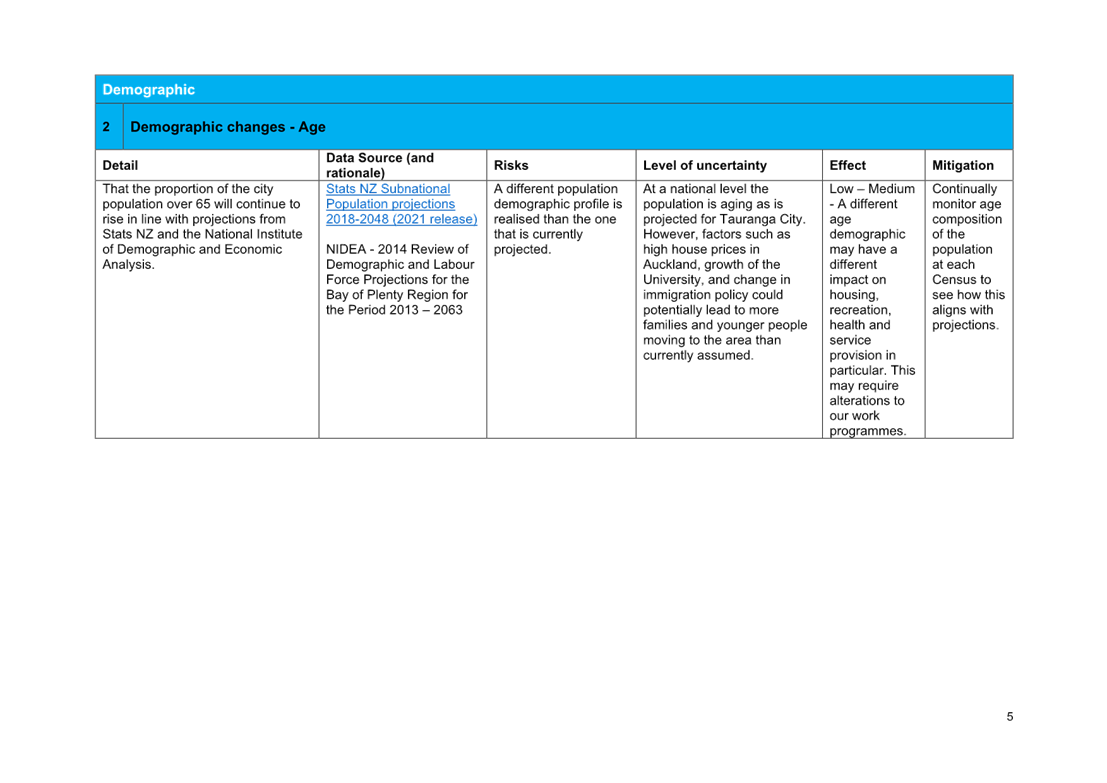







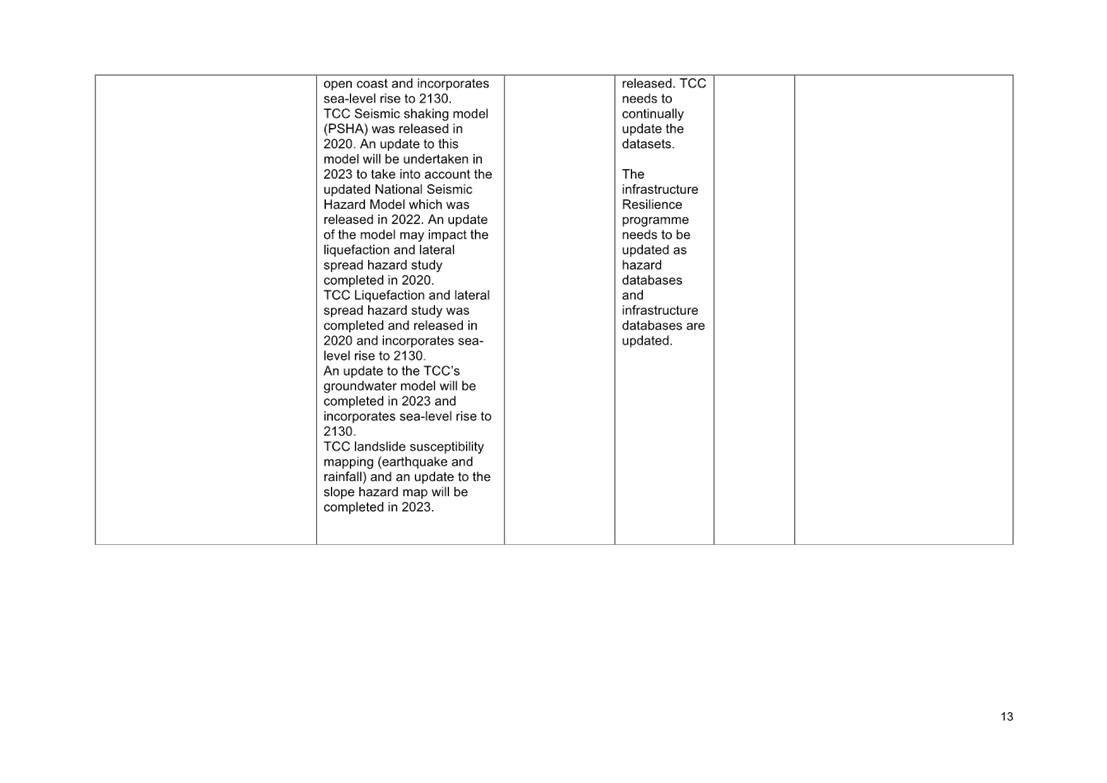

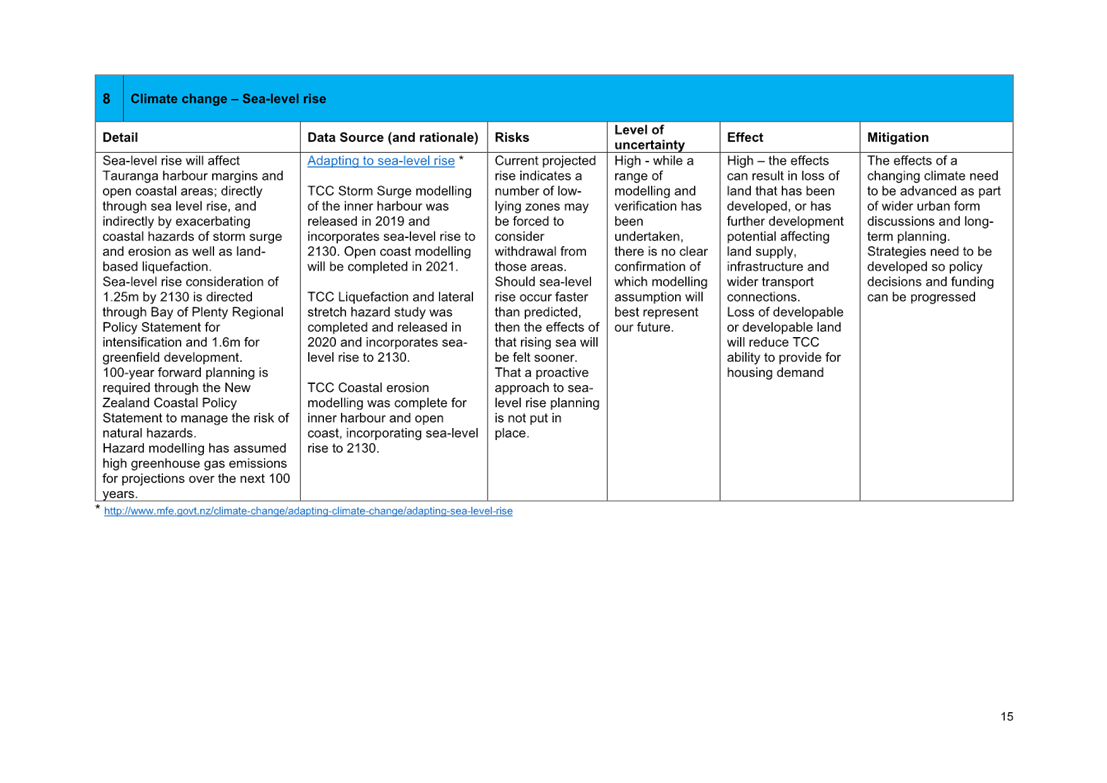
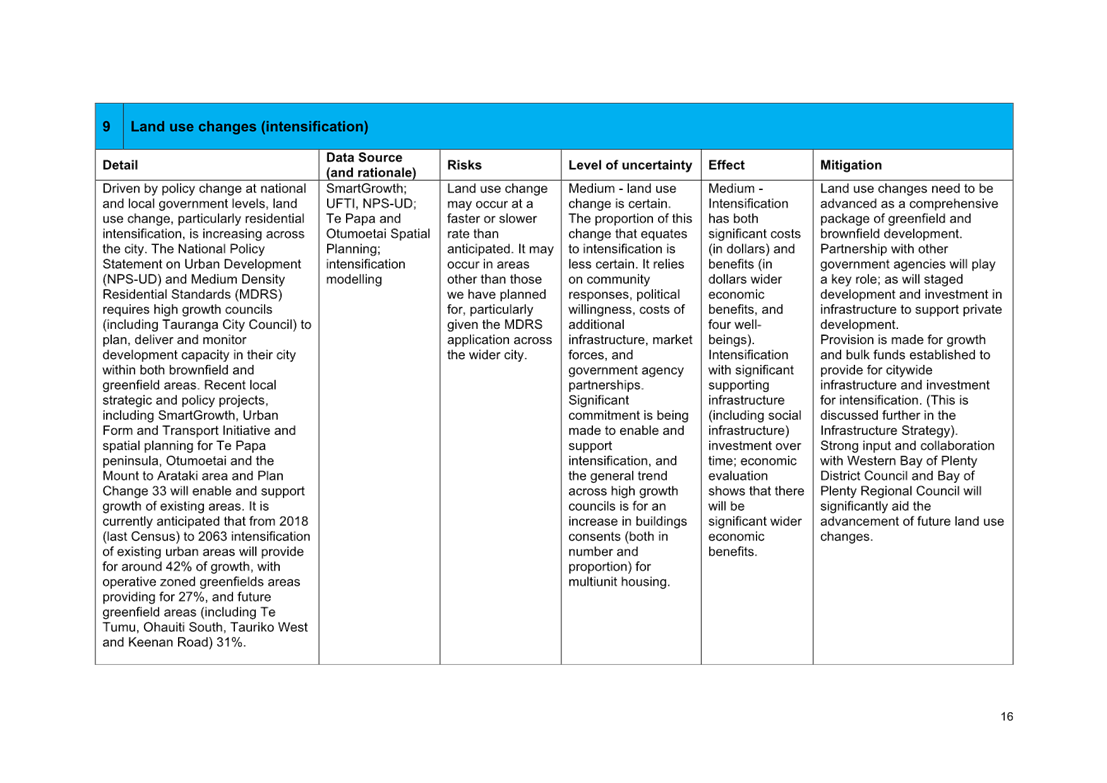
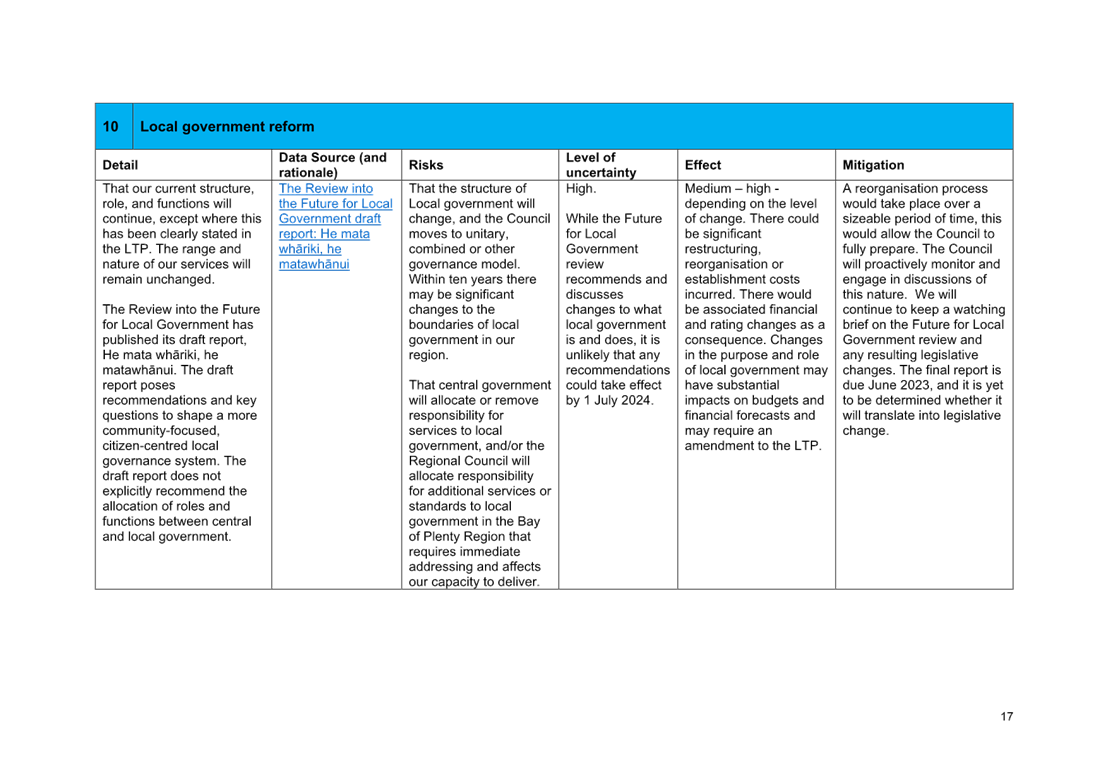




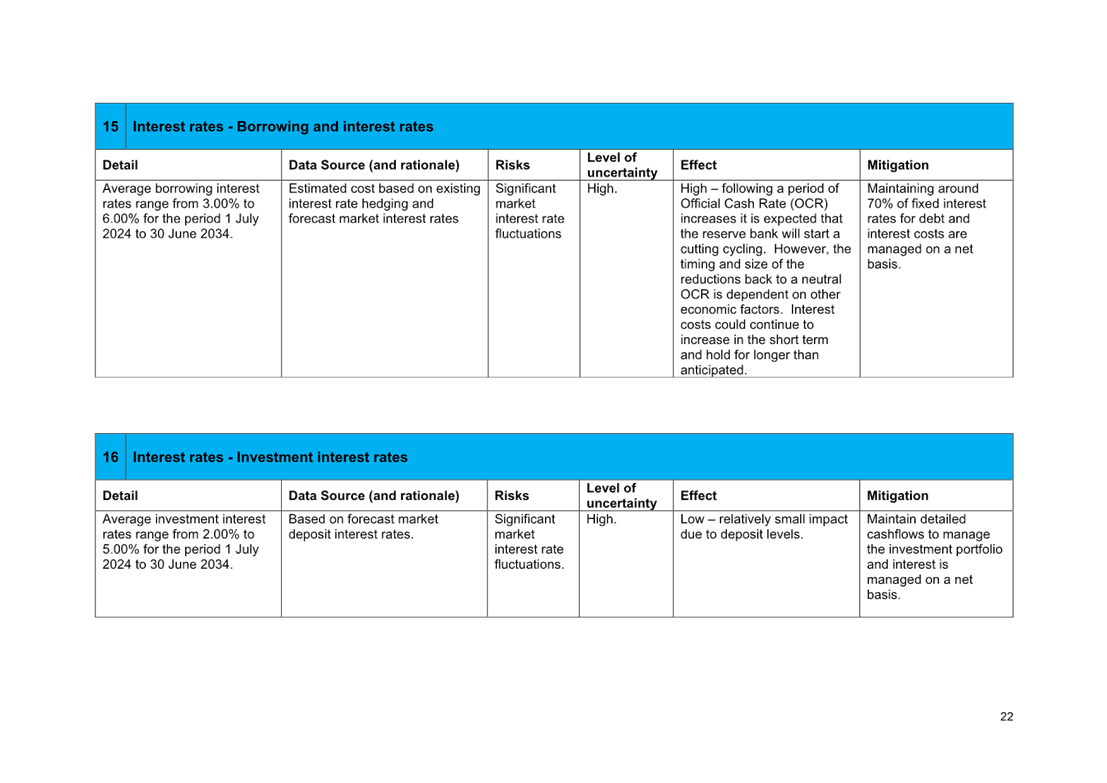
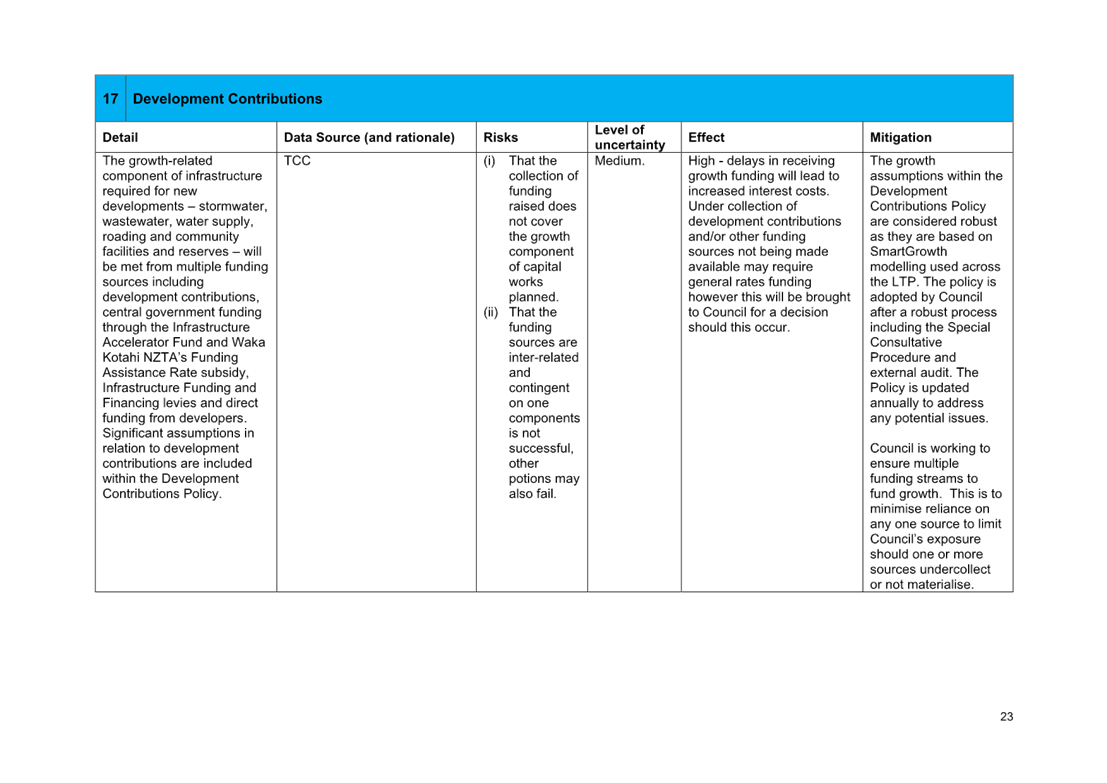
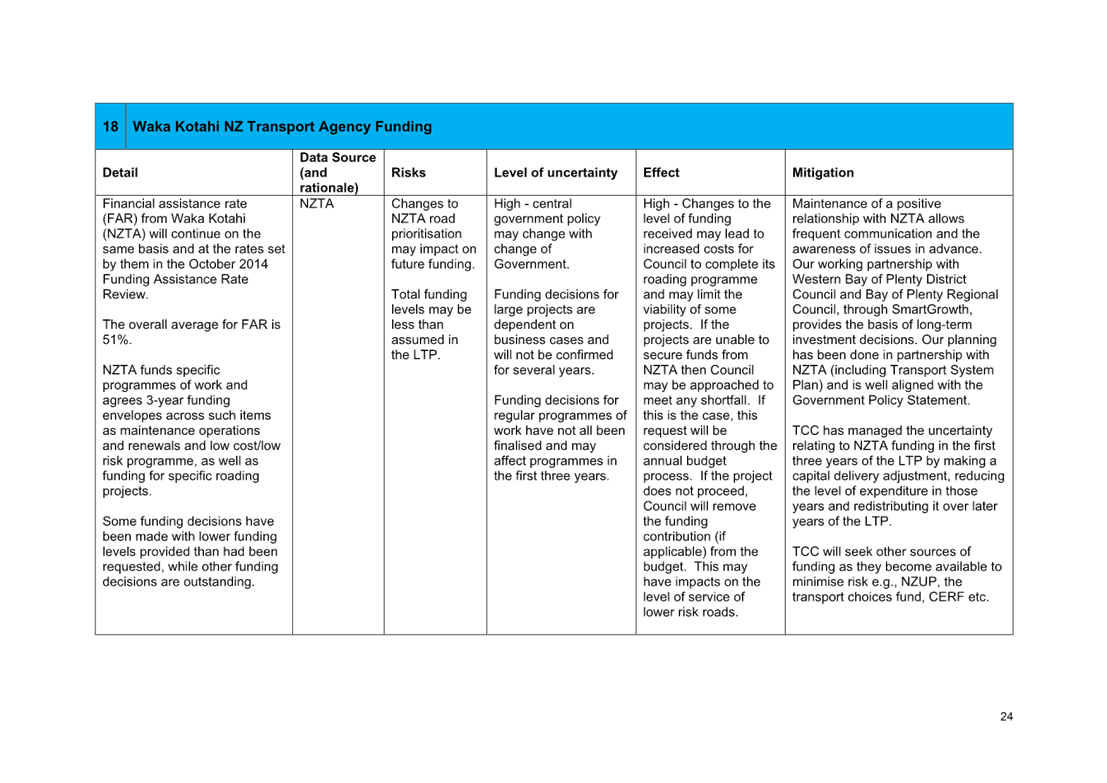

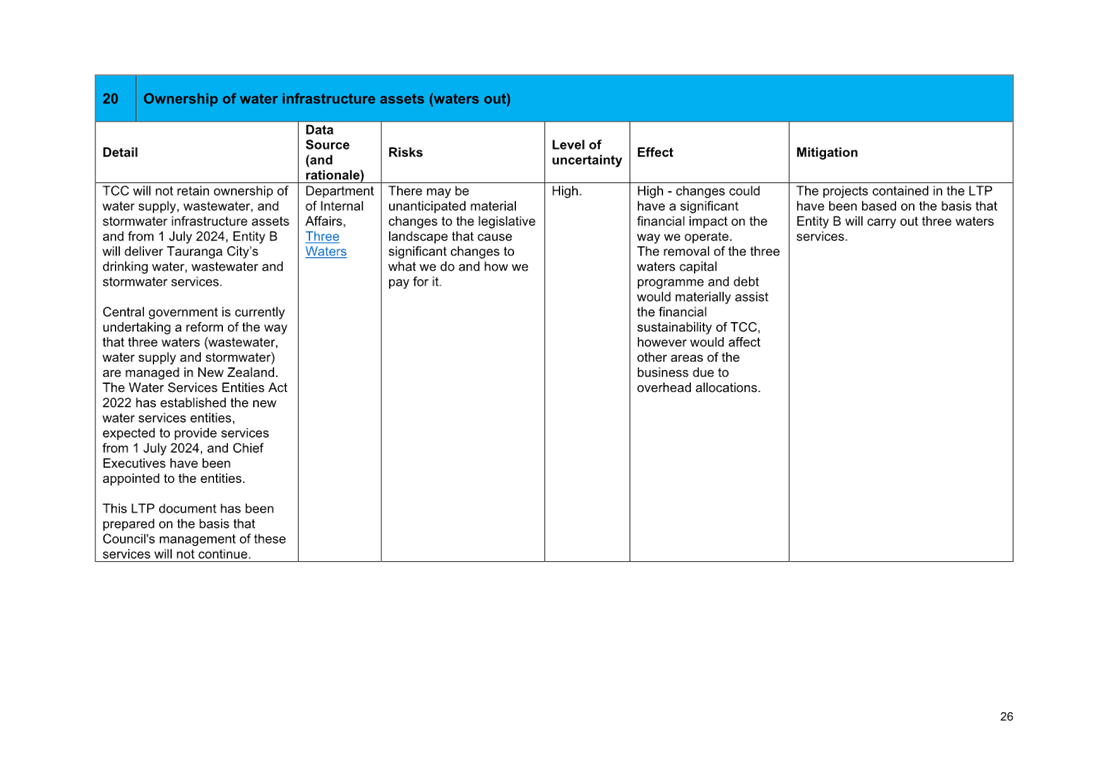
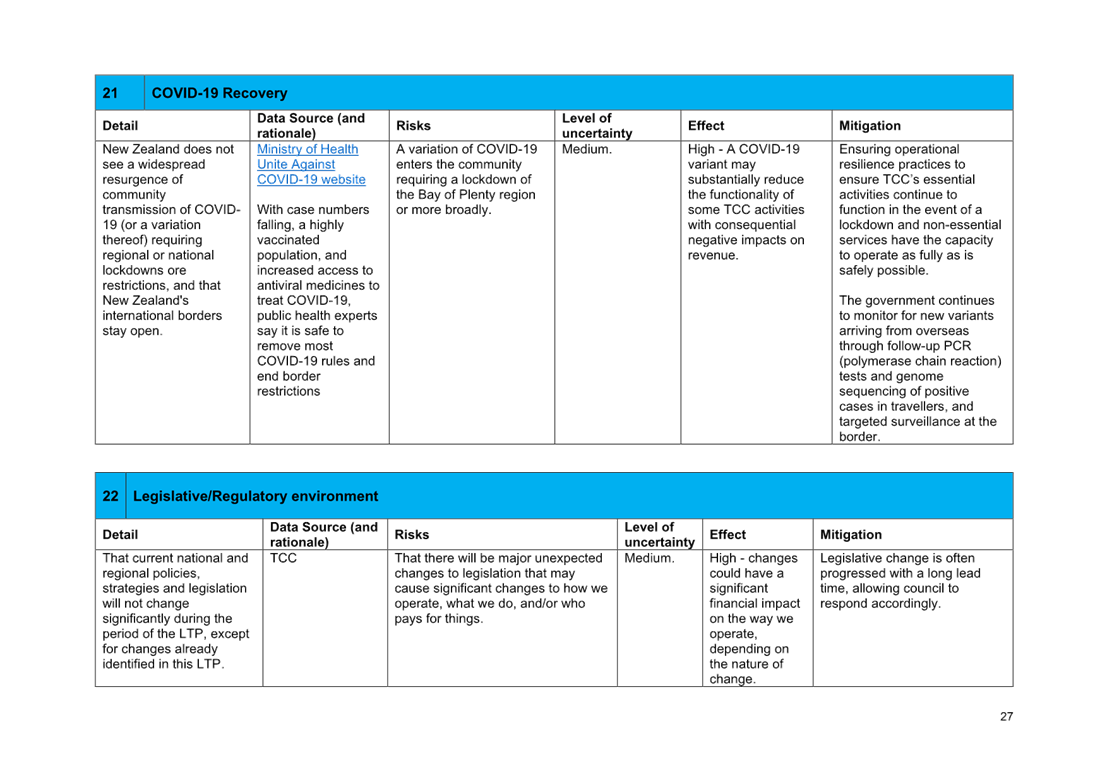
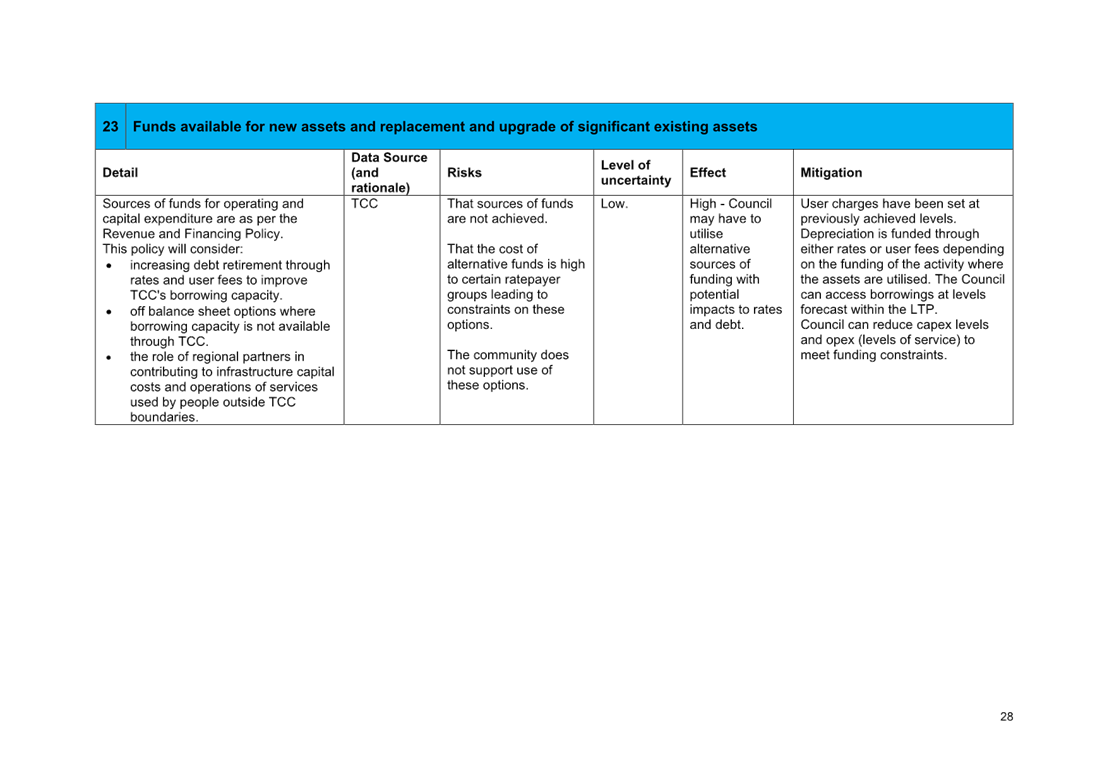
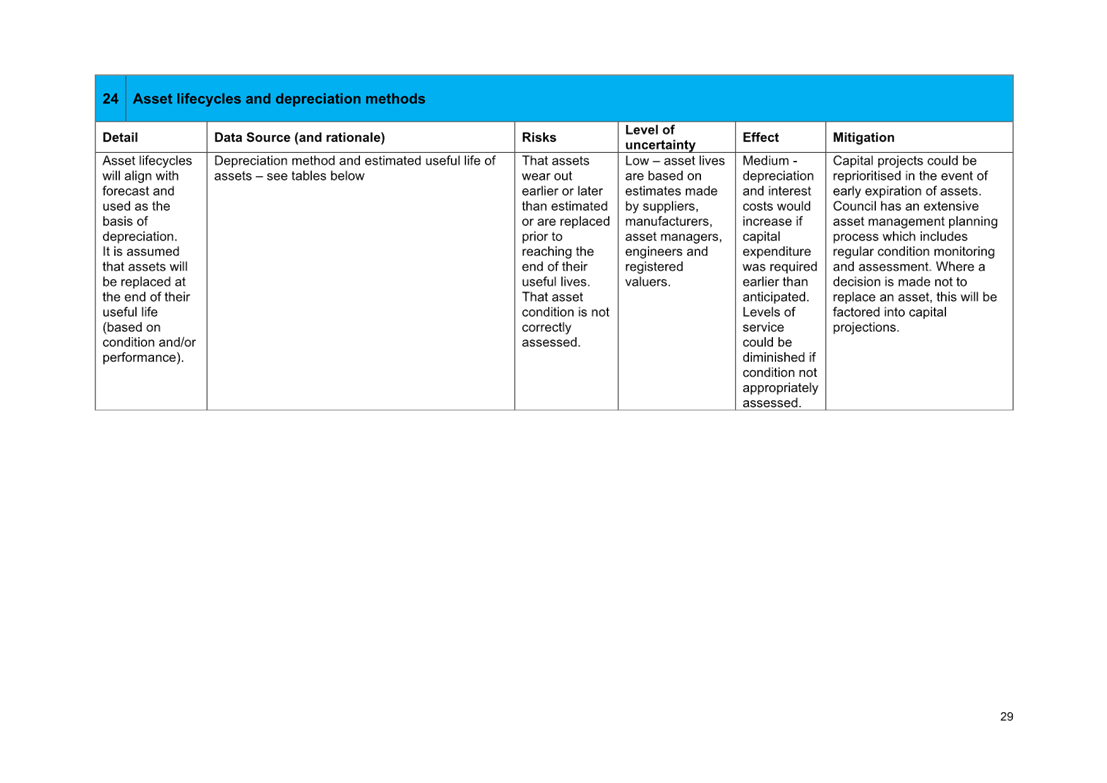
|
Ordinary
Council meeting Agenda
|
27
February 2023
|

|
Ordinary
Council meeting Agenda
|
27
February 2023
|
11.8 Existing
Use Rights in the Mount Maunganui Industrial Area
File
Number: A14412953
Author: Christine
Jones, General Manager: Strategy, Growth & Governance
Authoriser: Christine
Jones, General Manager: Strategy, Growth & Governance
Purpose of the Report
1. To report to Council on
matters associated with activities in the Mount Maunganui Industrial Area.
|
Recommendations
That the Council:
(a) Receives the report
"Existing Use Rights in the Mount Maunganui Industrial Area".
(b) Notes the legal advice
received, in particular that:
(i) Many industrial
activities in the Mount Maunganui Industrial Area have existing use rights.
(ii) Rezoning under the City Plan
could potentially constrain future activities but not activities that are
protected by existing use rights.
(iii) No feasible legal mechanism
open to the Tauranga City Council has been identified to compel existing
industry to relocate away from Whareroa Marae.
|
Executive
Summary
2. The Mount Maunganui
community have been concerned about impacts of heavy industry for some time.
The scoping report into the managed retreat of industry surrounding Whareroa
marae has not progressed, and our legal advice has shown there is no legal
mechanism to extinguish existing use rights. We can however manage future land
use in a different way.
Background
3. Significant concerns about
the impact of heavy industry on residents and other users of the Mount
Maunganui area generally and the Whareroa marae community specifically (and
associated buildings and uses) have been expressed over a number of
years. Impacts the community have been concerned about include
contaminants in the air and water, as well as hazards, noise and amenity
4. In late 2019 the Mount
Maunganui Airshed was declared a polluted airshed. Regulation 17 of the
National Environmental Standards for Air Quality (NESAQ) requires consent
authorities to decline resource consents for new discharges into polluted
airsheds. This effectively limits new, changed or increased
industrial activity which will result in certain pollution discharges.
5. In June 2020, following a
presentation by representatives of Whareroa marae hau kainga, the Tauranga
Moana Advisory Group (TMAG) recommended:
“the
urgent development of an Action Plan in collaboration with Whareroa marae hau
kainga and as a first step: commission an independent, comprehensive report to
investigate the potential for instigating a managed retreat of pollutant
industries from the Totara Rd site south of Hewletts Road and report back to
this committee when completed.”
6. Advice was sought by TCC
and BOPRC jointly, to ascertain how the TMAG recommendation could be
progressed. Paul Beverley, Partner at Buddle Findlay was approached as he
specialises in resource management planning and consenting, Māori Law and
Treaty Settlement negotiations.
7. Mr Beverley has provided
advice that:
· It
was appropriate that an action plan be developed in collaboration with Whareroa
marae hau kainga
· The
process be commenced by developing a scoping and issues report, in
collaboration with Whareroa marae hau kainga, which might then be followed up
by a more comprehensive report.
8. On 6 August 2020 the Bay
of Plenty Regional Council (BOPRC) considered the matter and resolved that:
a) “With
agreement and in collaboration with Whareroa Marae hau kainga, and TCC, the
initial scoping report commences as recommended by consultant
b) Staff
report back to Council once the initial scoping report is finalised.
9. On 11 August 2020 TCC also
considered the matter and resolved as follows:
a) …
authorises a high-level investigation of potential pathways to achieve:
i) Managed
retreat of existing heavy and/or hazardous industry in the area surrounding
Whareroa Marae;
ii) Limitation
of new future heavy and/or hazardous or high polluting industry in the Mount
area.
b) That
the pathway options to reduce the harmful effects being experienced by the
people of Whareroa Marae be presented as immediate, short-term, medium-term and
long-term initiatives
c) Confirms
that this report be released to the public on approval of the Chief Executive.
10. In March 2022 an update was provided
to the TMAG which noted the following points:
· Process
was ongoing with Paul Beverly engaging closely with the Marae Committee in a
facilitation role alongside Phil Mitchell from Mitchell Daysh Planning
Consultancy.
· It
was critical that the work was conducted collaboratively with the Whareroa
Marae hau kainga in order to identify an appropriate way to address the issues
· Needed
to move at a pace at which the marae community felt comfortable with, and
critical that the marae community took a leading role on the way forward and
identifying their next steps
· Acknowledged
that the marae community had limited resources which impacted the pace of
moving forward
· The
marae had internal processes underway – wananga by whanau was
ongoing. A lot of mahi was ongoing.
· Looking
at examples, lesson learnt by others/best practices/historical costs to guide
and inform the next steps.
11. While the work of Paul Beverly and
Phil Mitchell has not been brought to a formal conclusion, there is currently
no active work underway.
12. The Mount Air Quality Working Party
facilitated by BOPRC continue to meet quarterly and report to the Tauranga Moana
Advisory Group. The most recent working party meeting on 22 February the key
findings of the interim decision of the Environment Court on Plan Change 13 to
the Regional Natural Resources Plan. It is
expected that at a future meeting there will be a presentation on a health
impact study commissioned by Toi Te Ora.
13. BOPRC has responsibilities for
managing environmental impacts and has the ability to do this through a range
of mechanism including through the Regional Natural Resources Plan, enforcement
of existing consent requirements, possible review of consent conditions under
s.128 RMA, monitoring and non-regulatory approaches (including education).
Recent
related Matters
Regional Plan Change (PC) 13 (Air Quality)
14. In response to concern around dust,
pollution, and odour issues BOPRC progressed PC13 with notification in late
February 2018. 80 submissions and 30 further submissions were
received. Hearings were held in October 2018 and decisions were related
on 12 March 2019. Ten appeals were lodged with the Environment Court.
15. The Environment Court has recently
issued an interim decision for PC13 in relation to the rule which requires
resource consent for handling of bulk solid material and logs.
Previously, these were permitted activities and as such they have not held a
resource consent and are therefore considered new activities.
16. The Court has heard extensive
evidence and issued its interim decision. In summary:
· Bulk solid
material handling and log handling will be permitted activities for a
three-year interim period – managed according to an interim permitted
activity rule (IPAR)
· Following the IPAR
period, the activities will become restricted discretionary activities and will
require resource consent. Prior to this, if parties apply for and are granted a
Certificate of Compliance, Regulation 17 will not apply
· The Court will
direct the Regional Council to introduce provisions to manage unsealed yards in
the MMA using the section 293 process of the Resource Management Act\
17. The Court has requested parties to
the appeal to submit comments on specific matters and these are due to be filed
with the Court at the end of March 2023.
Mount Planning and Delivery Programme including
Spatial Plan
18. There are currently over thirty
Council-led projects of varying scale planned or underway for the Mount
Maunganui area (including Bayfair, Omanu, Whareroa and the Mount industrial
area) over the next 12 months and beyond. These projects were reported to
the 5 December 2022 Strategy Finance and Risk Committee.
19. One of the key projects is the Mount
Maunganui Spatial Plan. This will be a 30-year blueprint providing
strategic direction for existing and future growth needs of the area.
Mount Industrial Planning Project
20. The Mount Industrial Planning Project
is being prepared at the same time as the Mount Spatial Plan. The purpose of
the industrial study is looking to plan for the future of the industrial area
and identify a programme of actions, which considers current issues and the
needs of all stakeholders. Those issues include future land use, cultural and
social impacts, natural hazards, air quality, transportation and economic
growth. An integrated approach is being taken to the two projects, particularly
in relation to engagement with mana whenua and key stakeholders.
21. The project will explore the
mechanisms to manage future industrial land use. There will be a focus on
what can be done to achieve the aspirations of Whareroa marae hau kainga, mana
whenua and the wider community in the future and how a move away from heavy
industry can be achieved over time.
22. The first Reference Group meeting
with the project partners is scheduled for Monday 20 February with a second
workshop on 28 February. A general stakeholder workshop with industrial
stakeholders is being held on 7 March.
23. A baseline analysis report is
currently being prepared which will collate what information is known for the
industrial area. This will cover matters such as natural hazards,
transport, infrastructure, air quality etc.
24. It is likely that the Mount
Industrial Planning Project will explore a range of scenarios together with
possible interventions / actions for each of those scenarios. This will
be focused on addressing future development rather than existing activities and
land uses.
Legal
Advice on Mount Maunganui Industrial Area Existing Use Rights
25. As part of the work for the both the
Mount Spatial Plan and the Mount Industrial Planning Project TCC sought legal
advice to understand the rights and ability to change existing land use
activities (refer attachment 1).
26. The key points of the legal advice
are:
(a) It would be reasonable to
assume that a considerable proportion of existing uses will meet the tests to
be protected by existing use rights under S10 of the RMA.
(b) Existing use rights under S10
cannot be terminated through a change to a District Plan.
(c) Existing use rights may be
overridden through a change to the Regional Plan, provided the changes are for
the purposes in s30(1)(c) RMA, which relate to soil conservation, water,
ecosystems, and natural hazards.
(d) Rezoning under the City Plan
could potentially constrain future activities but not activities that are
protected by existing use rights.
(e) As currently drafted the
Natural and Build Environment Bill would not provide a mechanism to override
existing use rights at the Mount Maunganui industrial area unless provided in a
district rule which gives effect to the national planning framework.
There are uncertainties as to whether the Bill will give any new options for
Council and in particular how the national planning framework will apply.
(f) Not aware of any feasible
legal mechanism open to Tauranga City Council to compel industry to relocate
away from Whareroa Marae.
Significance
27. The Local Government Act 2002
requires an assessment of the significance of matters, issues, proposals and
decisions in this report against Council’s Significance and Engagement
Policy. Council acknowledges that in some instances a matter, issue,
proposal or decision may have a high degree of importance to individuals,
groups, or agencies affected by the report.
28. In making this assessment,
consideration has been given to the likely impact, and likely consequences for:
(a) the current
and future social, economic, environmental, or cultural well-being of the
district or region
(b) any persons who are likely to be
particularly affected by, or interested in, the decision.
(c) the capacity of the local authority to
perform its role, and the financial and other costs of doing so.
29. In accordance with the considerations
above, criteria and thresholds in the policy, it is considered that the issue
is of medium significance. The decision to receive the report is
considered to be of low significance as it is information not an action
decision.
ENGAGEMENT
30. Taking into consideration the above
assessment, that the decision is of low significance, officers are of the
opinion that no further engagement is required prior to Council making a
decision. Engagement is being undertaken with respect to the Mount
Spatial Plan and the Mount Industrial Planning Project.
31. TCC has advised Whareroa Marae
representatives, Ngai te Rangi and BOPRC of this report and attachments prior
to the meeting being held.
Next steps
32. Through the Mount Spatial Plan and
associated Mount Industrial Planning project, we will explore the future land
use options for the area and the ways in which these can be achieved.
Attachments
1. Legal
Opinion Mount Maunganui Industrial Area Existing Use Rights - A14412043 ⇩ 
|
Ordinary
Council meeting Agenda
|
27
February 2023
|
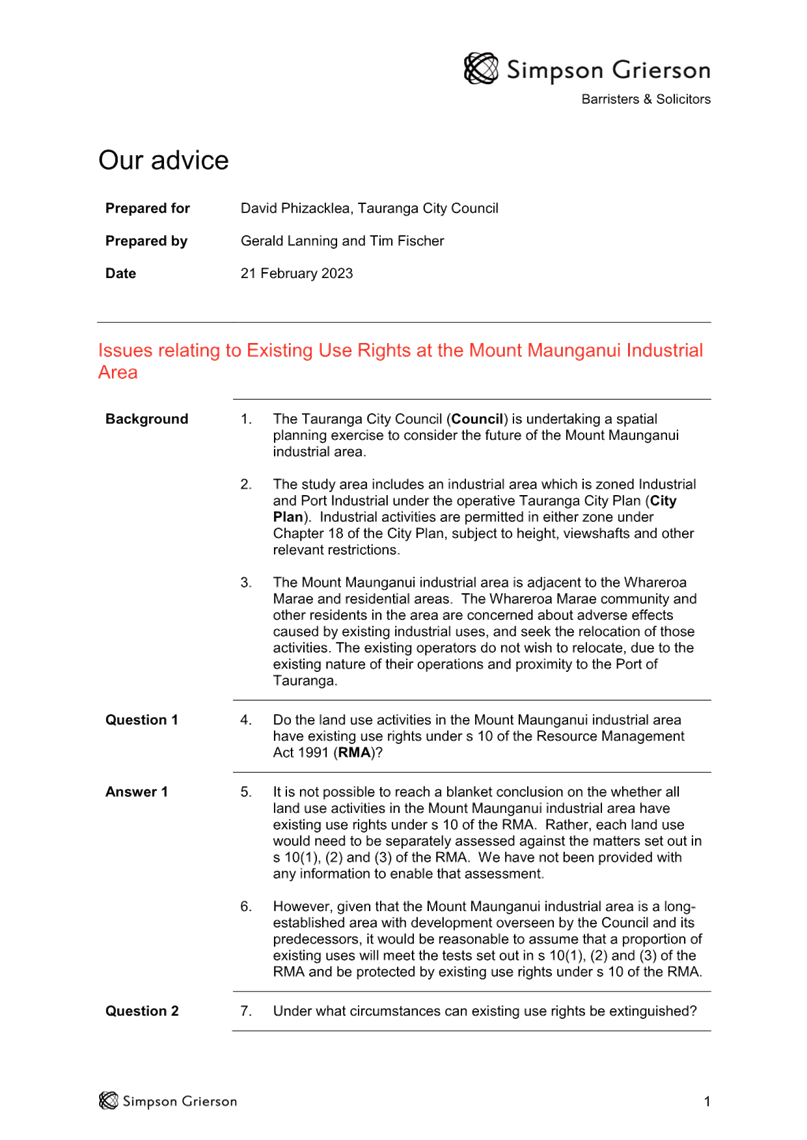

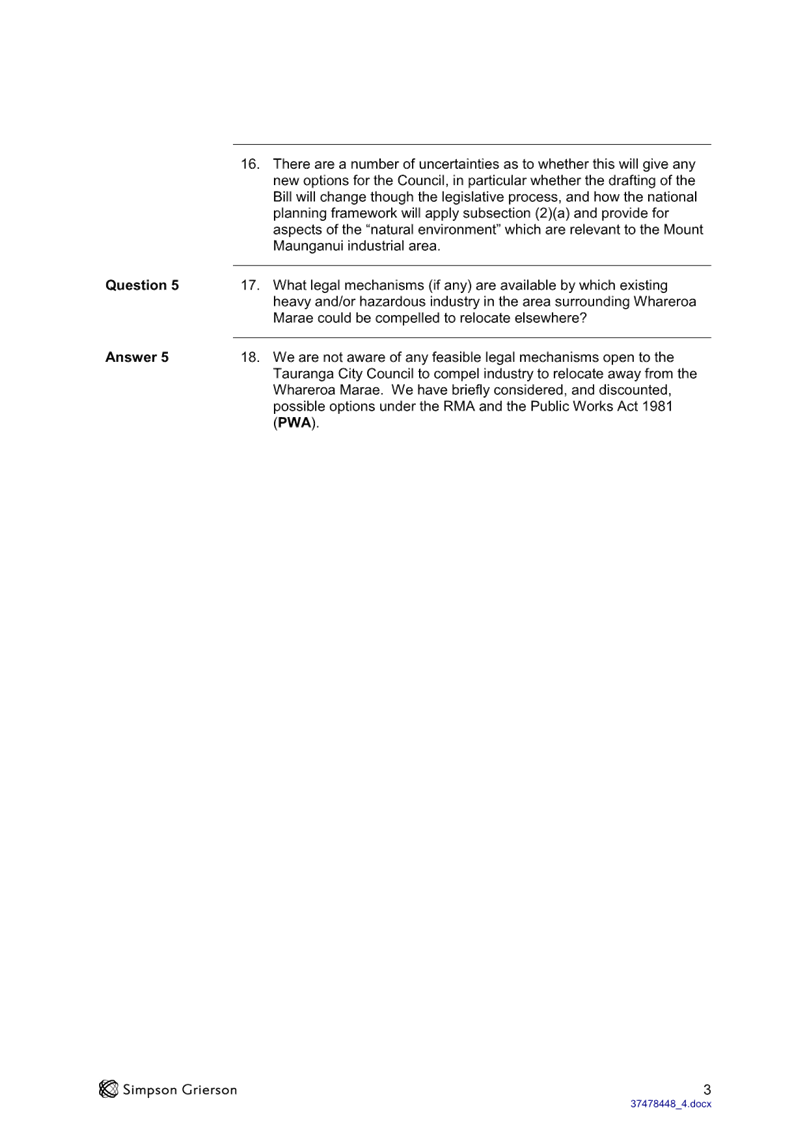
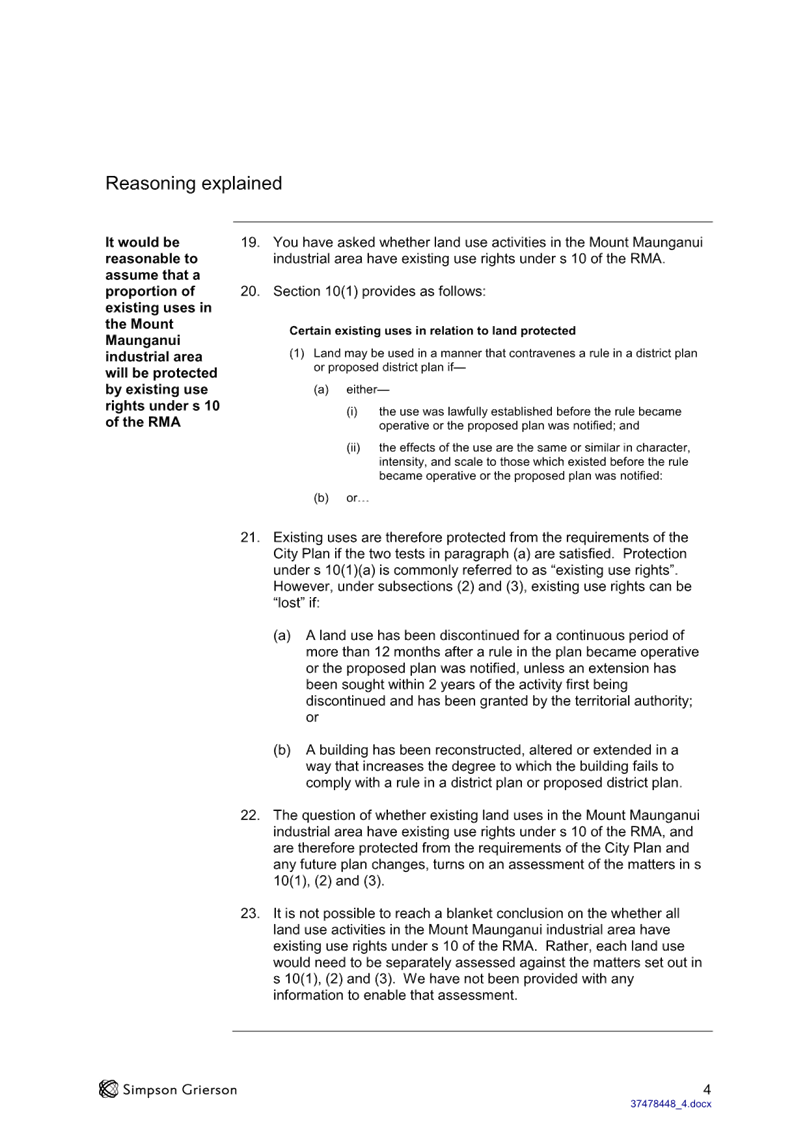
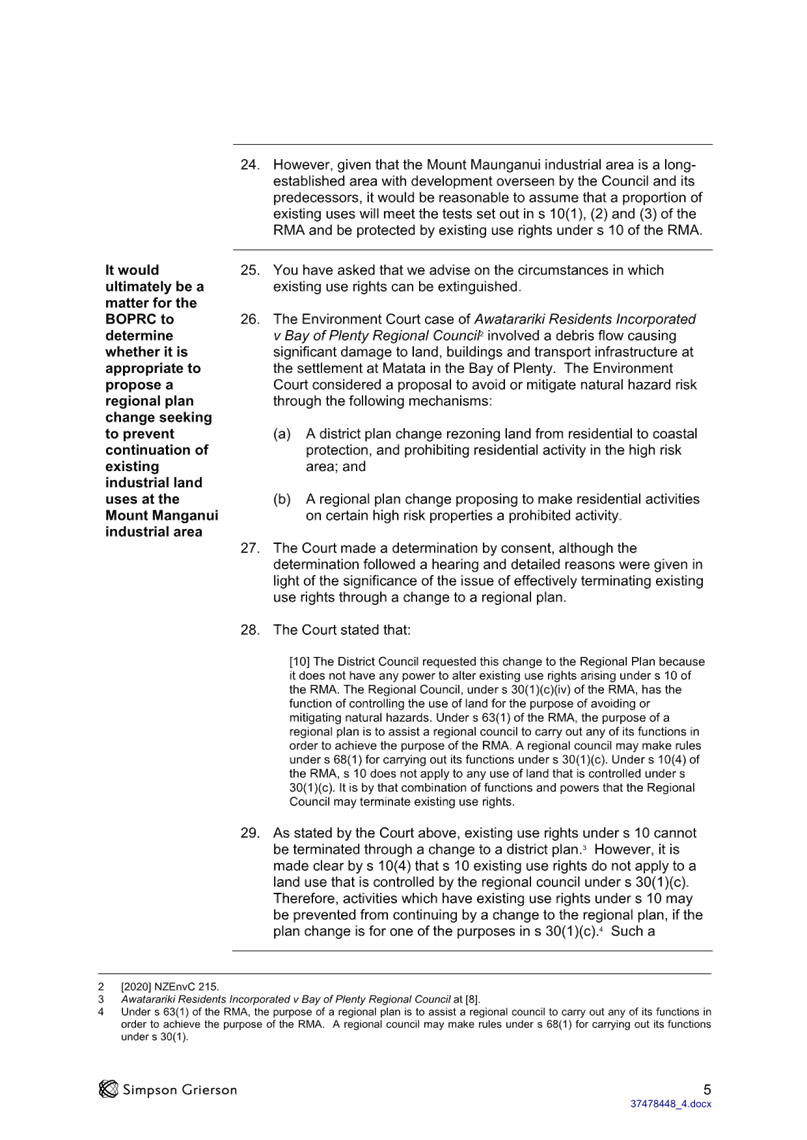
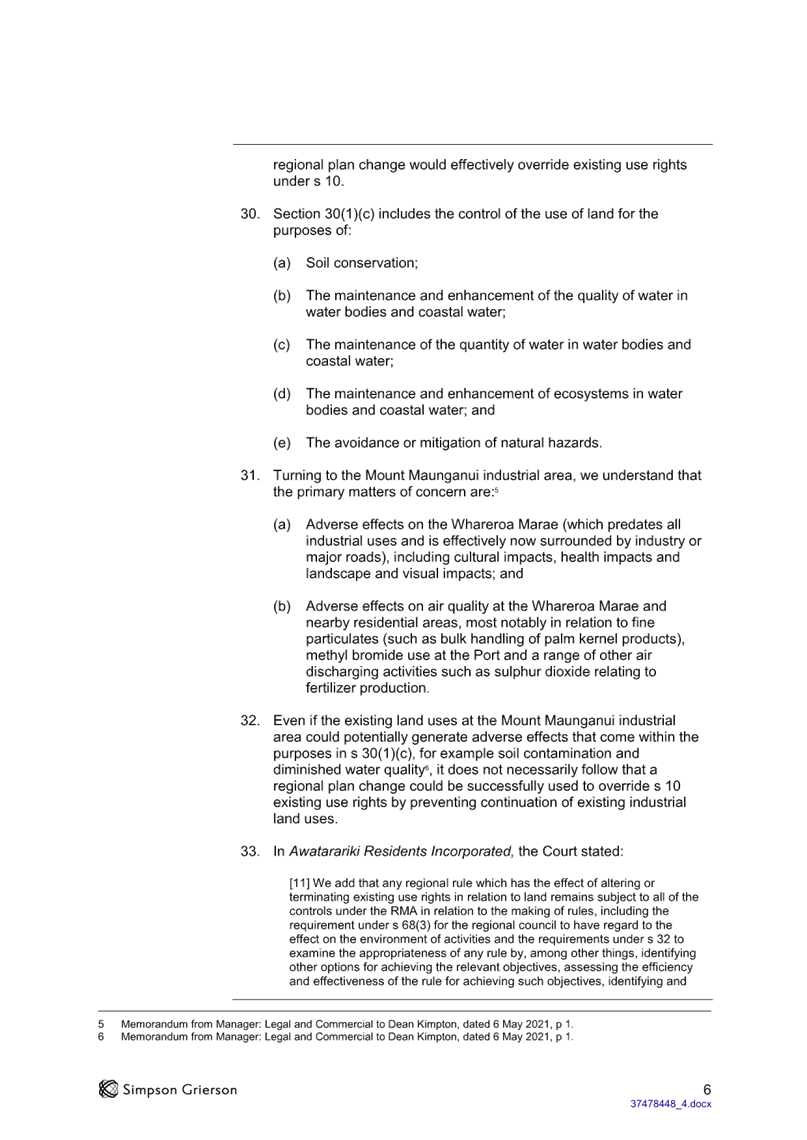
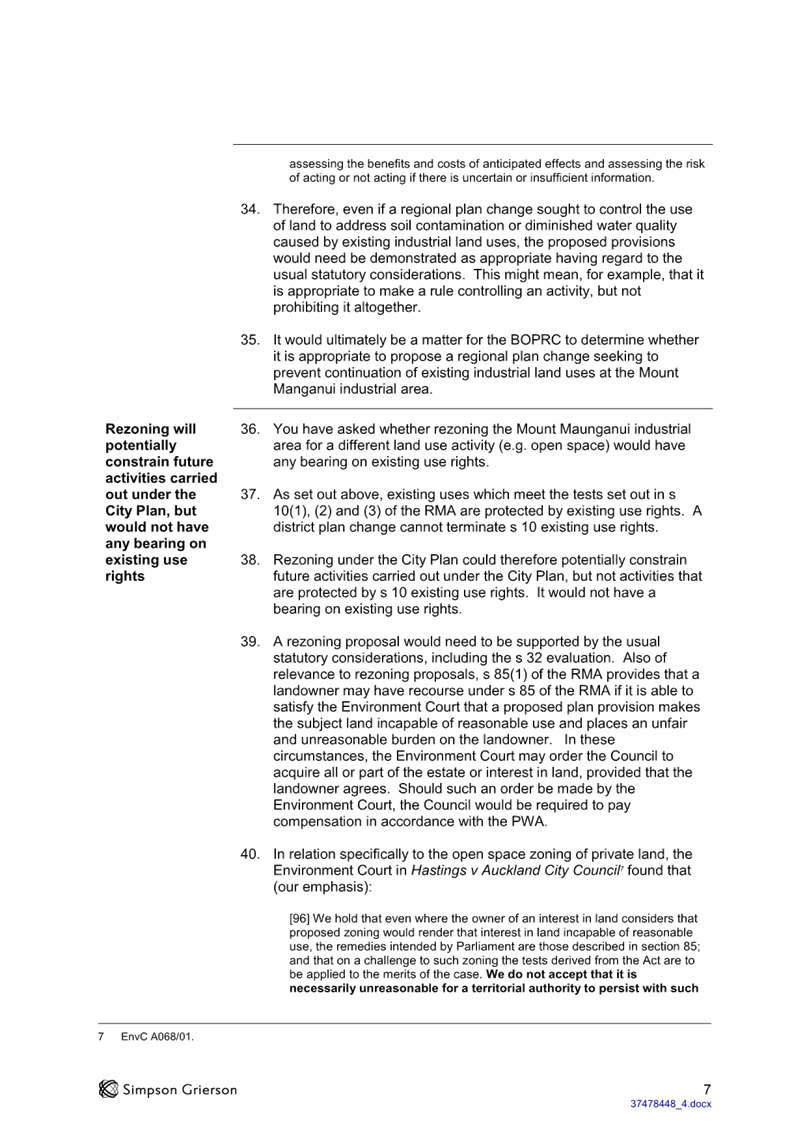
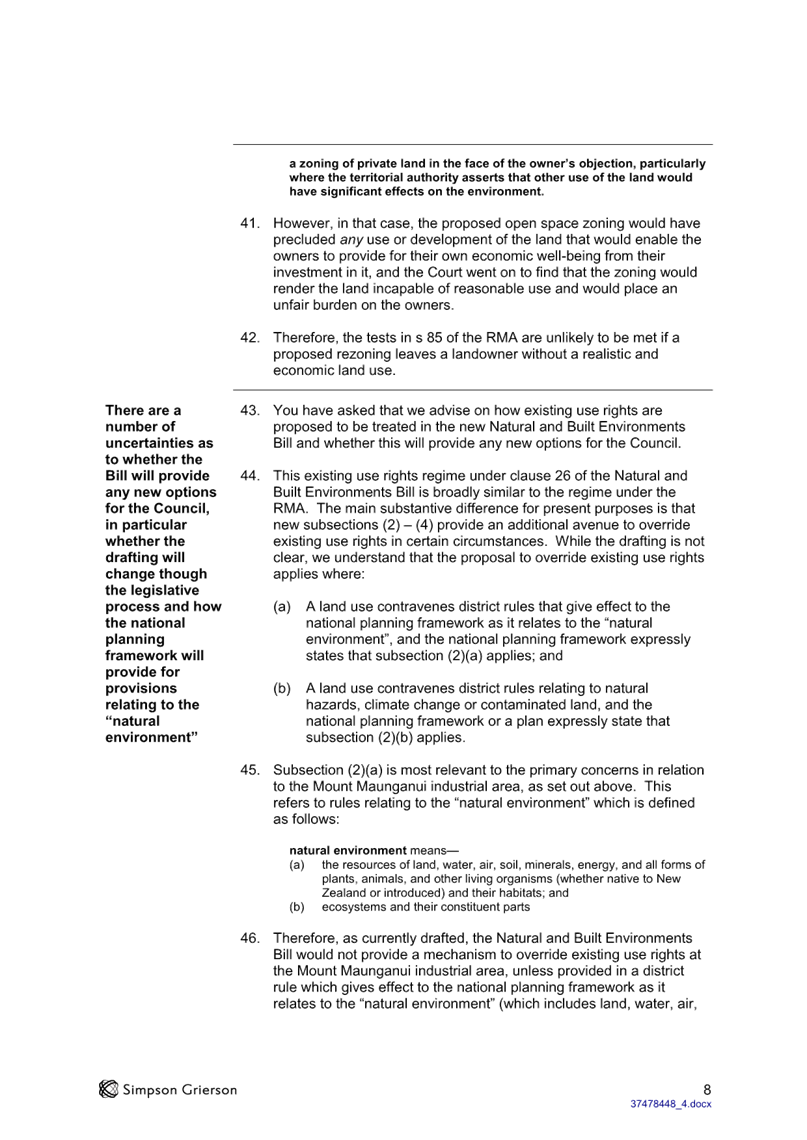
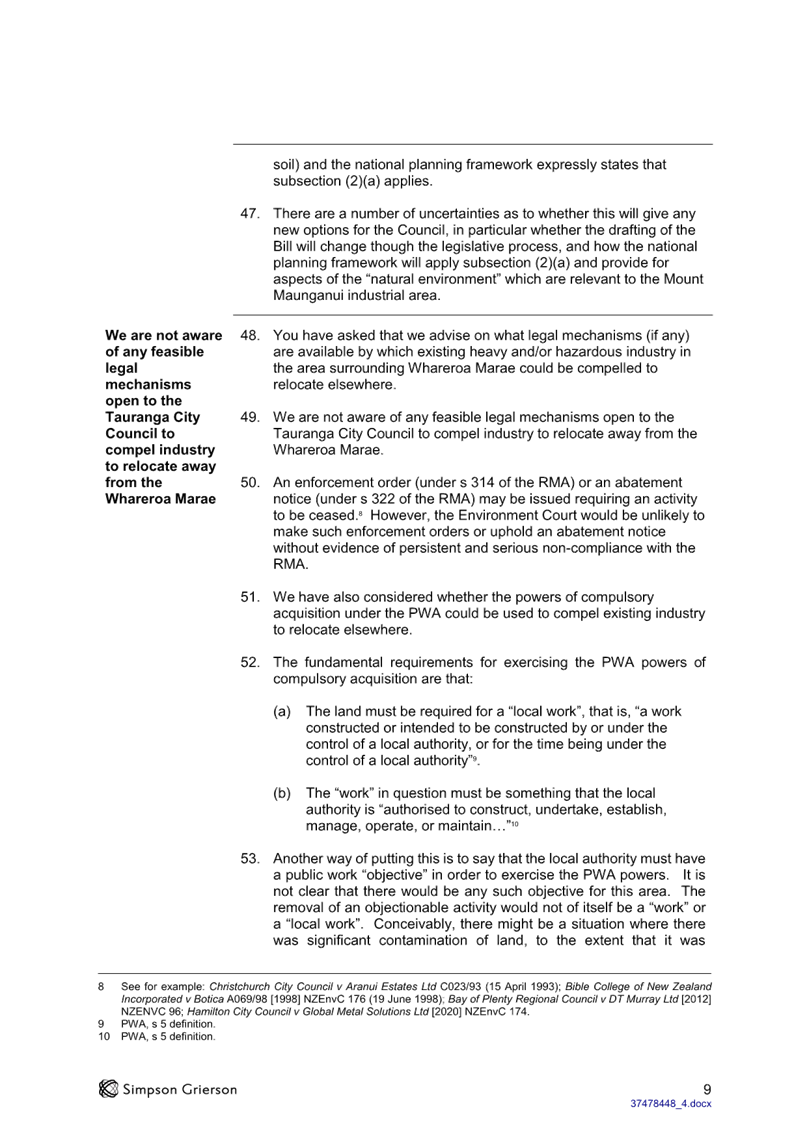
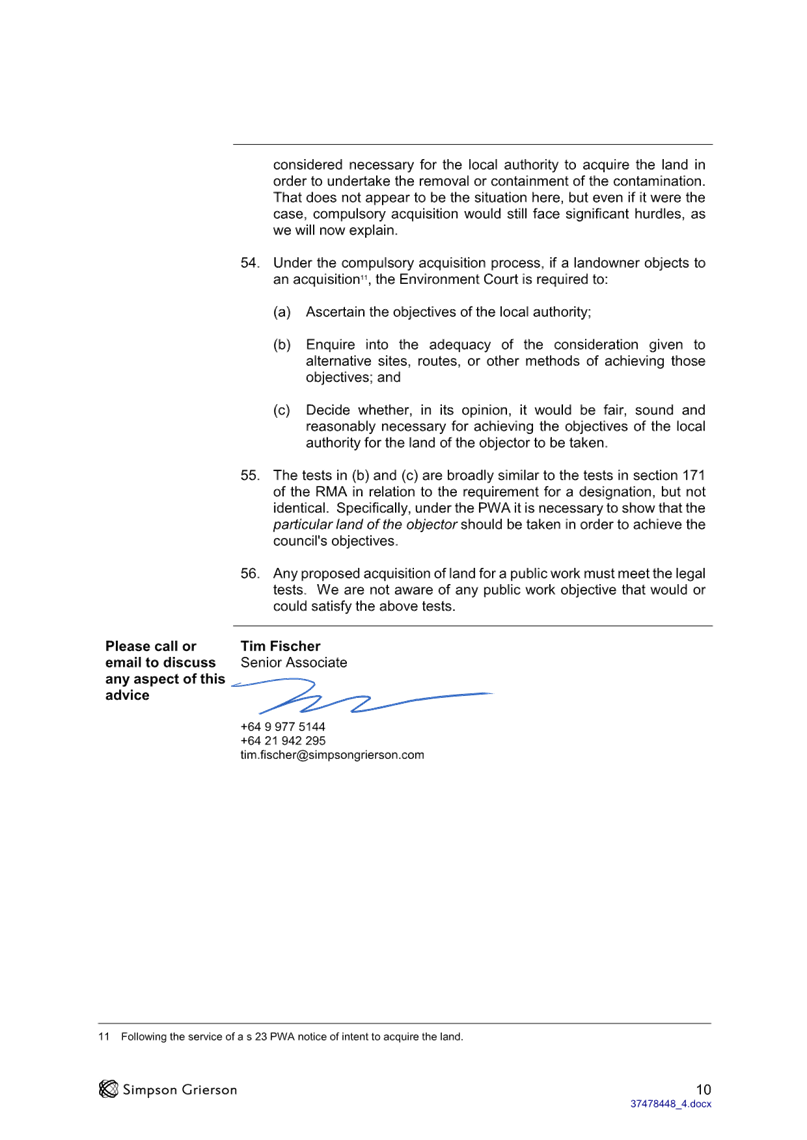
|
Ordinary
Council meeting Agenda
|
27
February 2023
|
11.9 Project
delivery update - verbal report
File
Number: A14426808
Author: James
Woodward, Manager: Capital Programme Assurance
Authoriser: Nic
Johansson, General Manager: Infrastructure
Purpose of the Report
1. This verbal update will
provide an update of progress from the last quarter including performance
against Quarter 2 milestones, programme wide risks/issues and how they are
being mitigated, and opportunities recognised and actions underway.
|
Recommendations
That the Council:
(a) Receives the report "Project
delivery update - verbal report".
|
Attachments
Nil
|
Ordinary
Council meeting Agenda
|
27
February 2023
|
12 Discussion
of late items
13 Public
excluded session
RESOLUTION TO EXCLUDE
THE PUBLIC
|
Recommendations
That the public be
excluded from the following parts of the proceedings of this meeting.
The general subject
matter of each matter to be considered while the public is excluded, the
reason for passing this resolution in relation to each matter, and the
specific grounds under section 48 of the Local Government Official
Information and Meetings Act 1987 for the passing of this resolution are as
follows:
|
General subject of each matter to be
considered
|
Reason for passing this resolution in
relation to each matter
|
Ground(s) under section 48 for the
passing of this resolution
|
|
13.1 - Public Excluded Minutes of the
Council meeting held on 7 February 2023
|
s7(2)(a) - The withholding of the information is
necessary to protect the privacy of natural persons, including that of
deceased natural persons
s7(2)(b)(ii) - The withholding of the information
is necessary to protect information where the making available of the
information would be likely unreasonably to prejudice the commercial
position of the person who supplied or who is the subject of the
information
s7(2)(i) - The withholding of the information is
necessary to enable Council to carry on, without prejudice or disadvantage,
negotiations (including commercial and industrial negotiations)
|
s48(1)(a) - the public conduct of the relevant
part of the proceedings of the meeting would be likely to result in the
disclosure of information for which good reason for withholding would exist
under section 6 or section 7
|
|
13.2 - Tauriko Public Transport
Facility
|
s7(2)(g) - The withholding of the information is
necessary to maintain legal professional privilege
s7(2)(h) - The withholding of the information is
necessary to enable Council to carry out, without prejudice or
disadvantage, commercial activities
s7(2)(i) - The withholding of the information is
necessary to enable Council to carry on, without prejudice or disadvantage,
negotiations (including commercial and industrial negotiations)
|
s48(1)(a) - the public conduct of the relevant
part of the proceedings of the meeting would be likely to result in the
disclosure of information for which good reason for withholding would exist
under section 6 or section 7
|
|
13.3 - Exemption from Open Competition
- Biosolids refuse disposal
|
s7(2)(h) - The withholding of the information is
necessary to enable Council to carry out, without prejudice or
disadvantage, commercial activities
|
s48(1)(a) - the public conduct of the relevant
part of the proceedings of the meeting would be likely to result in the
disclosure of information for which good reason for withholding would exist
under section 6 or section 7
|
|
11.6 - Draft submission on Future for
Local Government draft report - Confidential Attachment 2
|
s7(2)(c)(i) - The withholding of the information
is necessary to protect information which is subject to an obligation of
confidence or which any person has been or could be compelled to provide
under the authority of any enactment, where the making available of the
information would be likely to prejudice the supply of similar information,
or information from the same source, and it is in the public interest that
such information should continue to be supplied
|
s48(1)(a) the public conduct of the relevant part
of the proceedings of the meeting would be likely to result in the
disclosure of information for which good reason for withholding would exist
under section 6 or section 7
|
|
14 Closing
karakia








































































































































































